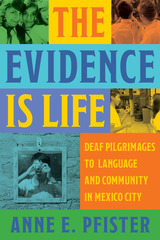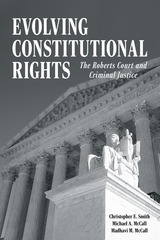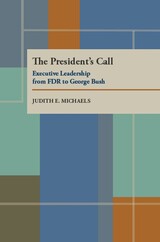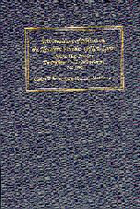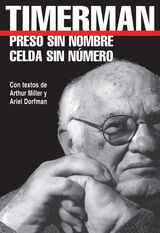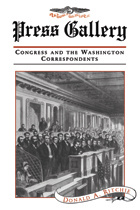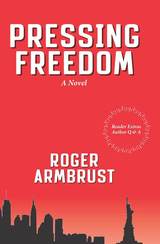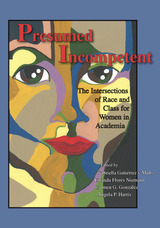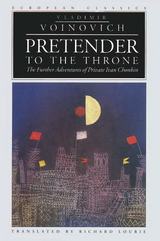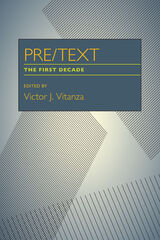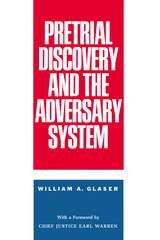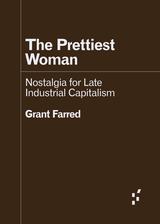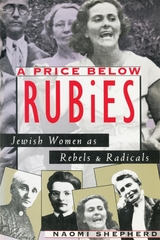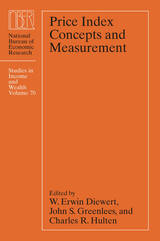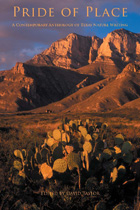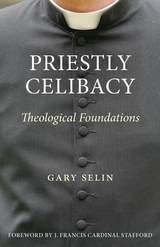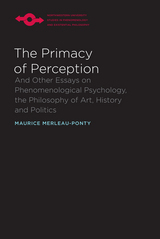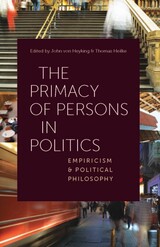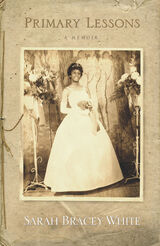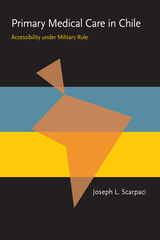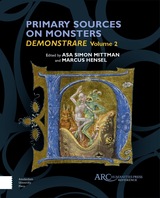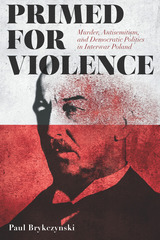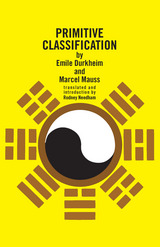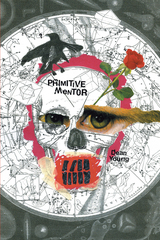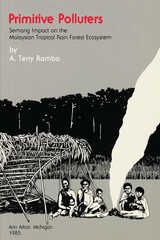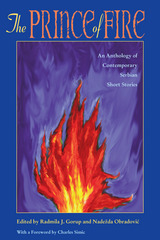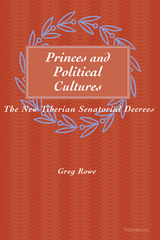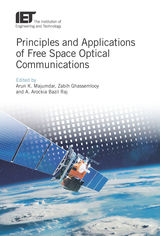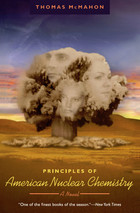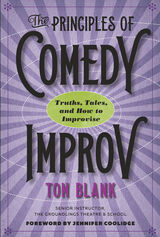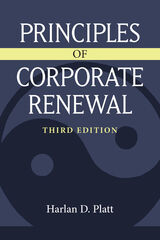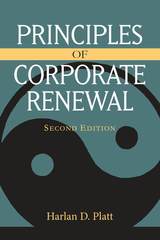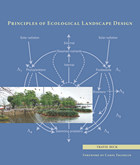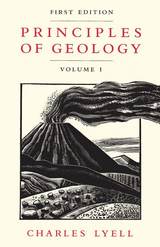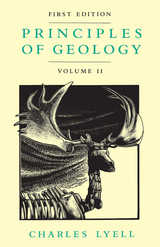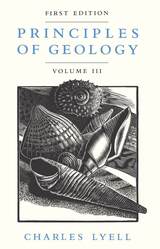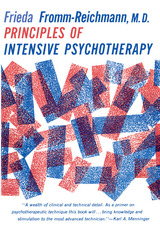The President’s Call: Executive Leadership from FDR to George Bush
Judith E. Michaels
University of Pittsburgh Press, 1997
Judith Michaels provides an in-depth examination of the Senate-confirmed presidential appointees of the Gorge H. W. Bush administration, and analyzes what these choices reveal about him, his administration, and the institution of political appointments itself. She compares this research to other administrations in the modern era. Particularly fascinating is how Bush's appointees compare with those of Ronald Reagan.
The President's Control of the Tariff
John Day Larkin
Harvard University Press Dealing with the tariff primarily from the point of view of public law and policy, this volume explains how the present process of administrative tariff adjustment has been gradually evolved from 1789 to the present; how it is possible for the Chief Executive to inject his own policy views into the flexible tariff; and how he may make a more complete revision of tariff rates, either up or down, than Congress usually does on one of its periodic revisions. The Supreme Court's approval of this enormous delegation of legislative power is shown to be in marked contrast to recent decisions in the so-called New Deal cases.
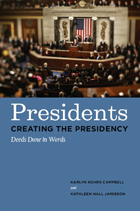 Presidents Creating the Presidency: Deeds Done in Words
Karlyn Kohrs Campbell and Kathleen Hall Jamieson
University of Chicago Press, 2008 Arguing that “the presidency” is not defined by the Constitution—which doesn’t use the term—but by what presidents say and how they say it, Deeds Done in Words has been the definitive book on presidential rhetoric for more than a decade. In Presidents Creating the Presidency, Karlyn Kohrs Campbell and Kathleen Hall Jamieson expand and recast their classic work for the YouTube era, revealing how our media-saturated age has transformed the ever-evolving rhetorical strategies that presidents use to increase and sustain the executive branch’s powers.
Identifying the primary genres of presidential oratory, Campbell and Jamieson add new analyses of signing statements and national eulogies to their explorations of inaugural addresses, veto messages, and war rhetoric, among other types. They explain that in some of these genres, such as farewell addresses intended to leave an individual legacy, the president acts alone; in others, such as State of the Union speeches that urge a legislative agenda, the executive solicits reaction from the other branches. Updating their coverage through the current administration, the authors contend that many of these rhetorical acts extend over time: George W. Bush’s post-September 11 statements, for example, culminated in a speech at the National Cathedral and became a touchstone for his subsequent address to Congress.
For two centuries, presidential discourse has both succeeded brilliantly and failed miserably at satisfying the demands of audience, occasion, and institution—and in the process, it has increased and depleted political capital by enhancing presidential authority or ceding it to the other branches. Illuminating the reasons behind each outcome, Campbell and Jamieson draw an authoritative picture of how presidents have used rhetoric to shape the presidency—and how they continue to re-create it.
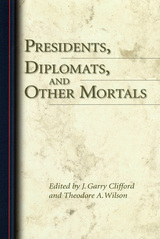 Presidents, Diplomats, and Other Mortals
Edited by J. Garry Clifford & Theodore A. Wilson
University of Missouri Press, 2007
From Abraham Lincoln’s stance on international slavery to George W. Bush’s incursions on the world stage, American presidents and other leaders have taken decisive actions to shape our country’s foreign policy. This new collection of essays provides analytical narratives of how and why policies were devised and implemented that would determine the place of the United States in the international arena from the 1860s to the present. Showing what individuals do—or choose not to do—is central to understanding diplomacy in peace and war.
These writings—by such prominent historians as Terry H. Anderson and Eugene P. Trani—examine presidents and other diplomats at their best and worst in the practice of statecraft. They take on issues ranging from America’s economic expansion abroad to the relations of democracies with authoritarian leaders and rogue nations to advocacy of such concepts as internationalism, unilateralism, nation building, and regime change. In so doing, they take readers on a virtual tour of American diplomatic history, tracing the ideas and actions of individuals in shaping our foreign policy, whether George F. Kennan as author of Soviet containment or Ronald Reagan as progenitor of “Star Wars.”
The essays range over a variety of scenarios to depict leaders coming to grips with real-world situations. They offer original views on such topics as American diplomacy toward Nicaragua, origins of U.S. attitudes toward Russia and the Soviet Union, FDR’s idiosyncratic approach to statecraft, and food diplomacy as practiced by LBJ and Richard Nixon. And in considering post–Cold War crises, they address Bill Clinton’s military interventions, George W. Bush’s war against Iraq, and the half-century background to the current nuclear standoff with Iran. Additional articles pay tribute to the outstanding career of Robert H. Ferrell as a scholar and teacher.
Throughout the volume, the authors seek to exemplify the scholarly standards of narrative diplomatic history espoused by Robert Ferrell—especially the notion that historians should attempt to explain fully the circumstances, opportunities, and pressures that influence foreign policy decisions while remembering that historical actors cannot with certainty predict the outcomes of their actions. Presidents, Diplomats, and Other Mortals is both a collection of compelling historical studies and an overarching case study of the role of individuals in foreign policy making and an insightful review of some of history’s most important moments. Taken together, these essays provide a fitting tribute to Ferrell, the trailblazing scholar in whose honor the book was written.
 The President's Echo System: How Foreign Policy Is Sold to Americans
Chad Levinson
Harvard University Press A sharp analysis of the propaganda partnerships between US presidents and private organizations that fueled the Cold War and paved the way for the War on Terror.
How do US presidents motivate public support for their foreign policy agendas, which so often start out running counter to public opinion? The President’s Echo System details how successive administrations have collaborated with outside groups to popularize ideas that voters initially reject. Chad Levinson shows how these collaborations have shaped all of the most consequential US foreign policy programs of the past century, from participation in World War II and the establishment of the United Nations to the wars in Vietnam and Iraq.
The relationship between private interests and public officials is typically understood as coercive, with nongovernmental actors using wealth and media access to pressure civic leaders. Upending conventional wisdom, Levinson argues that these relationships are in fact symbiotic. Administrations of both parties have played central roles in cultivating private organizations that share their foreign policy priorities, fostering an ecosystem of influence that endures long after a president’s term.
Drawing on extensive archival research, Levinson illuminates how extra-governmental partnerships that originated during the interwar period and evolved throughout the Cold War shaped the US national security discourse during the triumphalism of the 1990s and ultimately set the stage for the Global War on Terror. Today, in an era when social media affords the White House vastly enhanced capacity to engage in collaborative propaganda with private actors, The President’s Echo System is essential reading for anyone who wants to understand the making of US foreign policy consensus.
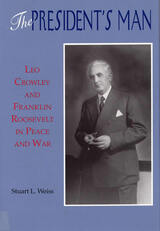 The President's Man: Leo Crowley and Franklin Roosevelt in Peace and War
Stuart L. Weiss
Southern Illinois University Press, 1996
Leo Crowley has been known only as the administrator condemned by President Truman for cutting off Soviet lend-lease after V-E Day. Stuart L. Weiss revises this view while exploring Crowley’s long, significant state and federal career, emphasizing his service as Franklin D. Roosevelt’s man for all seasons.
Weiss deals effectively with Crowley’s flaws and virtues as well as those of the administrations he served. Crowley was confirmed as chair of the FDIC in 1934 despite a charge, unknown to President Roosevelt, that Crowley had committed fraud as a banker in Wisconsin. Crowley then served with distinction for more than eleven years as the administration twice buried a 1935 Treasury Department report that, had it been handed to Wisconsin authorities, could have sent him to prison: Roosevelt valued Crowley’s political and administrative talents too highly to allow that to happen.
In 1939, Roosevelt, anxious to have business support for stopping the Axis powers, encouraged Crowley to take the chair of a holding company about to be prosecuted by the SEC. After Pearl Harbor, like priorities prompted the president first to name Crowley alien property custodian, then chair of the Board of Economic Warfare to supplant Roosevelt’s politically troublesome vice president, and, finally, foreign economic administrator, the person responsible for civilian lend-lease activity
In this vibrant biography, Weiss furnishes the reader with detailed portraits of a man faithful to his president even when he disagreed with him and of a president willing to do what he felt was necessary for the good of the country.
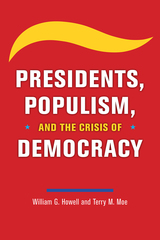 Presidents, Populism, and the Crisis of Democracy
William G. Howell and Terry M. Moe
University of Chicago Press, 2020 Has American democracy’s long, ambitious run come to an end? Possibly yes. As William G. Howell and Terry M. Moe argue in this trenchant new analysis of modern politics, the United States faces a historic crisis that threatens our system of self-government—and if democracy is to be saved, the causes of the crisis must be understood and defused.
The most visible cause is Donald Trump, who has used his presidency to attack the nation’s institutions and violate its democratic norms. Yet Trump is but a symptom of causes that run much deeper: social forces like globalization, automation, and immigration that for decades have generated economic harms and cultural anxieties that our government has been wholly ineffective at addressing. Millions of Americans have grown angry and disaffected, and populist appeals have found a receptive audience. These are the drivers of Trump’s dangerous presidency. And after he leaves office, they will still be there for other populists to weaponize.
What can be done to safeguard American democracy? The disruptive forces of modernity cannot be stopped. The solution lies, instead, in having a government that can deal with them—which calls for aggressive new policies, but also for institutional reforms that enhance its capacity for effective action.
The path to progress is filled with political obstacles, including an increasingly populist, anti-government Republican Party. It is hard to be optimistic. But if the challenge is to be met, we need reforms of the presidency itself—reforms that harness the promise of presidential power for effective government, but firmly protect against the fear that it may be put to anti-democratic ends.
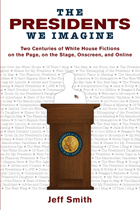 The Presidents We Imagine: Two Centuries of White House Fictions on the Page, on the Stage, Onscreen, and Online
Jeff Smith
University of Wisconsin Press, 2009 In such popular television series as The West Wing and 24, in thrillers like Tom Clancy’s novels, and in recent films, plays, graphic novels, and internet cartoons, America has been led by an amazing variety of chief executives. Some of these are real presidents who have been fictionally reimagined. Others are “might-have-beens” like Philip Roth’s President Charles Lindbergh. Many more have never existed except in some storyteller’s mind.
In The Presidents We Imagine, Jeff Smith examines the presidency’s ever-changing place in the American imagination. Ranging across different media and analyzing works of many kinds, some familiar and some never before studied, he explores the evolution of presidential fictions, their central themes, the impact on them of new and emerging media, and their largely unexamined role in the nation’s real politics.
Smith traces fictions of the presidency from the plays and polemics of the eighteenth century—when the new office was born in what Alexander Hamilton called “the regions of fiction”—to the digital products of the twenty-first century, with their seemingly limitless user-defined ways of imagining the world’s most important political figure. Students of American culture and politics, as well as readers interested in political fiction and film, will find here a colorful, indispensable guide to the many surprising ways Americans have been “representing” presidents even as those presidents have represented them.
“Especially timely in an era when media image-mongering increasingly shapes presidential politics.”—Paul S. Boyer, series editor
“Smith's understanding of the sociopolitical realities of US history is impressive; likewise his interpretations of works of literature and popular culture. . . .In addition to presenting thoughtful analysis, the book is also fun. Readers will enjoy encounters with, for example, The Beggar's Opera, Duck Soup, Edward Bellamy's Looking Backward, Philip Roth's Plot against America, the comedic campaigns of W. C. Fields for President and Pogo for President, and presidential fictions that continue up to the last President Bush. . . . His writing is fluid and conversational, but every page reveals deep understanding and focus. Summing Up: Highly recommended. All readers.”—CHOICE
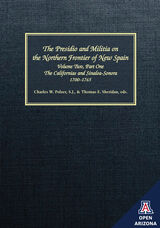 The Presidio and Militia on the Northern Frontier of New Spain: A Documentary History, Volume Two, Part One: The Californias and Sinaloa-Sonora, 1700-1765
Edited by Charles W. Polzer and Thomas E. Sheridan
University of Arizona Press, 1997 Acclaimed by readers and reviewers alike, the first volume of The Presidio and Militia on the Northern Frontier of New Spain was a landmark in the documentary study of seventeenth-century Spanish Colonial Mexico. Here, Charles W. Polzer and Thomas E. Sheridan bring the same incisive scholarship and careful editing to long-awaited Volume Two, covering the years 1700-1765.The two-part second volume looks at the Spanish expansion as occurring in four north-south corridors that carried the main components of social and political activity. Divided geographically, materials in this book (part 1) relate to the two westernmost corridors, while those in the projected book (part 2) will cover the corridors north to New Mexico and northeast into Texas. Documents in both books demonstrate the importance of regional hostilities rather than exterior threats in the establishment of presidios.Materials in this book relate to events and episodes in the Californias (the peninsula of Baja California) where the situation of the presidial forces was unique in New Spain. By bringing into focus the ways that civil-religious relations affected the military garrison there, these documents contribute immeasurably to a greater understanding of how California itself emerged in history. Also covering Sinaloa and Sonora, the mainland of the west coast of New Spain, records in the book reveal how the Sinaloa coastal forces differed from those in the interior and how they were depended upon for protection in the northern expansion, both civil and missionary.Because documents on the presidios in northern New Spain are vast in number and varied in content, these selections are meant to provide for the reader or researcher a framework around which more elaborate studies might be constructed. All of the records have been translated from the Spanish language into readable, modern English and are accompanied by transcribed versions of the originals.Valuable to both non-specialists and specialists, here is an unparalleled resource important not only for the careful selection, preparation, and presentation of documents, but also for the excellent background information that puts them into context and makes them come alive.
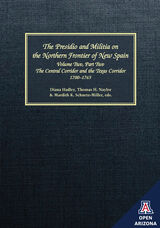 The Presidio and Militia on the Northern Frontier of New Spain: A Documentary History, Volume Two, Part Two: The Central Corridor and the Texas Corridor, 1700-1765
Edited by Diana Hadley, Thomas H. Naylor, and Mardith K. Schuetz-Miller
University of Arizona Press, 1997 Joining an acclaimed multivolume work funded by the National Historical Publications and Records Commission is a new volume of The Presidio and Militia on the Northern Frontier of New Spain. As the work of the Documentary Relations of the Southwest project, under the general editorship of Charles W. Polzer, S.J., the volumes stand alone in their translation and publication of a wide variety of documents that describe the Spanish exploration and conquest of what is now the southwestern United States and northern Mexico. The presidial system of northern New Spain's Central and Texas Corridor was an evolving institution used for exploration, military presence and defense against foreign powers, local militia duty, mission support, personal service, and penal obligations. The new volume, which covers parts of what is now Texas, New Mexico, and Mexico, includes letters, diaries, judicial papers, military reports, and interrogations. Difficult for researchers to access and sometimes to decipher, the records are presented in Spanish and in English translation, annotated and introduced by the volume editors.
Preso sin Nombre, Celda sin Numero
Jacobo Timerman; Con textos de Arthur Miller y Ariel Dorfman
University of Wisconsin Press, 2004 A classic of world literature back in print in a Spanish-language edition.
Wisconsin edition is for sale only in North America.
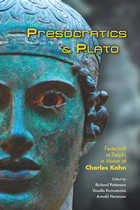 Presocratics and Plato: Festschrift at Delphi in Honor of Charles Kahn
Richard Patterson
Parmenides Publishing, 2012 This celebratory Festschrift dedicated to Charles Kahn comprises some 23 articles by friends, former students and colleagues, many of whom first presented their papers at the international "Presocratics and Plato" Symposium in his honor (European Cultural Center of Delphi, Greece, 3–7 June, 2009). The conference was organized and sponsored by the HYELE Institute for Comparative Studies, Parmenides Publishing, and Starcom AG, with endorsements from the International Plato Society, and the Dean of the School of Arts and Sciences, University of Pennsylvania. While Kahn's work reaches far beyond the Presocratics and Plato, it is in these subject areas that the distinction of his scholarship has come to be regarded as virtually unrivaled. The articles contributed to this volume are by some of the most renowned scholars working on these topics today, their breadth and depth bearing witness to his profound impact and influence on the discipline of Ancient Greek Philosophy.
Charles Kahn taught Classics and Philosophy at Columbia University from 1957 to 1965, and has since been teaching in the Philosophy Department of the University of Pennsylvania. He spent a year as Visiting Professor at the American School of Classical Studies in Athens, and had additional Visiting Fellowships at Balliol College, Oxford and Clare Hall, Cambridge, and a term as Visiting Professor at Harvard. He is the recipient of several prestigious research grants, from the American Council of Learned Societies (1963/64 and 1984/85), the National Endowment for the Humanities (1974/75 and 1990/91), and the Guggenheim Foundation (1979/80). In 2000 he was elected Fellow of the National Academy of Arts and Sciences. He is the author of Anaximander and the Origins of Greek Cosmology, The Verb “Be” in Ancient Greek, The Art and Thought of Heraclitus, Plato and the Socratic Dialogue, Pythagoras and the Pythagoreans, and Essays on Being. His latest book,Plato and the Post-Socratic Dialogue, is forthcoming from Cambridge University Press.
Contributors: Julia Annas
Sarah Broadie
Lesley Brown
Tomás Calvo-Martínez
Diskin Clay
John M. Dillon
Dorothea Frede
Arnold Hermann
Carl A. Huffman
Enrique Hülsz Piccone
D. M. Hutchinson
Paul Kalligas
Vassilis Karasmanis
Aryeh Kosman
Anthony A. Long
Richard McKirahan
Susan Sauvé Meyer
Alexander P.D.Mourelatos
Satoshi Ogihara
Richard Patterson
Christopher J. Rowe
David Sedley
Richard Sorabji
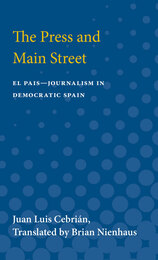 The Press and Main Street: El Pais--Journalism in Democratic Spain
Juan Luis Cebrian, Translated by Brian Nienhaus
University of Michigan Press, 1990 In a nation that had no tradition of free speech, Juan Luis Cebrián has not only established El País as a model liberal newspaper but also made it the measure of Spanish democracy. The Press and Main Street is a collection of essays originally published in Spanish under the title La Prensa y La Calle: Escritos sobre Periodismo. Juan Luis Cebrián is one of Europe's most respected journalist-publishers. He draws on extensive experience in journalism from the period of the Franco dictatorship to the very recent reforms of Spanish society and her entry into the modern European community.Essay topics range from the complexities of operating a free press to the vagaries of letters to the editor and public opinion. Newly included is a chapter written for this edition that compares the press in the United States with that in Spain. All the essays are well-crafted messages of considerable importance to anyone interested in the press, Spain, or the relationship of politics to journalism.
 The Press and the Constitution, 1931-1947
J. Edward Gerald
University of Minnesota Press, 1948
The Press and the Constitution, 1931–1947 was first published in 1948. Minnesota Archive Editions uses digital technology to make long-unavailable books once again accessible, and are published unaltered from the original University of Minnesota Press editions.
Sixteen dramatic years—from the Minnesota gag law case in 1931 to the Taft-Hartley Act in 1947. Sixteen years in which the American system of freedom developed new strength and conferred new benefits on the common man. In The Press and the Constitution J. Edward Gerald has told the story of these years as they have influenced the development of freedom of the press.
During this turbulent time American newspapers, in spite of their claims to protection under the First and Fourteenth amendments, have found themselves subjected to increasing legal restraints. The guarantee of freedom of the press affects the lives of a wide range of individuals—from publishers to pickets, from Big Business leaders to itinerant evangelists. To show this, Mr. Gerald includes in his discussion the anti-trust laws, newspaper taxes, wage and hour legislation, censorship, picketing, licensing, and the contempt power.
The book analyzes a series of cases decided by the United States Supreme Court from 1931 to 1947. Among the more celebrated are the Chicago Sun-Chicago Tribune antitrust case, the Esquire case, in which the powers of the Postmaster General were limited, and the Jehovah's Witnesses cases, in which the line between religion and commerce was defined.
The author concludes that American law definitely establishes—and carries out—the concept of the common welfare, even to the point of government intervention to increase freedom of the press for some while restricting it for others.
 Press Box Red: The Story Of Lester Rodney,
Irwin Silber
Temple University Press, 2003 Long before Branch Rickey signed Jackie Robinson to a Brooklyn Dodger contract in 1945, Lester Rodney, the newly hired and first sports editor of the Communist Daily Worker, launched the campaign that proved decisive in eventually breaking baseball's color line. But in the hostile anti-Communist climate of those years and for many years after, Rodney's story remained largely unknown. It therefore came as a surprise to many when Arnold Rampersad, in his authoritative 1997 biography of Jackie Robinson, wrote: "In the campaign to end Jim Crow in baseball, the most vigorous efforts came from the Communist press, most notably from Lester Rodney." Now Press Box Red tells the story of that remarkable 11-year campaign and of Rodney's unique career covering sports for the Daily Worker until he left the Communist Party in 1958. Press Box Red is packed with first-hand accounts of Rodney's challenges to the high muck-a-mucks of professional and collegiate sports, and contains frank and frequently humorous encounters with owners, managers, and coaches like Branch Rickey, Larry MacPhail, Bill Veeck, Leo Durocher, Casey Stengel, Nat Holman, Clair Bee and numerous athletes including Robinson, Roy Campanella, Joe DiMaggio, Satchel Paige, Peewee Reese, Joe Louis, Henry Armstrong, and many others. It's a story every fan will love.
Press Freedom and Pluralism in Europe: Concepts and Conditions
Edited by Andrea Czepek, Melanie Hellwig and Eva Nowak
Intellect Books, 2009 We assume that freedom of the press is guaranteed in a democratic society. But, in Press Freedom and Pluralism in Europe, researchers from twelve countries reveal that it is all too frequently a freedom that is taken for granted. In turn, they examine media systems throughout Europe and report on their conditions for independence and pluralism. Contributors to this volume discuss press freedom and diversity through several case studies involving such countries as the Baltics, Bulgaria, Poland, Romania, Finland, France, Germany, Austria, Italy, Spain, and the United Kingdom. This volume provides a critical basis from which to evaluate media freedom in the United States, and will consequently be of interest to scholars of media and communication studies.
Press Gallery: Congress and the Washington Correspondents
Donald Ritchie
Harvard University Press, 1991 Donald Ritchie examines the lives of early, self-styled congressional journalists such as Horace Greeley, Emily Briggs, Benjamin Perley Poore, Jane Grey Swisshelm, Horace White, James G. Blaine, and others who were positioned in the hub of government when the Civil War, the purchase of Alaska, the Crédit Mobilier scandal, and the Johnson impeachment hearings were making front-page news. Rich in anecdote, this lively book illuminates an important era of journalism and American history. The nascent issues of censorship, right to privacy, and conflict of interest that it describes are still very much with us.
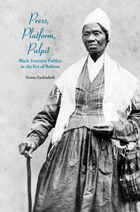 Press, Platform, Pulpit: Black Feminist Publics in the Era of Reform
Teresa Zackodnik
University of Tennessee Press, 2011
Press, Platform, Pulpit examines how early black feminism goes public by sheding new light on some of the major figures of early black feminism as well as bringing forward some lesser-known individuals who helped shape various reform movements. With a perspective unlike many other studies of black feminism, Teresa Zackodnik considers these activists as central, rather than marginal, to the politics of their day, and argues that black feminism reached critical mass well before the club movement’s national federation at the turn into the twentieth century . Throughout, she shifts the way in which major figures of early black feminism have been understood.
The first three chapters trace the varied speaking styles and appeals of black women in the church, abolition, and women’s rights, highlighting audience and location as mediating factors in the public address and politics of figures such as Jarena Lee, Zilpha Elaw, Amanda Berry Smith, Ellen Craft, Sarah Parker Remond and Sojourner Truth. The next chapter focuses on Ida B. Wells’s anti-lynching tours as working within “New Abolition” and influenced by black feminists before her. The final chapter examines feminist black nationalism as it developed in the periodical press by considering Maria Stewart’s social and feminist gospel; Mary Shadd Cary’s linking of abolition, emigration, and woman suffrage; and late-nineteenth-century black feminist journalism addressing black women’s migration and labor. Early black feminists working in reforms such as abolition and women’s rights opened new public arenas, such as the press, to the voices of black women. The book concludes by focusing on the 1891 National Council of Women, Frances Harper, and Anna Julia Cooper, which together mark a generational shift in black feminism, and by exploring the possibilities of taking black feminism public through forging coalitions among women of color.
Press, Platform, Pulpit goes far in deepening our understanding of early black feminism, its position in reform, and the varied publics it created for its politics. It not only moves historically from black feminist work in the church early in the nineteenth century to black feminism in the press at its close, but also explores the connections between black feminist politics across the century and specific reforms.
 Pressed by a Double Loyalty: Hungarian Attendance at the Second Vatican Council, 1959-1965
András Fejérdy
Central European University Press, 2017 The Second Vatican Council is the single most influential event in the 20th century history of the Catholic Church. The book analyzes the relationship between the Council and the "Ostpolitik" of the Vatican through the history of the Hungarian presence at Vatican II. Pope John XXIII, elected in 1958, was a catalyst. The pope thought that his most urgent task was to renew contacts with the Church behind the iron curtain. Hungarian participation at the Council was also made possible by the new, pragmatic model in Hungarian church politics. After the crushing of the 1956 Revolution, churches in Hungary thought that the regime would last and were willing to compromise. Vatican II – in the perspective of Hungary – was not primarily an ecclesial event, but it remained closely joined to the negotiations between the Holy See and the Kádár regime: during the Council Hungary became the experimental laboratory of the Vatican's new eastern policy. Was it a Vatican decision or a Soviet instruction? Fejérdy suggests that it was a decision of the Holy See.
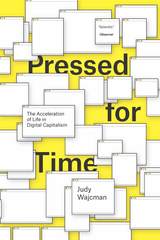 Pressed for Time: The Acceleration of Life in Digital Capitalism
Judy Wajcman
University of Chicago Press, 2014 The technologically tethered, iPhone-addicted figure is an image we can easily conjure. Most of us complain that there aren't enough hours in the day and too many e-mails in our thumb-accessible inboxes. This widespread perception that life is faster than it used to be is now ingrained in our culture, and smartphones and the Internet are continually being blamed. But isn't the sole purpose of the smartphone to give us such quick access to people and information that we'll be free to do other things? Isn't technology supposed to make our lives easier?
In Pressed for Time, Judy Wajcman explains why we immediately interpret our experiences with digital technology as inexorably accelerating everyday life. She argues that we are not mere hostages to communication devices, and the sense of always being rushed is the result of the priorities and parameters we ourselves set rather than the machines that help us set them. Indeed, being busy and having action-packed lives has become valorized by our productivity driven culture. Wajcman offers a bracing historical perspective, exploring the commodification of clock time, and how the speed of the industrial age became identified with progress. She also delves into the ways time-use differs for diverse groups in modern societies, showing how changes in work patterns, family arrangements, and parenting all affect time stress. Bringing together empirical research on time use and theoretical debates about dramatic digital developments, this accessible and engaging book will leave readers better versed in how to use technology to navigate life's fast lane.
Pressing Forward with the Book of Mormon
John W. Welch
Foundation for Ancient Research and Mormon Studies, 1999 Edited by John W. Welch and Melvin J. Thorne, this book presents the FARMS Research Updates of the 1990s, plus some similar short notes from the Journal of Book of Mormon Studies, in a new collection. Aimed at a general audience, these updates are brief, easy-to-read reports of new research on the Book of Mormon. In this fascinating book, the contributors tell of intriguing ideas and developments that have emerged from exploring the Book of Mormon from many perspectives. Pressing Forward will interest all people who want to know what's new in Book of Mormon research.
Pressing Freedom: A Novel
Roger Armbrust
Parkhurst Brothers, Inc., 2017 An investigative reporter for a statewide newspaper connects the dots on an interstate jewel fencing scheme which leads to the capitol city mayor’s door, and implicates a would-be governor. The reporter, a Vietnam vet whose keeps his black ops background under wraps, is attacked by rogue cops, who also threaten his daughter and his girlfriend. His USMC training, unknown to his assailants, saves him from serious injury, but danger on the national scene draws his attention. With a former United States Senator who shares his concern for the unstable new administration in Washington, the reporter finds himself in the midst of a plot to return the federal government to stability, but by means that shock him to the core. A political thriller born of our current national turmoil, this first novel by a seasoned journalist will leave the reader with wide eyes and a quickened heartbeat.
 Pressing On: The Roni Stoneman Story
Roni Stoneman as told to Ellen Wright
University of Illinois Press, 2006 Roni Stoneman was the youngest daughter of the pioneering country music family and a woman who overcame poverty and abusive husbands to claim the title of "The First Lady of Banjo," a fixture on the Nashville scene, and, as Hee Haw's Ironing Board Lady, a comedienne beloved by millions. Drawn from more than seventy-five hours of recorded interviews, Pressing On reveals Roni's gifts as a master storyteller. With characteristic spunk and candor, she describes her "pooristic" ("way beyond 'poverty-stricken'") Appalachian childhood, and how her brother Scott taught her to play the challenging and innovative three-finger banjo picking style developed by Earl Scruggs. She also warmly recounts Hee Haw-era adventures with Minnie Pearl, Roy Clark, and Buck Owens; her encounters as a musician with country greats like Loretta Lynn, Johnny Cash, June Carter, and Patsy Cline; as well as her personal struggles with shiftless and violent husbands, her relationships with her children, and her musical life after Hee Haw.
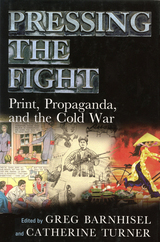 Pressing the Fight: Print, Propaganda, and the Cold War
Greg Barnhisel
University of Massachusetts Press, 2010 Although often framed as an economic, military, and diplomatic confrontation, the Cold War was above all a conflict of ideas. In official pronouncements and publications as well as via radio broadcasts, television, and film, the United States and the Soviet Union both sought to extend their global reach as much through the power of persuasion as by the use of force. Yet of all the means each side employed to press its ideological case, none proved more reliable or successful than print.
In this volume, scholars from a variety of disciplines explore the myriad ways print was used in the Cold War. Looking at materials ranging from textbooks and cookbooks to art catalogs, newspaper comics, and travel guides, they analyze not only the content of printed matter but also the material circumstances of its production, the people and institutions that disseminated it, and the audiences that consumed it. Among the topics discussed are the infiltration of book publishing by propagandists East and West; the distribution of pro-American printed matter in postwar Japan through libraries, schools, and consulates; and the collaboration of foundations, academia, and the government in the promotion of high culture as evidence of the superiority of Western values.
At the same time, many of the qualities that made print the preferred medium of official propaganda also made it an effective instrument for challenging Cold War orthodoxies at home and abroad. Because printed materials were relatively easy to transport, to copy, and to share, they could just as well be used to bridge differences among people and cultures as to exploit them. They also provided a vehicle for disseminating satire and other expressions of dissent.
In addition to the volume editors, contributors include Ed Brunner, Russell Cobb, Laura Jane Gifford, Patricia Hills, Christian Kanig, Scott Laderman, Amanda Laugesen, Martin Manning, Kristin Matthews, Hiromi Ochi, Amy Reddinger, and James Smith. Together their essays move beyond traditional Cold War narratives to gauge the role of a crucial cultural medium in the ideological battle between the superpowers and their surrogates.
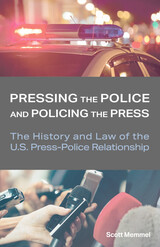 Pressing the Police and Policing the Press: The History and Law of the U.S. Press-Police Relationship
Scott Memmel
University of Missouri Press, 2024 In the second half of 2020 and continuing into 2021, protests against racial injustice spread across the United States after the death of George Floyd while in the custody of Minneapolis Police Department officers. Members of the press covered these demonstrations, documenting what transpired and conveying the important messages involved. In so doing, the news media held law enforcement accountable through critical reporting on the actions of the police, with police officers responding in part by intimidating journalists in the field using force and arrest—this in the name of keeping the peace and protecting the public from further harm.
What transpired during this troubled time cast a bright light on the contemporary relationship between the press and police in the United States. The relationship between these two fundamental institutions is, however, a long and complicated one, dating back to colonial British North America. In the mid-19th century, (1830s–1850s) both the press and the police began to take their modern forms, and since then have continued to develop, routinely interacting with each other as journalists and police officers often found themselves responding to the same crimes and events. At times, members of both institutions managed to co-exist or even cooperate and made efforts to help one another, while at other times they butted heads to the point of conflict, the professional boundaries between journalists and police officers seemingly blurred.
As both the press and the police have fallen under deep scrutiny in more modern times, the present moment marks what is, perhaps, an opportune time to focus on the political, economic, social, and technological problems they face. In “Pressing the Police and Policing the Press,” Scott Memmel offers the first book-length study of the history and legal landscape of the press-police relationship. Each chapter focuses on interactions between the press and the police during a particular era, introducing relevant societal context and how both institutions evolved and responded to that context. Memmel concludes his study with recommendations on how, going forward, the press and the police might work together to tackle some of the similar issues they face and better serve the public.
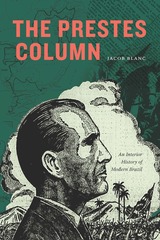 The Prestes Column: An Interior History of Modern Brazil
Jacob Blanc
Duke University Press, 2024 In The Prestes Column, Jacob Blanc offers a new interpretation of the legendary rebellion, in which a band of rebel officers and soldiers marched fifteen thousand miles through the vast interior regions of Brazil between 1924 and 1927. Blanc’s analysis of the Prestes Column is a showcase of what he calls “interior history.” At a pivotal moment in national politics, the long march of the column came to embody the constructed duality of Brazil’s interior: a space that was seen by coastal elites as simultaneously backward—in relation to the more modern coast—and dormant, an expanse of untapped potential waiting to be brought into the nation. Drawing on a range of materials, from officers’ memoirs and local eyewitness accounts to physical memorials and government archives, Blanc’s framework of interior history helps explain the column’s initial rise to fame and also its enduring legacy across the twentieth century, offering a new approach for the study of space and nation.
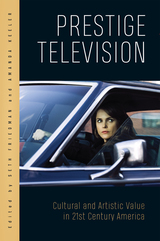 Prestige Television: Cultural and Artistic Value in Twenty-First-Century America
Seth Friedman
Rutgers University Press, 2023 Prestige Television explores how a growing array of 21st century US programming is produced and received in ways that elevate select series above the competition in a saturated market. Contributing authors demonstrate that these shows are positioned and understood as comprising an increasingly recognizable genre characterized by familiar markers of distinction. In contrast to most accounts of elite categorizations of contemporary US television programming that center on HBO and its primary streaming rivals, these essays examine how efforts to imbue series with prestigious or elevated status now permeate the rest of the medium, including network as well as basic and undervalued premium cable channels. Case study chapters focusing on diverse series, ranging from widely recognized examples such as The Americans (2013-2018) and The Knick (2014-15) to contested examples like Queen of the South (2016-2021) and How I Met Your Mother (2005-2014), highlight how contributing authors extend conceptions of the genre beyond expected parameters.
Preston Sturges: The Last Years of Hollywood's First Writer-Director
Nick Smedley and Tom Sturges
Intellect Books, 2019 Few directors of the 1930s and ‘40s were as distinctive and popular as Preston Sturges, whose whipsmart comedies have entertained audiences for decades. Beginning with a foreword by Peter Bogdanovich, this book offers a new critical appreciation of Sturges’ whole oeuvre, incorporating a detailed study of the last ten years of his life from new primary sources. Preston Sturges details the many unfinished projects of Sturges’ last decade, including films, plays, TV series and his autobiography. Drawing on diaries, sketchbooks, correspondence, unpublished screenplays and more, Nick Smedley and Tom Sturges present the writer-director’s final years in more detail than we’ve ever seen, showing a master still at work—even if very little of that work ultimately made it to the screen or stage.
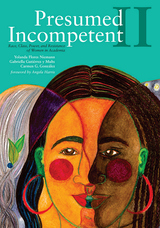 Presumed Incompetent II: Race, Class, Power, and Resistance of Women in Academia
Yolanda Flores Niemann
Utah State University Press, 2020 The courageous and inspiring personal narratives and empirical studies in Presumed Incompetent II: Race, Class, Power, and Resistance of Women in Academia name formidable obstacles and systemic biases that all women faculty—from diverse intersectional and transnational identities and from tenure track, terminal contract, and administrative positions—encounter in their higher education careers. They provide practical, specific, and insightful guidance to fight back, prevail, and thrive in challenging work environments. This new volume comes at a crucial historical moment as the United States grapples with a resurgence of white supremacy and misogyny at the forefront of our social and political dialogues that continue to permeate the academic world. Contributors: Marcia Allen Owens, Sarah Amira de la Garza, Sahar Aziz, Jacquelyn Bridgeman, Jamiella Brooks, Lolita Buckner Inniss, Kim Case, Donna Castaneda, Julia Chang, Meredith Clark, Meera Deo, Penelope Espinoza, Yvette Flores, Lynn Fujiwara, Jennifer Gomez, Angela Harris, Dorothy Hines, Rachelle Joplin, Jessica Lavariega Monforti, Cynthia Lee, Yessenia Manzo, Melissa Michelson, Susie E. Nam, Yolanda Flores Niemann, Jodi O’Brien, Amelia Ortega, Laura Padilla, Grace Park, Stacey Patton, Desdamona Rios, Melissa Michal Slocum, Nellie Tran, Rachel Tudor, Pamela Tywman Hoff, Adrien Wing, Jemimah Li Young
Presumed Incompetent: The Intersections of Race and Class for Women in Academia
edited by Gabriella Gutiérrez y Muhs, Yolanda Flores Niemann, Carmen G. González, and Angela P. Harris
Utah State University Press, 2012 Presumed Incompetent is a pathbreaking account of the intersecting roles of race, gender, and class in the working lives of women faculty of color. Through personal narratives and qualitative empirical studies, more than 40 authors expose the daunting challenges faced by academic women of color as they navigate the often hostile terrain of higher education, including hiring, promotion, tenure, and relations with students, colleagues, and administrators. The narratives are filled with wit, wisdom, and concrete recommendations, and provide a window into the struggles of professional women in a racially stratified but increasingly multicultural America.
Presumption: An Entertainment: A Sequel to Pride and Prejudice
Julia Barrett
University of Chicago Press, 1995 This witty sequel to Jane Austen's Pride and Prejudice follows the fate of Georgiana Darcy, Mr. Darcy's younger sister, who must choose between two suitors, a well-placed navy captain and a brash young architect. Masterfully adapted to Austen's original nineteenth-century style, Presumption brings back to life the book's most memorable characters, the Bennets, Darcys, Collins, and de Bourghs.
"An elegant emulation and continuation of Pride and Prejudice. . . . Jointly composed by two admirers of Jane Austen, the book often achieves crisp replication of her style. . . . Presumption shows how sequel-writing can, like parody, be a sharp exercise in literary appreciation."—Peter Kemp, Times Literary Supplement
Julia Barrett is a pseudonym for Julia Braun Kessler and Gabrielle Donnelly.
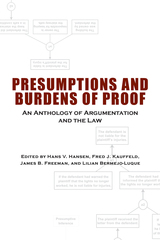 Presumptions and Burdens of Proof: An Anthology of Argumentation and the Law
Edited by Hans V. Hansen, Fred J. Kauffeld, James B. Freeman, and Lilian Bermejo-Luque
University of Alabama Press, 2019 An anthology of the most important historical sources, classical and modern, on the subjects of presumptions and burdens of proof
In the last fifty years, the study of argumentation has become one of the most exciting intellectual crossroads in the modern academy. Two of the most central concepts of argumentation theory are presumptions and burdens of proof. Their functions have been explicitly recognized in legal theory since the middle ages, but their pervasive presence in all forms of argumentation and in inquiries beyond the law—including politics, science, religion, philosophy, and interpersonal communication—have been the object of study since the nineteenth century.
However, the documents and essays central to any discussion of presumptions and burdens of proof as devices of argumentation are scattered across a variety of remote sources in rhetoric, law, and philosophy. Presumptions and Burdens of Proof: An Anthology of Argumentation and the Law brings together for the first time key texts relating to the history of the theory of presumptions along with contemporary studies that identify and give insight into the issues facing students and scholars today.
The collection’s first half contains historical sources and begins with excerpts from Aristotle’s Topics and goes on to include the locus classicus chapter from Bishop Whately’s crucial Elements of Rhetoric as well as later reactions to Whately’s views. The second half of the collection contains contemporary essays by contributors from the fields of law, philosophy, rhetoric, and argumentation and communication theory. These essays explore contemporary understandings of presumptions and burdens of proof and their role in numerous contexts today. This anthology is the definitive resource on the subject of these crucial rhetorical modes and will be a vital resource to all scholars of communication and rhetoric, as well as legal scholars and practicing jurists.
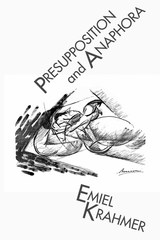 Presupposition and Anaphora
Emiel Krahmer
CSLI, 1998 In this book, two related phenomena are studied: presupposition and anaphora. Dynamic semantics is by now widely accepted as a first-rate foundation for such an exercise and it forms the backbone of most of the work in this book. A recurring additional theme of the present book is the usefulness of techniques from partial logic in the treatment of both phenomena. Rather than adding completely new semantic theories to the present gamut of theories, the author discusses a number of existing approaches which aim at accounting for the behavior of presuppositions and/or anaphors, makes improvements where necessary, and compares the results. Presupposition and Anaphora starts with an introduction to a number of dynamic semantic theories and their correlations, paying special attention to the treatment of disjunctions and negations. Subsequently, presuppositions are studied in the context of partial logics, Montague Grammar and dynamic semantics.
 Presupposition and Assertion in Dynamic Semantics: A Critical Review of Linguistic Theories of Presupposition and a Dynamic Alternative
David I. Beaver
CSLI, 2001 Russell and Strawson sparked a well known debate on the subject of Linguistic Presupposition inspiring many linguists and philosophers to follow suit, including Frege, whose work initiated the modern study in this area. Beaver begins with the most comprehensive overview and critical discussion of this burgeoning field published to date. He then goes on to motivate and develop his own account based on a Dynamic Semantics. This account is a recent line of theoretical work in which the Tarskian emphasis on truth conditions is questioned. The central plank of the theory of meaning is a formal account of the change in information effected by use of language on hearers or readers. The proposal thus consolidates ideas of Stalnaker, Karttunen and Heim, all of whom had suggested that such an account was needed. At the same time it provides a new impulse and motivation to Dynamic Semantics itself.
Pretend I'm Dead: A Novel
Jen Beagin
Northwestern University Press, 2015
Jen Beagin’s funny, moving, fearless debut novel introduces an unforgettable character, Mona—almost 24, cleaning houses to get by, emotionally adrift. Handing out clean needles to drug addicts, she falls for a recipient who proceeds to break her heart in unimaginable ways. She decamps to Taos, New Mexico, for a fresh start, where she finds a community of seekers and cast-offs. But they all have one or two things to teach her—the pajama-wearing, blissed-out New Agers, the slightly creepy client with peculiar tastes in controlled substances, the psychic who might really be psychic. Always just under the surface are her memories of growing up in a chaotic, destructive family from which she’s trying to disentangle herself. The story of her journey toward a comfortable place in the world and a measure of self-acceptance is psychologically acute, often surprising, and entirely human.
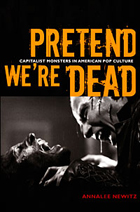 Pretend We're Dead: Capitalist Monsters in American Pop Culture
Annalee Newitz
Duke University Press, 2006 In Pretend We’re Dead, Annalee Newitz argues that the slimy zombies and gore-soaked murderers who have stormed through American film and literature over the past century embody the violent contradictions of capitalism. Ravaged by overwork, alienated by corporate conformity, and mutilated by the unfettered lust for profit, fictional monsters act out the problems with an economic system that seems designed to eat people whole. Newitz looks at representations of serial killers, mad doctors, the undead, cyborgs, and unfortunates mutated by their involvement with the mass media industry. Whether considering the serial killer who turns murder into a kind of labor by mass producing dead bodies, or the hack writers and bloodthirsty actresses trapped inside Hollywood’s profit-mad storytelling machine, she reveals that each creature has its own tale to tell about how a freewheeling market economy turns human beings into monstrosities. Newitz tracks the monsters spawned by capitalism through b movies, Hollywood blockbusters, pulp fiction, and American literary classics, looking at their manifestations in works such as Norman Mailer’s “true life novel” The Executioner’s Song; the short stories of Isaac Asimov and H. P. Lovecraft; the cyberpunk novels of William Gibson and Marge Piercy; true-crime books about the serial killers Ted Bundy and Jeffrey Dahmer; and movies including Modern Times (1936), Donovan’s Brain (1953), Night of the Living Dead (1968), RoboCop (1987), The Silence of the Lambs (1991), and Artificial Intelligence: AI (2001). Newitz shows that as literature and film tell it, the story of American capitalism since the late nineteenth century is a tale of body-mangling, soul-crushing horror.
Pretender to the Throne: Further Adventures of Private Ivan Chonkin
Vladimir Voinovich
Northwestern University Press, 1995 This hilarious novel following the continuing adventures of Ivan Chonkin, a simple peasant who has been arrested as a traitor after spending World War II happily tending a garden. In this sequel to The Extraordinary Life and Adventures of Private Ivan Chonkin, Vladimir Voinovich ridicules everything sacred to the Soviet Union—the army, the justice system, the press, and Stalin himself—in a refreshing combination of dissident conscience and universal humor.
 Pretext for Mass Murder: The September 30th Movement and Suharto's Coup d'Etat in Indonesia
John Roosa
University of Wisconsin Press, 2006 In the early morning hours of October 1, 1965, a group calling itself the September 30th Movement kidnapped and executed six generals of the Indonesian army, including its highest commander. The group claimed that it was attempting to preempt a coup, but it was quickly defeated as the senior surviving general, Haji Mohammad Suharto, drove the movement’s partisans out of Jakarta. Riding the crest of mass violence, Suharto blamed the Communist Party of Indonesia for masterminding the movement and used the emergency as a pretext for gradually eroding President Sukarno’s powers and installing himself as a ruler. Imprisoning and killing hundreds of thousands of alleged communists over the next year, Suharto remade the events of October 1, 1965 into the central event of modern Indonesian history and the cornerstone of his thirty-two-year dictatorship. Despite its importance as a trigger for one of the twentieth century’s worst cases of mass violence, the September 30th Movement has remained shrouded in uncertainty. Who actually masterminded it? What did they hope to achieve? Why did they fail so miserably? And what was the movement’s connection to international Cold War politics? In Pretext for Mass Murder, John Roosa draws on a wealth of new primary source material to suggest a solution to the mystery behind the movement and the enabling myth of Suharto’s repressive regime. His book is a remarkable feat of historical investigation. Finalist, Social Sciences Book Award, the International Convention of Asian Scholars
PRE/TEXT: The First Decade
Victor Vitanza
University of Pittsburgh Press, 1993 After the first issue of PRE/TEXT appeared in 1981, a colleague told Victor Vitanza, the creator, editor and publisher of the journal, how disgusted she was by it, how unreadable it was, how devoted to self-aggrandizement-and how much she enjoyed two articles in it. Devoted to exploring and expanding the field of rhetoric and composition by publishing articles considered “inappropriate” by other journals in the field, PRE/TEXT has, from its inception, made people angry. Yet it has survived, and thrived. This collection of essays pays tribute to the first ten years of the journal, and each reprinted article is paired with a short comment by the author. Also included is Victor Vitanza's retrospective history of the journal and prospectives for the future.
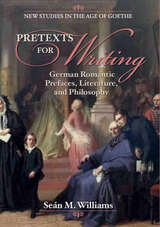 Pretexts for Writing: German Romantic Prefaces, Literature, and Philosophy
Williams, Seán M
Bucknell University Press, 2019 Around 1800, print culture became a particularly rich source for metaphors about thinking as well as writing, nowhere more so than in the German tradition of Dichter und Denker. Goethe, Jean Paul, and Hegel (among many others) used the preface in order to reflect on the problems of writing itself, and its interpretation. If Sterne teaches us that a material book enables mind games as much as it gives expression to them, the Germans made these games more theoretical still. Weaving in authors from Antiquity to Agamben, Williams shows how European–and, above all, German–Romanticism was a watershed in the history of the preface. The playful, paradoxical strategies that Romantic writers invented are later played out in continental philosophy, and in post-Structuralist literature. The preface is a prompt for playful thinking with texts, as much as it is conventionally the prosaic product of such an exercise.
Published by Bucknell University Press. Distributed worldwide by Rutgers University Press.
Pre-Texts International
José Luis Falconi and Doris Sommer
Harvard University Press Pre-Texts is a methodology developed by Doris Sommer for education professionals to stimulate close reading and critical-thinking skills by making art based on challenging texts. This book is a manual of sorts. Presented in both English and Spanish, it gathers vivid descriptions and images of dozens of different Pre-Texts activities held across the globe, in person and in online forums, with groups diverse in age, background, and native language. Pre-Texts International features testimonials from both facilitators and participants, who describe in detail the planning, procedures, and activities they carried out and attest to the methodology’s efficacy and adaptability in a wide range of contexts.
Pretrial Discovery and the Adversary System
William A. Glaser
Russell Sage Foundation, 1968 Presents the results of the first national field survey of how lawyers use pretrial discovery in practice. Pretrial discovery is a complex set of rules and practices through which the adversaries in a civil dispute are literally allowed to "discover" the facts and legal arguments their opponents plan to use in the trial, with the purpose of improving the speed and quality of justice by reducing the element of trickery and surprise. Dr. Glaser examines the uses, problems, and advantages of discovery. He concludes that it is in wide use in federal civil cases, but that while the procedure has produced more information in some areas, it has failed to bring other improvements favored by its original authors.
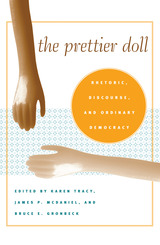 The Prettier Doll: Rhetoric, Discourse, and Ordinary Democracy
Edited by Karen Tracy, James P. McDaniel and Bruce E. Gronbeck
University of Alabama Press, 2007 Essays in the The Prettier Doll focus on the same local controversy: in 2001,a third-grade girl in Colorado submitted an experiment to the school science fair. She asked 30 adults and 30 fifth-graders which of two Barbie dolls was prettier. One doll was black, the other white, and each wore a different colored dress. All of the adults picked the Barbie in the purple dress, while nearly all of the fifth graders picked the white Barbie. When the student’s experiment was banned an uproar resulted that spread to the national media. School board meetings and other public exchanges highlighted the potent intersection of local and national social concerns: education, censorship, science, racism, and tensions in foundation values such as liberty, democracy, and free speech. For the authors of these essays, the exchanges that arose from “Barbiegate” illustrate vividly the role of rhetoric at the grassroots level, fundamental to civic judgment in a democratic state and at the core of “ordinary democracy.”
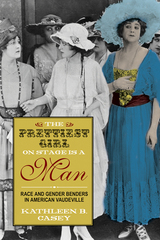 The Prettiest Girl on Stage Is a Man: Race and Gender Benders in American Vaudeville
Kathleen B. Casey
University of Tennessee Press, 2015 "In this highly readable book, Kathleen Casey makes an important intervention into the study of early-twentieth-century American vaudeville and some of its most infamous stars. She pinpoints the blind spot in current scholarship by demonstrating how race as much as gender charges the meanings in vaudeville performance.”
—Linda Mizejewski, author of Pretty/Funny: Women Comedians and Body Politics and Ziegfeld Girl
From the 1890s through the 1920s, vaudeville reigned as one of the most popular entertainment forms in urban America. Through drama, humor, and satire, it invited its socially, economically, and ethnically diverse audiences to turn a self-conscious eye upon themselves and their culture, which was being rapidly transformed by such forces as immigration, racial discord, and new conceptions of gender roles. It was no coincidence that acts featuring cross-dressing performers and racial impersonators were among vaudeville’s biggest attractions.
In this lively and enlightening study, Kathleen B. Casey explores the ways in which the gender- and race-bending spectacles of vaudeville dramatized the economic, technological, social, and cultural upheaval that gripped the United States in the early twentieth century. She focuses on four key performers. Eva Tanguay, known as “The I Don’t Care Girl,” was loved for her defiance of Victorian decorum, linking white womanliness to animalistic savagery at a time when racial and gender ideologies were undergoing significant reconstruction. In contrast, Julian Eltinge, the era’s foremost female impersonator, used race to exaggerate notions of manliness and femininity in a way that reinforced traditional norms more than it undermined them. Lillyn Brown, a biracial woman who portrayed a cosmopolitan black male dandy while singing about an antebellum southern past, offered her audiences, black and white, starkly different visual and aural messages about race and gender. Finally, Sophie Tucker, who often performed in blackface during the early years of her long and heralded career, strategically played with prevailing ideologies by alternately portraying herself as white, Jewish, black, manly, and womanly, while managing, remarkably, to convince audiences that these identities could coexist within one body.
Analyzing a wide assortment of primary materials—advertisements, recordings, lyrics, sheet music, costumes, photographs, reviews, and press accounts from the era—Casey looks not only at gender and racial impersonation but also at how spectators reacted to these performances.
Kathleen B. Casey is an assistant professor of history at Virginia Wesleyan College.
The Prettiest Woman
Grant Farred
University of Minnesota Press, 2025 Uncovering Hollywood’s perpetual longing for a lost industrial America
“We don’t make things in America anymore”: like clockwork, this refrain resurfaces in political discourse, a reflection of yearning for a bygone era of industrial productivity. In his latest work, Grant Farred uses the 1990 film Pretty Woman to expose and critique this lingering nostalgia for late-industrial capitalism. Situating Pretty Woman alongside Reagan-era films including Wall Street, Farred examines the congealment of such a pervasive romanticized view of the United States as a fading industrial powerhouse. Drawing on an eclectic range of thinkers—from Raymond Williams and Slavoj Žižek to Mick Jagger—The Prettiest Woman offers a unique analysis of the ways Hollywood perpetuates the myth of a lost “productive America,” highlighting the seductive power of this fantasy despite its disconnect from economic and political realities.
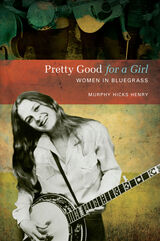 Pretty Good for a Girl: Women in Bluegrass
Murphy Henry
University of Illinois Press, 2013 The first book devoted entirely to women in bluegrass, Pretty Good for a Girl documents the lives of more than seventy women whose vibrant contributions to the development of bluegrass have been, for the most part, overlooked. Accessibly written and organized by decade, the book begins with Sally Ann Forrester, who played accordion and sang with Bill Monroe's Blue Grass Boys from 1943 to 1946, and continues into the present with artists such as Alison Krauss, Rhonda Vincent, and the Dixie Chicks. Drawing from extensive interviews, well-known banjoist Murphy Hicks Henry gives voice to women performers and innovators throughout bluegrass's history, including such pioneers as Bessie Lee Mauldin, Wilma Lee Cooper, and Roni and Donna Stoneman; family bands including the Lewises, Whites, and McLains; and later pathbreaking performers such as the Buffalo Gals and other all-girl bands, Laurie Lewis, Lynn Morris, Missy Raines, and many others.
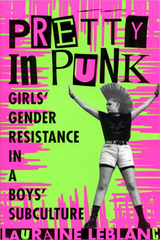 Pretty in Punk: Girl's Gender Resistance in a Boy's Subculture
Leblanc, Lauraine
Rutgers University Press, 1999 Pretty in Punk combines autobiography, interviews, and sophisticated analysis to create the first insider’s examination of the ways punk girls resist gender roles and create strong identities. Why would an articulate, intelligent, thoughtful young women shave off most of her hair, dye the remainder green, shape it into a mohawk, and glue it onto her head? What attracts girls to male-dominated youth subcultures like the punk movement? What role does the subculture play in their perceptions of themselves, and in their self-esteem? How do girls reconcile a subcultural identity that is deliberately coded “masculine” with the demands of femininity? Research has focused on the ways media and cultural messages victimize young women, but little attention has been paid to the ways they resist these messages. In Pretty in Punk, Lauraine Leblanc examines what happens when girls ignore these cultural messages, parody ideas of beauty, and refuse to play the games of teenage femininity. She explores the origins and development of the punk subculture, the processes by which girls decide to “go punk,” patterns of resistance to gender norms, and tactics girls use to deal with violence and harassment. Pretty in Punk takes readers into the lives of girls living on the margins of contemporary culture. Drawing on interviews with 40 girls and women between the ages of 14-37, Leblanc examines the lives of her subjects, illuminating their forms of rebellion and survival. Pretty in Punk lets readers hear the voices of these women as they describe the ways their constructions of femininity—from black lipstick to slamdancing—allow them to reject damaging cultural messages and build strong identities. The price they pay for resisting femininity can be steep—girls tell of parental rejection, school expulsion, institutionalization, and harassment. Leblanc illuminates punk girls’ resistance to adversity, their triumphs over tough challenges, and their work to create individual identities in a masculine world.
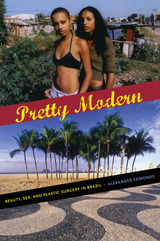 Pretty Modern: Beauty, Sex, and Plastic Surgery in Brazil
Alexander Edmonds
Duke University Press, 2010 Pretty Modern is a riveting account of Brazil’s emergence as a global leader in plastic surgery. Intrigued by a Carnaval parade that mysteriously paid homage to a Rio de Janeiro plastic surgeon, anthropologist Alexander Edmonds conducted research that took him from Ipanema socialite circles to glitzy telenovela studios to the packed waiting rooms of public hospitals offering free cosmetic surgery. The result is provocative exploration of the erotic, commercial, and intimate aspects of beauty in a nation with extremes of wealth and poverty and a reputation for natural sensuality. Drawing on conversations with maids and their elite mistresses, divorced housewives, black celebrities, and favela residents aspiring to be fashion models, Edmonds analyzes what sexual desirability means and does for women in different social positions. He argues that beauty is a distinct realm of modern experience that does not simply reflect other inequalities. It mimics the ambiguous emancipatory potential of capital, challenging traditional hierarchies while luring consumers into a sexual culture that reduces the body to the brute biological criteria of attractiveness. Illustrated with color photographs, Pretty Modern offers a fresh theoretical perspective on the significance of female beauty in consumer capitalism.
 Pretty People: Movie Stars of the 1990s
Everett, Anna
Rutgers University Press, 2012 In the 1990s, American civil society got upended and reordered as many social, cultural, political, and economic institutions were changed forever. Pretty People examines a wide range of Hollywood icons who reflect how stardom in that decade was transformed as the nation itself was signaling significant changes to familiar ideas about gender, race, ethnicity, age, class, sexuality, and nationality. Such actors as Denzel Washington, Andy Garcia, Halle Berry, Angela Bassett, Will Smith, Jennifer Lopez, and Antonio Banderas became bona fide movie stars who carried major films to amazing box-office success. Five of the decade’s top ten films were opened by three women—Julia Roberts, Jodie Foster, and Whoopi Goldberg. “Chick flick” entered the lexicon as Leonardo DiCaprio became the “King of the World,” ushering in the cult of the mega celebrity. Tom Hanks and Tom Cruise defined screen masculinity as stark contrasts between “the regular guy” and “the intense guy” while the roles of Michael Douglas exemplified the endangered “Average White Male.” A fascinating composite portrait of 1990s Hollywood and its stars, this collection marks the changes to stardom and society at century’s end.
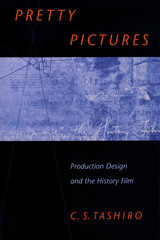 Pretty Pictures: Production Design and the History Film
By C. S. Tashiro
University of Texas Press, 1998 Theories of film have traditionally dealt with either narrative or industrial issues, with the consequence that the physical content of the graphic frame has often been ignored or relegated to the sidelines. By contrast, C. S. Tashiro foregrounds the visual aspect of cinema in this book, drawing on his experiences as a designer and filmmaker, as well as on contemporary theory, to show how production design can support or contradict narrative structure, or exist in an entirely parallel realm of meaning. Tashiro looks at cinematic production design from a broadly interdisciplinary perspective, encompassing art and architecture theory, audience reception, narrative theory, and phenomenology, to arrive at a more encompassing definition of the process. He builds his argument around studies of several prominent history films, since design is central to historical representation, and explores the most pertinent issues raised by the topic, particularly commodity consumption. In his conclusion, he also offers possible solutions to some of the social problems raised by design.
 Pretty/Funny: Women Comedians and Body Politics
By Linda Mizejewski
University of Texas Press, 2014 Women in comedy have traditionally been pegged as either “pretty” or “funny.” Attractive actresses with good comic timing such as Katherine Hepburn, Lucille Ball, and Julia Roberts have always gotten plum roles as the heroines of romantic comedies and television sitcoms. But fewer women who write and perform their own comedy have become stars, and, most often, they’ve been successful because they were willing to be funny-looking, from Fanny Brice and Phyllis Diller to Lily Tomlin and Carol Burnett. In this pretty-versus-funny history, women writer-comedians—no matter what they look like—have ended up on the other side of “pretty,” enabling them to make it the topic and butt of the joke, the ideal that is exposed as funny. Pretty/Funny focuses on Kathy Griffin, Tina Fey, Sarah Silverman, Margaret Cho, Wanda Sykes, and Ellen DeGeneres, the groundbreaking women comics who flout the pretty-versus-funny dynamic by targeting glamour, postfeminist girliness, the Hollywood A-list, and feminine whiteness with their wit and biting satire. Linda Mizejewski demonstrates that while these comics don’t all identify as feminists or take politically correct positions, their work on gender, sexuality, and race has a political impact. The first major study of women and humor in twenty years, Pretty/Funny makes a convincing case that women’s comedy has become a prime site for feminism to speak, talk back, and be contested in the twenty-first century.
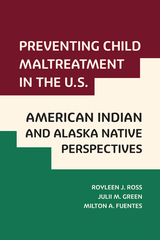 Preventing Child Maltreatment in the U.S.: American Indian and Alaska Native Perspectives
Royleen J Ross
Rutgers University Press, 2022 This book is part of a concentrated series of books that examines child maltreatment across minoritized, cultural groups.Specifically, this volume addresses American Indian and Alaska Native populations. However, in an effort to contextualize the experiences of 574 federally recognized tribes and 50+ state recognized tribes, as well as villages, the authors focus on populations within rural and remote regions and discuss the experiences of some tribal communities throughout US history. It should be noted that established research has primarily drawn attention to the pervasive problems impacting Indigenous individuals, families, and communities. Aligned with an attempt to adhere to a decolonizing praxis, the authors share information in a strength-based framework for the Indigenous communities discussed within the text. The authors review federally funded programs (prevention, intervention, and treatment) that have been adapted for tribal communities (e.g., Safecare) and include cultural teachings that address child maltreatment. The intention of this book is to inform researchers, practitioners, policy makers, and advocates about the current state of child maltreatment from an Indigenous perspective.
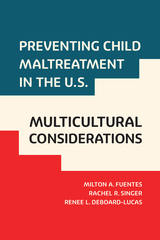 Preventing Child Maltreatment in the U.S.: Multicultural Considerations
Milton A Fuentes
Rutgers University Press, 2022 Preventing Child Maltreatment: Multicultural Considerations in the United States is the first book in a concentrated series that examines child maltreatment across minoritized, cultural groups. Specifically, this volume examines core multicultural concepts (e.g., intersectionality, acculturation, spirituality, oppression) as they relate to child maltreatment in the United States, while the other books take a closer look at particular ethnic or racial communities in this country. Additionally, this book examines child maltreatment through the intersection of feminist, multicultural, and prevention/wellness promotion lenses. Recommendations for treatment in each book build on a foundation of prevention and wellness promotion, along with multicultural and feminist theories. Throughout this book, five case studies, which are introduced in Chapter One, are revisited to help the readers make important and meaningful connections between theory and practice.
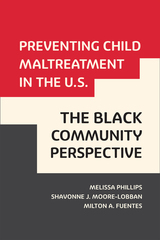 Preventing Child Maltreatment in the U.S.: The Black Community Perspective
Melissa Phillips
Rutgers University Press, 2022 Child maltreatment occurs in the Black community at higher rates than any other racial group. Given the prevalence of child maltreatment risk factors in the Black community, such as being in a low-income family, single parent family, greater exposure to physical discipline, and less access to services and resources, it is not surprising but nonetheless concerning that Black children are at greater risk for abuse and/or neglect. Unearthing the cause and effect between the challenges faced by the Black community and the life outcomes for Black children is key to making positive changes happen. Through a feminist and womanist lens, the authors unpack the range of factors that intersect and impact the Black community that are necessary to address to effectively protect Black children. Understanding how to prevent maltreatment and promote health and wellness are essential to adequately address maltreatment so as to protect and empower Black children.
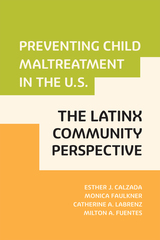 Preventing Child Maltreatment in the U.S.: The Latinx Community Perspective
Esther J. Calzada
Rutgers University Press, 2022 This book is part of a concentrated series of books that examines child maltreatment across cultural groups. Specifically, this volume examines core concepts relevant to Latinx families (e.g., familismo, acculturation, spirituality, oppression) as they relate to child maltreatment in the United States. While there are vast differences across Latinx families, authors use critical race and feminist theories to explore the impact of differences based on gender, race, immigration status, and country of origin. The book begins by contextualizing child maltreatment in Latinx families within the pervasive structural racism and inequality in the United States and addressing unique traumas experienced by Latinx families resulting from that inequity. Subsequent chapters address prevention of child maltreatment, responses to maltreatment and healing from trauma with an emphasis on resilience within the Latinx community. Three case studies are used to illustrate and apply concepts from each chapter.
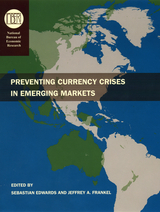 Preventing Currency Crises in Emerging Markets
Edited by Sebastian Edwards and Jeffrey A. Frankel
University of Chicago Press, 2002 Economists and policymakers are still trying to understand the lessons recent financial crises in Asia and other emerging market countries hold for the future of the global financial system. In this timely and important volume, distinguished academics, officials in multilateral organizations, and public and private sector economists explore the causes of and effective policy responses to international currency crises.
Topics covered include exchange rate regimes, contagion (transmission of currency crises across countries), the current account of the balance of payments, the role of private sector investors and of speculators, the reaction of the official sector (including the multilaterals), capital controls, bank supervision and weaknesses, and the roles of cronyism, corruption, and large players (including hedge funds).
Ably balancing detailed case studies, cross-country comparisons, and theoretical concerns, this book will make a major contribution to ongoing efforts to understand and prevent international currency crises.
 Preventing Prenatal Harm: Should the State Intervene? Second Edition
Deborah Mathieu
Georgetown University Press, 1996 Arguing that the state must meet strict conditions to justify interfering in at-risk pregnancies, Deborah Mathieu examines the legal and ethical concerns that arise when governments mandate the behavior of pregnant women. She explores both the pregnant woman's right to decide what happens to her body and the future child's right to be protected from avoidable damage. Mathieu addresses such topics as reproductive hazards in the workplace, mandated fetal therapy, forced lifestyle changes for pregnant women, and the future child's right to sue for lack of prenatal care. The controversy raises key issues of rights, duties, and the scope of legitimate state action, thus posing fundamental challenges to the fields of medicine, biomedical ethics, law, and public policy. This edition has been completely updated and expanded. Mathieu presents new arguments for acceptable types of state intervention and provides specific examples. This edition also incorporates recent court decisions, especially cases involving substance abuse. The book includes both an updated bibliography and an updated reference list of relevant court cases.
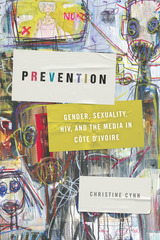 Prevention: Gender, Sexuality, HIV, and the Media in Côte d'Ivoire
Christine Cynn
Ohio State University Press, 2018 Approximately 70% of the global total of people living with HIV/AIDS in 2016 were in sub-Saharan Africa. After delayed governmental responses, the media has been consistently deployed as an essential tool for prevention. But HIV prevention campaigns reflect multiple conflicting and shifting agendas that encompass far more than the imparting of information about how to limit the spread of the virus. In Prevention: Gender, Sexuality, HIV, and the Media in Côte d’Ivoire, Christine Cynn draws from postcolonial, queer, and feminist film and media studies to critique global HIV prevention efforts and how they attempt to reshape gendered sexualities and notions of family in line with the rationality of neoliberalism.
More specifically, Cynn argues that through the bolstering of normative conceptions of gendered sexualities and families, HIV prevention media campaigns seek to actively create proper subjects, a goal corresponding with nation-building projects and reproducing their terms of belonging. During periods of increasingly virulent political and economic struggles in Côte d’Ivoire, such HIV prevention messages have lent support to lender- and state-mandated structural adjustment policies and to the exclusionary logic that casts some—such as those suffering from AIDS-related illnesses, those labeled as “homosexual,” sex workers, intravenous drug users, and the HIV-positive child—as implicitly unassimilable to the community and nation. Deeply interdisciplinary, Prevention brings to light new forms of exclusion and expands scholarship on gender and sexual normativities as it intersects with that on public health, neoliberalism, and film and media.
Preview 2001+: Popular Culture Studies in the Future
Ray B. Browne
University of Wisconsin Press, 1995 The essays in this collection, written by some of the leading scholars in Popular Culture Studies, turn the page on the new millennium to see what are the directions of approach and the opportunities to be gained in recognition of the compelling need for studies in everyday cultures.
 Previously Owned
Nathan McClain
Four Way Books, 2022 In his daring sophomore collection, Nathan McClain interrogates his speaker's American heritage, history, and responsibility. Investigating myth, popular culture, governance, and more, Previously Owned connects a villanelle cataloging Sisyphus's circular workflow to a Die Hard persona poem critiquing police brutality and joins complex pastorals to the stunning sequence entitled "They said I was an alternate," which recounts the author's experience serving on jury duty. Though McClain's muscular lyric explores a wide range of topics, the intensity of his attention and the profundity of his care remain constant-the final page describes a young girl in a diner, ringing the bell at the host stand, "just to hear it sing, the same / song, the only song // it knows." Insofar as this collection scrutinizes one's own culpability and responsibility in this country, interested in the natural world and beauty, as well as what beauty distracts us from, it does so in the hopes of reimagining inheritance, of leaving our children a different song.
A Price Below Rubies: Jewish Women as Rebels and Radicals
Naomi Shepherd
Harvard University Press Why, in the late nineteenth century, did Jewish women suddenly march en masse into the pages of radical history? A Price Below Rubies explores this question and introduces us to these women—particularly, Anna Kuliscioff, Rosa Luxemburg, Esther Frumkin, Manya Shochat, Bertha Pappenheim, Rose Pesotta, and Emma Goldman. Naomi Shepherd’s collective biography of these seven women and others tells the story of a revolution that began at home, in communities whose limits stirred women to rebel.
Price Index Concepts and Measurement
Edited by W. Erwin Diewert, John Greenlees, and Charles R. Hulten
University of Chicago Press, 2009 Although inflation is much feared for its negative effects on the economy, how to measure it is a matter of considerable debate that has important implications for interest rates, monetary supply, and investment and spending decisions. Underlying many of these issues is the concept of the Cost-of-Living Index (COLI) and its controversial role as the methodological foundation for the Consumer Price Index (CPI). Price Index Concepts and Measurements brings together leading experts to address the many questions involved in conceptualizing and measuring inflation. They evaluate the accuracy of COLI, a Cost-of-Goods Index, and a variety of other methodological frameworks as the bases for consumer price construction.
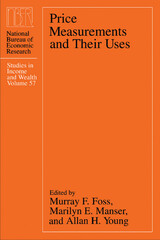 Price Measurements and Their Uses
Edited by Murray F. Foss, Marilyn E. Manser, and Allan H. Young
University of Chicago Press, 1993 In an economy characterized by frequent change in technology, in the types of goods and services purchased, and in the forms of business organization, keeping track of price change continues to pose many difficulties. Price change affects the way we perceive changes in such basic measures as real output, productivity, and living standards. This volume, which brings together academic economists with those responsible for official price indexes, presents outstanding new research on price measurement.
Half of the papers focus on prices for mainframe and personal computers, semiconductors, and other high-tech products, using mainly hedonic techniques. The volume includes a panel discussion by distinguished economists about the theoretical and practical considerations of how best to measure price change of capital goods whose quality is changing rapidly. The authors also present new research on more conventional but still unsettled problems in the price field affecting both the consumer and producer price indexes of the Bureau of Labor Statistics.
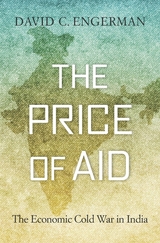 The Price of Aid: The Economic Cold War in India
David C. Engerman
Harvard University Press, 2018 “A superb, field-changing book…A true classic.”
—Sunil Amrith
“Makes a major contribution towards a necessary discussion of the politics of aid.”
—Times Higher Education
Debates over foreign aid are often strangely ahistorical. Economists argue about effectiveness—how to make aid work—while critics bemoan money wasted on corruption, ignoring the fundamentally political character of aid. The Price of Aid exposes the geopolitical calculus underpinning development assistance, and its costs.
India stood at the center of American and Soviet aid competition throughout the Cold War, as both superpowers saw developmental aid as a way of pursuing their geopolitical goals by economic means. Drawing on recently declassified files from seven countries, David Engerman shows how Indian leaders used Cold War competition to win battles at home, eroding the Indian state in the process. As China spends freely in Africa, the political stakes of foreign aid are rising once again.
“A magnificent book. Anyone who seeks to understand contemporary India and its development struggles will have to start here. Engerman’s work is not only enlightening, it turns much of what we thought we knew about India, foreign aid, and the Cold War in South Asia upside down.”
—O. A. Westad, author of The Cold War
“An outstanding history…Drawing on an unprecedented array of official and private archives in India, Russia, the United States, and Britain, Engerman offers a superb account—one that integrates the ideologies and policies of the superpowers with a sharp analysis of the push-and-pull of policymaking in India. This is a landmark study of independent India as well as the Cold War.”
—Srinath Raghavan, author of India’s War
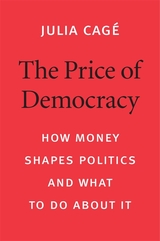 The Price of Democracy: How Money Shapes Politics and What to Do about It
Julia Cagé
Harvard University Press, 2020 Why and how systems of political financing and representation in Europe and North America give outsized influence to the wealthy and undermine democracy, and what we can do about it.
One person, one vote. In theory, everyone in a democracy has equal power to decide elections. But it’s hardly news that, in reality, political outcomes are heavily determined by the logic of one dollar, one vote. We take the political power of money for granted. But does it have to be this way? In The Price of Democracy, Julia Cagé combines economic and historical analysis with political theory to show how profoundly our systems in North America and Europe, from think tanks and the media to election campaigns, are shaped by money. She proposes fundamental reforms to bring democracy back into line with its egalitarian promise.
Cagé shows how different countries have tried to develop legislation to curb the power of private money and to develop public systems to fund campaigns and parties. But these attempts have been incoherent and unsystematic. She demonstrates that it is possible to learn from these experiments in the United States, Europe, and elsewhere to design a better system that would increase political participation and trust. This would involve setting a strict cap on private donations and creating a public voucher system to give each voter an equal amount to spend in support of political parties. More radically, Cagé argues that a significant fraction of seats in parliamentary assemblies should be set aside for representatives from disadvantaged socioeconomic groups.
At a time of widespread political disenchantment, The Price of Democracy is a bracing reminder of the problems we face and an inspirational guide to the potential for reform.
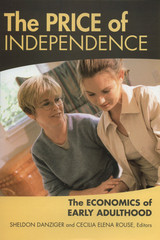 The Price of Independence: The Economics of Early Adulthood
Sheldon Danziger
Russell Sage Foundation, 2007 More and more young men and women today are taking longer and having more difficulty making a successful transition to adulthood. They are staying in school longer, having a harder time finding steady employment at jobs that provide health insurance, and are not marrying and having children until much later in life than their parents did. In The Price of Independence, a roster of distinguished experts diagnose the extent and causes of these trends. Observers of social trends have speculated on the economic changes that may be delaying the transition to adulthood—from worsening job opportunities to mounting student debt and higher housing costs—but few have offered empirical evidence to back up their claims. The Price of Independence represents the first significant analysis of these economic explanations, charting the evolving life circumstances of eighteen to thirty-five year-olds over the last few decades. Lisa Bell, Gary Burtless, Janet Gornick, and Timothy M. Smeeding show that the earnings of young workers in the United States and a number of industrialized countries have declined relative to the cost of supporting a family, which may explain their protracted dependence. In addition, Henry Farber finds that job stability for young male workers has dropped over the last generation. But while economic factors have some influence on young people's transitions to adulthood, The Price of Independence shows that changes in the economic climate can not account for the magnitude of the societal shift in the timing of independent living, marriage, and childbearing. Aaron Yelowitz debunks the myth that steep housing prices are forcing the young to live at home—housing costs actually fell between 1980 and 2000 once lower interest rates and tax subsidies are taken into account. And Ngina Chiteji reveals that average student loan debt is only $3,500 per household. The trend toward starting careers and families later appears to have more to do with changing social norms, as well as policies that have broadened access to higher education, than with changes in the economy. For better or worse, the current generation is redefining the nature and boundaries of what it means to be a young adult. The Price of Independence documents just how dramatically the modern lifecycle has changed and offers evidence as an antidote to much of the conventional wisdom about these social changes.
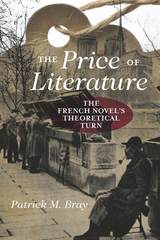 The Price of Literature: The French Novel's Theoretical Turn
Patrick M. Bray
Northwestern University Press, 2019 The Price of Literature examines the presence of theory in the nineteenth-century French novel, something Proust likened to leaving a price tag on a gift. Emerging after the French Revolution, what we now call literature was conceived as an art liberated from representational constraints. Patrick M. Bray shows how literature’s freedom to represent anything at all has meant, paradoxically, that it cannot articulate a coherent theory of itself—unless this theory is a necessarily subversive literary representation, or “the novel’s theoretical turn.”
Literary thought, or the theory produced by the text, can only function by exploring what escapes dominant representations. The Price of Literature analyzes how certain iconic texts from the nineteenth century (by Mme de Staël, Hugo, Balzac, Flaubert, and Proust) perform a theoretical turn to claim the freedom to represent anything in the world, but also literature’s ability to transform the world it represents. The conclusion advances a new way of thinking about literary scholarship—one based on how literature redistributes ways of writing by lending form to thought.
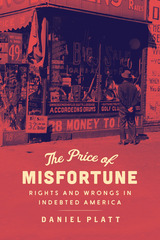 The Price of Misfortune: Rights and Wrongs in Indebted America
Daniel Platt
University of Chicago Press, 2023 A history of the struggle for debtors’ rights from the Civil War to the Great Depression
What can be taken from someone who has borrowed money and cannot repay? What do the victims of misfortune owe to their lenders, and what can they keep for themselves? The answers to those questions, immensely important for debtors, creditors, and society at large, have changed over time. The Price of Misfortune examines the cause of debtors’ rights in the modern United States and the struggles of reformers who fought to establish financial freedoms in law.
Daniel Platt shows how, in the wake of the Civil War, a range of advocates drew potent analogies between slavery, imprisonment for debt, and the experiences of wage garnishment and property foreclosure. He traces the ways those analogies were used to campaign for bold new protections for debtors, keeping them secure in their labor, property, and personhood. Yet, as Platt demonstrates, those reforms tended to assume as their ideal borrower someone who was white, propertied, and male. In subsequent decades, the emancipatory promise of debtors’ rights would be tested as women, wage earners, and African Americans seized on their language to challenge other structural inequalities: the dependency of marriage, the exploitation of industrial capitalism, and the oppression of Jim Crow. By reconstructing these forgotten developments—and recovering the experiences of indebted farmwives, sharecroppers, and wage workers—The Price of Misfortune narrates a new history of inequality, coercion, and law amid the early financialization of American capitalism.
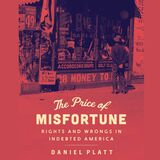 The Price of Misfortune: Rights and Wrongs in Indebted America
Daniel Platt
University of Chicago Press, 2023 This is an auto-narrated audiobook version of this book.
A history of the struggle for debtors’ rights from the Civil War to the Great Depression
What can be taken from someone who has borrowed money and cannot repay? What do the victims of misfortune owe to their lenders, and what can they keep for themselves? The answers to those questions, immensely important for debtors, creditors, and society at large, have changed over time. The Price of Misfortune examines the cause of debtors’ rights in the modern United States and the struggles of reformers who fought to establish financial freedoms in law.
Daniel Platt shows how, in the wake of the Civil War, a range of advocates drew potent analogies between slavery, imprisonment for debt, and the experiences of wage garnishment and property foreclosure. He traces the ways those analogies were used to campaign for bold new protections for debtors, keeping them secure in their labor, property, and personhood. Yet, as Platt demonstrates, those reforms tended to assume as their ideal borrower someone who was white, propertied, and male. In subsequent decades, the emancipatory promise of debtors’ rights would be tested as women, wage earners, and African Americans seized on their language to challenge other structural inequalities: the dependency of marriage, the exploitation of industrial capitalism, and the oppression of Jim Crow. By reconstructing these forgotten developments—and recovering the experiences of indebted farmwives, sharecroppers, and wage workers—The Price of Misfortune narrates a new history of inequality, coercion, and law amid the early financialization of American capitalism.
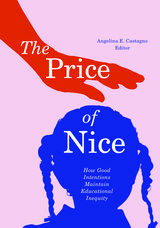 The Price of Nice: How Good Intentions Maintain Educational Inequity
Angelina E. Castagno
University of Minnesota Press, 2019 How being “nice” in school and university settings works to reinforce racialized, gendered, and (dis)ability-related inequities in education and society Being nice is difficult to critique. Niceness is almost always portrayed and felt as a positive quality. In schools, nice teachers are popular among students, parents, and administrators. And yet Niceness, as a distinct set of practices and discourses, is not actually good for individuals, institutions, or communities because of the way it maintains and reinforces educational inequity. In The Price of Nice, an interdisciplinary group of scholars explores Niceness in educational spaces from elementary schools through higher education to highlight how this seemingly benign quality reinforces structural inequalities. Grounded in data, personal narrative, and theory, the chapters show that Niceness, as a raced, gendered, and classed set of behaviors, functions both as a shield to save educators from having to do the hard work of dismantling inequity and as a disciplining agent for those who attempt or even consider disrupting structures and ideologies of dominance. Contributors: Sarah Abuwandi, Arizona State U; Colin Ben, U of Utah; Nicholas Bustamante, Arizona State U; Aidan/Amanda J. Charles, Northern Arizona U; Jeremiah Chin, Arizona State U; Sally Campbell Galman, U of Massachusetts; Frederick Gooding Jr., Texas Christian U; Deirdre Judge, Tufts U; Katie A. Lazdowski; Román Liera, U of Southern California; Sylvia Mac, U of La Verne; Lindsey Malcolm-Piqueux, California Institute of Technology; Giselle Martinez Negrette, U of Wisconsin–Madison; Amber Poleviyuma, Arizona State U; Alexus Richmond, Arizona State U; Frances J. Riemer, Northern Arizona U; Jessica Sierk, St. Lawrence U; Bailey B. Smolarek, U of Wisconsin–Madison; Jessica Solyom, Arizona State U; Megan Tom, Arizona State U; Sabina Vaught, U of Oklahoma; Cynthia Diana Villarreal, U of Southern California; Kristine T. Weatherston, Temple U; Joseph C. Wegwert, Northern Arizona U; Marguerite Anne Fillion Wilson, Binghamton U; Jia-Hui Stefanie Wong, Trinity College; Denise Gray Yull, Binghamton U.
 The Price of Nuclear Power: Uranium Communities and Environmental Justice
Malin, Stephanie A.
Rutgers University Press, 2015 Rising fossil fuel prices and concerns about greenhouse gas emissions are fostering a nuclear power renaissance and a revitalized uranium mining industry across the American West. In The Price of Nuclear Power, environmental sociologist Stephanie Malin offers an on-the-ground portrait of several uranium communities caught between the harmful legacy of previous mining booms and the potential promise of new economic development. Using this context, she examines how shifting notions of environmental justice inspire divergent views about nuclear power’s sustainability and equally divisive forms of social activism. Drawing on extensive fieldwork conducted in rural isolated towns such as Monticello, Utah, and Nucla and Naturita, Colorado, as well as in upscale communities like Telluride, Colorado, and incorporating interviews with community leaders, environmental activists, radiation regulators, and mining executives, Malin uncovers a fundamental paradox of the nuclear renaissance: the communities most hurt by uranium’s legacy—such as high rates of cancers, respiratory ailments, and reproductive disorders—were actually quick to support industry renewal. She shows that many impoverished communities support mining not only because of the employment opportunities, but also out of a personal identification with uranium, a sense of patriotism, and new notions of environmentalism. But other communities, such as Telluride, have become sites of resistance, skeptical of industry and government promises of safe mining, fearing that regulatory enforcement won’t be strong enough. Indeed, Malin shows that the nuclear renaissance has exacerbated social divisions across the Colorado Plateau, threatening social cohesion. Malin further illustrates ways in which renewed uranium production is not a socially sustainable form of energy development for rural communities, as it is utterly dependent on unstable global markets.
The Price of Nuclear Power is an insightful portrait of the local impact of the nuclear renaissance and the social and environmental tensions inherent in the rebirth of uranium mining.
 The Price of Our Values: The Economic Limits of Moral Life
Augustin Landier and David Thesmar
University of Chicago Press, 2025 The economic case for self-interest at the outer limits of being morally good. Modern life is an exercise in discomfort. In the face of endless injustice, how much selfishness is permissible? How do we square suffering elsewhere with our hope to thrive at home? How does one strive for the greater good while guarding one's personal interests? The Price of Our Values argues that the answers to these questions are economic: by weighing our sense of the personal costs associated with the outer limits of our moral beliefs. These tradeoffs—the want to be good, the personal costs of being good, and the points at which people abandon goodness due to its costs—are somewhat unsettling. But as economists Augustin Landier and David Thesmar show, they are highly predictable, even justified. Our values guide us, but we are also forced to consider economic costs to settle decisions. The Price of Our Values is an economic reckoning with the universal unease of contemporary moral life. Wielding insights from the philosophical founders of the field, Landier and Thesmar provide frameworks for thinking about the place of values—justice, freedom, beauty— in the decisions of modern life. They do so in terms that seek to be consistent with both our good intentions and their limits.
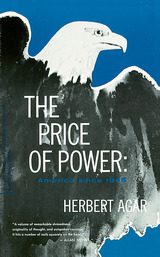 The Price of Power: America Since 1945
Herbert Agar
University of Chicago Press, 1957 Once the sword of power has been drawn, it can never again be sheathed. That is the lesson the United States has been learning ever since she emerged from World War II as one of the great world powers. This central issue dominates Herbert Agar's exciting narrative history of the first twelve years of American world responsibility. He reviews the events and crises that have marked postwar history—the Yalta and Potsdam conferences, the Berlin airlift, the Eightieth Congress and Truman's election, the Hiss case, the collapse of Nationalist China, the McCarthy hearings, the atom and hydrogen bombs, McCarthy's "retirement," and Eisenhower's first election. In the great tradition of journalism and history, Mr. Agar has based his writings on close observation of recent world events and on his acquaintance with the people who have participated in them. He presents a vigorous and brilliant interpretation of the difficult years of America's coming of age in the field of international politics and diplomacy and a candid evaluation of the price America must pay as the world's most powerful nation.
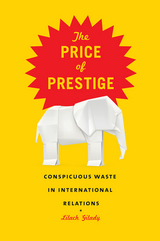 The Price of Prestige: Conspicuous Consumption in International Relations
Lilach Gilady
University of Chicago Press, 2018 If wars are costly and risky to both sides, why do they occur? Why engage in an arms race when it’s clear that increasing one’s own defense expenditures will only trigger a similar reaction by the other side, leaving both countries just as insecure—and considerably poorer? Just as people buy expensive things precisely because they are more expensive, because they offer the possibility of improved social status or prestige, so too do countries, argues Lilach Gilady.
In The Price of Prestige, Gilady shows how many seemingly wasteful government expenditures that appear to contradict the laws of demand actually follow the pattern for what are known as Veblen goods, or positional goods for which demand increases alongside price, even when cheaper substitutes are readily available. From flashy space programs to costly weapons systems a country does not need and cannot maintain to foreign aid programs that offer little benefit to recipients, these conspicuous and strategically timed expenditures are intended to instill awe in the observer through their wasteful might. And underestimating the important social role of excess has serious policy implications. Increasing the cost of war, for example, may not always be an effective tool for preventing it, Gilady argues, nor does decreasing the cost of weapons and other technologies of war necessarily increase the potential for conflict, as shown by the case of a cheap fighter plane whose price tag drove consumers away. In today’s changing world, where there are high levels of uncertainty about the distribution of power, Gilady also offers a valuable way to predict which countries are most likely to be concerned about their position and therefore adopt costly, excessive policies.
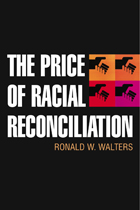 The Price of Racial Reconciliation
Ronald W. Walters
University of Michigan Press, 2008 “In The Price of Racial Reconciliation, Ronald Walters offers an abundance of riches. This book provides an extraordinarily comprehensive and persuasive set of arguments for reparations, and will be the lens through which meaningful opportunities for reconciliation are viewed in the future. If this book does not lead to the success of the reparations movement, nothing will.” —Charles J. Ogletree, Jesse Climenko Professor of Law, Harvard Law School “The Price of Racial Reconciliation is a seminal study of comparative histories and race(ism) in the formation of state structures that prefigure(d) socioeconomic positions of Black peoples in South Africa and the United States. The scholarship is meticulous in brilliantly constructed analysis of the politics of memory, reparations as an immutable principle of justice, imperative for nonracial(ist) democracy, and a regime of racial reconciliation.” —James Turner, Professor of African and African American Studies and Founder, Africana Studies and Research Center, Cornell University “A fascinating and pathbreaking analysis of the attempt at racial reconciliation in South Africa which asks if that model is relevant to the contemporary American racial dilemma. An engaging multidisciplinary approach relevant to philosophy, sociology, history, and political science.” —William Strickland, Associate Professor of Political Science, W.E.B. Du Bois Department of Afro-American Studies, University of Massachusetts Amherst The issue of reparations in America provokes a lot of interest, but the public debate usually occurs at the level of historical accounting: “Who owes what for slavery?” This book attempts to get past that question to address racial restitution within the framework of larger societal interests. For example, the answer to the “why reparations?” question is more than the moral of payment for an injustice done in the past. Ronald Walters suggests that, insofar as the impact of slavery is still very much with us today and has been reinforced by forms of postslavery oppression, the objective of racial harmony will be disrupted unless it is recognized with the solemnity and amelioration it deserves. The author concludes that the grand narrative of black oppression in the United States—which contains the past and present summary of the black experience—prevents racial reconciliation as long as some substantial form of racial restitution is not seriously considered. This is “the price” of reconciliation. The method for achieving this finding is grounded in comparative politics, where the analyses of institutions and political behaviors are standard approaches. The author presents the conceptual difficulties involved in the project of racial reconciliation by comparing South African Truth and Reconciliation and the demand for reparations in the United States. Ronald Walters is Distinguished Leadership Scholar and Director, African American Leadership Program and Professor of Government and Politics, University of Maryland.
 The Price of Safety: Hidden Costs and Unintended Consequences for Women in the Domestic Violence Service System
Sara Shoener
Vanderbilt University Press, 2017 Specialized public resources for survivors of intimate partner violence (IPV) are increasingly common and diverse--from protection order courts and dedicated domestic violence units in police precincts to a vast network of community-based emergency shelters and counseling services. Yet little consensus exists regarding which resources actually work to reduce violence and help survivors lead the lives they would like to live. This book is an account of these resources and IPV survivors' experiences with them in three communities in the United States.
Through detailed observations of services such as court procedures, public benefits processes, and community-based IPV programs as well as in-depth interviews with dozens of IPV survivors and practitioners, Shoener describes how our current institutional response to IPV is often not useful--and sometimes quite harmful--for IPV survivors with the least material, social, and cultural capital to spare. For these women, as the interviews vividly record, IPV has long-term economic and social consequences, disrupting career paths and creating social isolation.
The Price of Three Stories: Rare Folktales from Japan
Hiroko Fujita & Fran Stallings
Parkhurst Brothers, Inc., 2015 “This delightful compendium of short, savory, and highly tellable tales embodies the beliefs and folkways of rural Japan—specifically the area most impacted by the recent tsunami and nuclear disaster. It adds immeasurably to our insight into that endangered world.” —Joseph Sobol, Ph.D., director, ETSU Storytelling Graduate Program
A Price to Pay
Alex Capus
Haus Publishing, 2014 Alex Capus’s novels have been runaway best-sellers in Germany, and his novel Léon and Louise received widespread critical acclaim on its English publication in 2012.
A Price to Pay, the fourth of Capus’s novels to be published in English, tells the interwoven stories of three disparate figures from interwar Switzerland: pacifist Felix Bloch, who ends up working on the Manhattan Project; Laura d’Oriano, who wants to become a singer but instead becomes an Allied spy in fascist Italy; and Emile Gillieron, who accompanies Heinrich Schliemann to Troy and becomes one of art’s greatest forgers. Taking off from the only moment in history when all three were in the same place—a November day in 1924 at Zürich Station—Capus traces their diverging paths as they secure their places in the annals of history—but at what price?
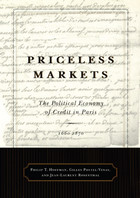 Priceless Markets: The Political Economy of Credit in Paris, 1660-1870
Philip T. Hoffman, Gilles Postel-Vinay, and Jean-Laurent Rosenthal
University of Chicago Press, 2000 This pathbreaking book shows how credit markets functioned in Paris, through the agency of notaries, during a critical period of French history. Its authors challenge the usual assumption that organized financial markets—and hence the opportunity for economic growth—did not emerge outside of England and the Netherlands until the nineteenth century. Drawing on innovative research, the authors show that as early as the Old Regime, financial intermediaries in France were mobilizing a great tide of capital and arranging thousands of loans between borrowers and lenders.
The implications for historians and economists are substantial. The role of notaries operating in Paris that Priceless Markets uncovers has never before been recognized. In the wake of this pathbreaking new study, historians will also have to rethink the origins of the French Revolution. As the authors show, the crisis of 1787-88 did not simply ignite revolt; it was intimately bound up in an economic struggle that reached far back into the eighteenth century, and continued well into the 1800s.
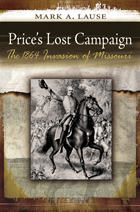 Price's Lost Campaign: The 1864 Invasion of Missouri
Mark A. Lause
University of Missouri Press, 2013 In the fall of 1864, during the last brutal months of the Civil War, the Confederates made one final, desperate attempt to rampage through the Shenandoah Valley, Tennessee, and Missouri. Price’s Raid was the common name for the Missouri campaign led by General Sterling Price. Involving tens of thousands of armed men, the 1864 Missouri campaign has too long remained unexamined by a book-length modern study, but now, Civil War scholar Mark A. Lause fills this long-standing gap in the literature, providing keen insights on the problems encountered during and the myths propagated about this campaign. Price marched Confederate troops 1,500 miles into Missouri, five times as far as his Union counterparts who met him in the incursion. Along the way, he picked up additional troops; the most exaggerated estimates place Price’s troop numbers at 15,000. The Federal forces initially underestimated the numbers heading for Missouri and then called in troops from Illinois and Kansas, amassing 65,000 to 75,000 troops and militia members. The Union tried to downplay its underestimation of the Confederate buildup of troops by supplanting the term campaign with the impromptu raid. This term was also used by Confederates to minimize their lack of military success. The Confederates, believing that Missourians wanted liberation from Union forces, had planned a two-phase campaign. They intended not only to disrupt the functioning government through seizure of St. Louis and the capital, Jefferson City, but also to restore the pro-secessionist government driven from the state three years before. The primary objective, however, was to change the outcome of the Federal elections that fall, encouraging votes against the Republicans who incorporated ending slavery into the Union war goals. What followed was widespread uncontrolled brutality in the form of guerrilla warfare, which drove support for the Federalists. Missouri joined Kansas in reelecting the Republicans and ensuring the end of slavery. Lause’s account of the Missouri campaign of 1864 brings new understanding of the two distinct phases of the campaign, as based upon declared strategic goals. Additionally, as the author reveals the clear connection between the military campaign and the outcome of the election, he successfully tests the efforts of new military historians to integrate political, economic, social, and cultural history into the study of warfare. In showing how both sides during Price’s Raid used self-serving fictions to provide a rationale for their politically motivated brutality and were unwilling to risk defeat, Lause reveals the underlying nature of the American Civil War as a modern war.
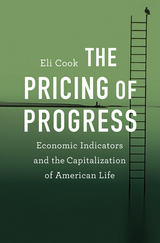 The Pricing of Progress: Economic Indicators and the Capitalization of American Life
Eli Cook
Harvard University Press, 2017 How did Americans come to quantify their society’s progress and well-being in units of money? In today’s GDP-run world, prices are the standard measure of not only our goods and commodities but our environment, our communities, our nation, even our self-worth. The Pricing of Progress traces the long history of how and why we moderns adopted the monetizing values and valuations of capitalism as an indicator of human prosperity while losing sight of earlier social and moral metrics that did not put a price on everyday life.
Eli Cook roots the rise of economic indicators in the emergence of modern capitalism and the contested history of English enclosure, Caribbean slavery, American industrialization, economic thought, and corporate power. He explores how the maximization of market production became the chief objective of American economic and social policy. We see how distinctly capitalist quantification techniques used to manage or invest in railroad corporations, textile factories, real estate holdings, or cotton plantations escaped the confines of the business world and seeped into every nook and cranny of society. As economic elites quantified the nation as a for-profit, capitalized investment, the progress of its inhabitants, free or enslaved, came to be valued according to their moneymaking abilities.
Today as in the nineteenth century, political struggles rage over who gets to determine the statistical yardsticks used to gauge the “health” of our economy and nation. The Pricing of Progress helps us grasp the limits and dangers of entrusting economic indicators to measure social welfare and moral goals.
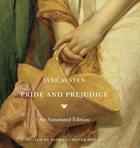 Pride and Prejudice: An Annotated Edition
Jane Austen
Harvard University Press, 2010 “Jane Austen lovers worldwide will cherish these books...Prepare yourself for a major treat.”
—Christian Science Monitor
Handsome enough to tempt.
Pride and Prejudice is Jane Austen’s most beloved novel—a witty, insightful portrait of love, family, and society that has captivated readers for over two centuries. The most successful book of Austen’s career, Pride and Prejudice, has inspired countless adaptations for stage and screen. Experience the romance of the original text as never before with this extraordinary, annotated edition.
For beginners and experts alike—immerse yourself in Jane Austen’s world: For the modern reader, our annotations provide clear explanations and illuminating context for period language and references (from archaic phrases to the mysteries of Georgian dinner parties). For the enthusiast, they offer fresh, exciting analysis—a passionate friend in the margins.
A work of art—the ideal gift: Perfect for gifting, collecting, and cherishing, this grand hardcover (9” x 9.5”) brims with hundreds of full-color illustrations that vividly recreate Austen’s world—its fashions, carriages, libraries, and estates.
The story: “It is a truth universally acknowledged that a single man in possession of a good fortune, must be in want of a wife.” Unable to inherit their family’s estate, the five Bennet sisters must secure their future through marriage. Their mother, the anxious Mrs. Bennet, is determined to see at least one daughter marry well to support the others. As Jane, the eldest daughter, falls for Mr. Bingley—a rich bachelor who owns a neighboring estate—her savvy sister Elizabeth bristles at his less amiable (though considerably wealthier) friend, Mr. Darcy. Through a series of scandals, misunderstandings, and rejected proposals, Elizabeth discovers the truth of Darcy’s character (and earnest love for her).
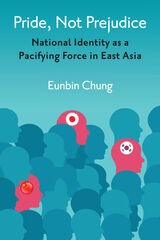 Pride, Not Prejudice: National Identity as a Pacifying Force in East Asia
Eunbin Chung
University of Michigan Press, 2022 As shown by China’s relationship to Japan, and Japan’s relationship to South Korea, even growing regional economic interdependencies are not enough to overcome bitter memories grounded in earlier wars, invasions, and periods of colonial domination. Although efforts to ease historical animosity have been made, few have proven to be successful in Northeast Asia. In previous research scholars anticipated an improvement in relations through thick economic interdependence or increased societal contact. In economic terms, however, Japan and China already trade heavily: Japan has emerged as China’s largest trading partner and China as second largest to Japan. Societal contact is already intense, as millions of Chinese, Koreans, and Japanese visit one another’s countries annually as students, tourists, and on business trips. But these developments have not alleviated international distrust and negative perception, or resolved disagreement on what constitutes “adequate reparation” regarding the countries’ painful history. Noticing clashes of strong nationalisms around the world in areas like Northeast Asia, numerous studies have suggested that more peaceful relations are likely only if countries submerge or paper over existing national identities by promoting universalism. Pride, Not Prejudice argues, to the contrary, that affirmation of national identities may be a more effective way to build international cooperation. If each national population reflects on the values of their national identity, trust and positive perception can increase between countries. This idea is consistent with the theoretical foundation that those who have a clear, secure, and content sense of self, in turn, can be more open, evenhanded, and less defensive toward others. In addition, this reduced defensiveness also enhances guilt admission by past “inflictors” of conflict and colonialism. Eunbin Chung borrows the social psychological theory of self-affirmation and applies it to an international context to argue that affirmation of a national identity, or reflecting on what it means to be part of one’s country, can increase trust, guilt recognition, and positive perception between countries.
The Pride of Jacob: Essays on Jacob Katz and His Work
Jay M. Harris
Harvard University Press, 2002 Jacob Katz (1904–1998) was one of the greatest Jewish historians of the twentieth century. A pioneer of new foci and methods, Katz brought extraordinary insights to many aspects of Jewish life and its surrounding contexts.
With a keen eye for both “forests” and “trees,” Katz transformed our understanding of many areas of Jewish history, among them: Jewish-Christian relations in the Middle Ages, the social-historical significance of Jewish law, the rise of Orthodoxy in Germany and Hungary, and the emergence of modern anti-Semitism. In this volume, ten leading scholars critically discuss Katz’s work with an appreciation for Katz’s importance in reshaping the way Jewish history is studied.
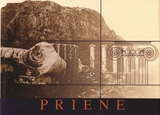 Priene: Second Edition
Nikos A. Dontas
Harvard University Press The Ionian city of Priene, the most extensively excavated Hellenistic city in western Asia Minor, was in its day a model of town planning. It was sited according to principles corresponding to Aristotle's description in the Politics of the ideal city of 5,000, laid out on a grid of the type developed by the famous Hippodamus of the nearby city of Miletus, and ornamented with buildings designed by Pythius, who was known for his holistic approach to architecture. Priene provides the researcher with an unusually clear and complete picture of life in an ancient Greek city of the late Classical and Hellenistic period.
This study, a collaboration of Greek scholars under the scientific direction of Nikos A. Dontas at the Foundation of the Hellenic World and Professor Wolfram Hoepfner of the University of Berlin, first published in 2000 and now appearing in its Second Edition, presents for the first time a comprehensive look at the architecture of the city, combining material from both the first excavation of 1894 and more recent work at the site. It is lavishly illustrated with specially redrawn architectural plans and reconstructions of the major public buildings and spaces as well as residential and commercial structures.
The accompanying text is aimed at both specialist and non-specialist and explores in detail the function and context of these buildings as well as their place in the development of architecture in Asia Minor and the place of Priene in the history of the region.
 Prierias: The Life and Works of Silvestro Mazzolini Da Prierio (1456–1527)
Michael Tavuzzi
Duke University Press, 1997 The Italian Dominican friar Silvestro Mazzolini da Prierio (1456–1527), known as Prierias, is chiefly remembered as the church official designated to respond to Luther’s 95 theses of December 1517—a response blamed for fanning the flames of the Reformation throughout Europe. In Prierias, Michael Tavuzzi presents the first full biography of this little-known, yet eminent, sixteenth-century ecclesiastic, as well as an account of his wide-ranging literary works.
Tavuzzi shows that, aside from being Luther’s first opponent, Prierias played a key role in significant early-sixteenth-century controversies such as the cases of Reuchlin, Erasmus, and Pomponazzi. Drawing on previously untapped primary sources, Tavuzzi traces Prierias’s early career as preacher, professor, inquisitor, and administrator, and places him in the context of the struggles fought between unreformed and observant friars during the Renaissance. Prierias’s activities as Master of the Sacred Palace, his long-standing and bitter conflict with Cardinal Cajetan, and especially his forceful writings warning against the threat of witches and witchcraft are also described. Focusing closely on Prierias’s clash with Luther, Tavuzzi accounts for its development and illuminates the ecclesiological issues at stake. Prierias reveals the little-known world of the friars on the eve of the Reformation.
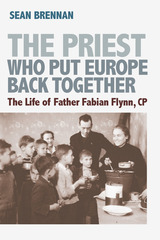 The Priest Who Put Europe Back Together: The Life of Rev. Fabian Flynn, CP
Sean Brennan
Catholic University of America Press, 2018 Philp Fabian Flynn led a remarkable life, bearing witness to some of the most pivotal events of the twentieth century. Flynn took part in the invasions of Sicily and Normandy, the Battle of Aachen, and the Battle of the Hürtgen Forest. He acted as confessor to Nazi War Criminals during the International Military Tribunal at Nuremberg, assisted Hungarian Revolutionaries on the streets of Budapest, and assisted the waves of refugees arriving in Austria feeling the effects of ethnic and political persecution during the Cold War. The Priest Who Put Europe Back Together tells the story of this fascinating life. From solidly middle-class beginnings in Dorchester, Massachusetts, Flynn interacted with and occasionally advised some of the major political, military, and religious leaders of his era. His legacy as a Passionist priest, a chaplain in the US Army, and an official in the Catholic Relief Services was both vast and enormously beneficial. His life and career symbolized the “coming of age” of the United States as a global superpower, and the corresponding growth of the American Catholic Church as an international institution. Both helped liberate half of Europe from Fascist rule, and then helped to rebuild its political, economic, and social foundations, which led to an unprecedented period of peace and prosperity. His efforts on behalf of both his country and his Church to contain Communist influence, and to assist the refugees of its tyranny, contributed to its collapse. Flynn was one of the hundreds of Americans who put Europe back together after a period of horrendous self-destruction. In a twentieth century filled with villains and despots, Flynn played a heroic and vital role in extraordinary times.
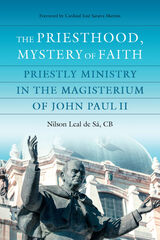 The Priesthood, Mystery of Faith: Priestly Ministry in the Magisterium of John Paul II
Nilson Leal de Sa, CB
Catholic University of America Press, 2022 After almost twenty-seven years of his pontificate, what was John Paul II’s legacy regarding the ministerial priesthood? What answers did he give to the questions still surrounding this reality today? Nilson Leal de Sá, CB, examines the pontiff’s twenty-seven letters of Holy Thursday addressed annually to the priests. Unlike some papal documents, which are drafted by many hands, these letters to priests were born of a personal initiative, wherein the pope spoke ab imo pectore (from the depths of his heart), giving a little of himself and his thought. Cardinal Georges-Marie Cottier, theologian emeritus of the Pontifical House and a connoisseur of the texts of the Holy Father, has confirmed that “the Letters of Holy Thursday were written by John Paul II himself.”
Leal de Sá has sought in the diversity of the letters of Holy Thursday the major points of the thought of John Paul II on this important topic. The first chapter dwells on the sources of his teaching and emphasizes his use of the Word of God, Tradition, and the conciliar Magisterium. These foundations are the basis of the second chapter, which highlights the priestly identity in the life of the Church. Finally, the third chapter elucidates the specific mission of the priest.
The Priesthood, Mystery of Faith presents itself as a real and stimulating synthesis of John Paul II’s thought about the ministerial priesthood in a systematic way. It renews us in the appreciation of the inestimable gift that God makes to the whole Church through the sacrament of the Holy Orders.
Priestly Celibacy
Gary B. Selin
Catholic University of America Press, 2016 Pope Francis has called mandatory priestly celibacy a "gift for the Church," but added "since it is not a dogma, the door is always open" to change. As this Church discipline continues to be debated, it is important for Catholics to delve into the theological and not merely pragmatic reasons behind its continuation. Priestly Celibacy: Theological Foundations, therefore, fills a critical gap in the current theological literature on this important topic of ecclesial ministry and life, and also helps to contribute to the advancement of the rather underdeveloped theology of priestly celibacy.
 The Priestly Kingdom: Social Ethics as Gospel
John Howard Yoder
University of Notre Dame Press, 1985 In this volume of essays John Howard Yoder projects a vision of Christian social ethics rooted in historical community and illuminated by scripture. Drawing upon scriptural accounts of the early church, he demonstrates the Christian community's constant need for reform and change. Yoder first examines the scriptural and theoretical foundations of Christian social ethics. While personally committed to the "radical reformation" tradition, he eschews "denominational" categorization and addresses Christians in general. The status of Christian community, he argues, cannot be separated from the doctrinal content of beliefs and the moral understanding of discipleship. As a result, the Christian's voluntary commitment to a particular community, as distinct from secular society, offers him valuable resources for practical moral reasoning. From a historical perspective, Yoder reviews the efforts of sixteenth-century radical (or Anabaptist) reformers to return to the fundamental ethical standards of the New Testament, and to disengage the community, as a biblically rooted call to faith that does not imply withdrawal from the pluralistic world. Rather, radical commitment to Christianity strengthens and renews the authentic human interests and values of the whole society. His analyses of democracy and of civil religion illustrate how Christianity must challenge and embrace the wider world.
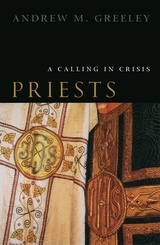 Priests: A Calling in Crisis
Andrew M. Greeley
University of Chicago Press, 2004 For several years now, the Roman Catholic Church and the institution of the priesthood itself have been at the center of a firestorm of controversy. While many of the criticisms lodged against the recent actions of the Church—and a small number of its priests—are justified, the majority of these criticisms are not. Hyperbolic and misleading coverage of recent scandals has created a public image of American priests that bears little relation to reality, and Andrew Greeley's Priests skewers this image with a systematic inside look at American priests today.
No stranger to controversy himself, Greeley here challenges those analysts and the media who parrot them in placing the blame for recent Church scandals on the mandate of celibacy or a clerical culture that supports homosexuality. Drawing upon reliable national survey samples of priests, Greeley demolishes current stereotypes about the percentage of homosexual priests, the level of personal and professional happiness among priests, the role of celibacy in their lives, and many other issues. His findings are more than surprising: they reveal, among other things, that priests report higher levels of personal and professional satisfaction than doctors, lawyers, or faculty members; that they would overwhelmingly choose to become priests again; and that younger priests are far more conservative than their older brethren.
While the picture Greeley paints should radically reorient the public perception of priests, he does not hesitate to criticize the Church's significant shortcomings. Most priests, for example, do not think the sexual abuse problems are serious, and they do not think that poor preaching or liturgy is a problem, though the laity give them very low marks on their ministerial skills. Priests do not listen to the laity, bishops do not listen to priests, and the Vatican does not listen to any of them. With Greeley's statistical evidence and provocative recommendations for change—including a national "Priest Corps" that would offer young men a limited term of service in the Church—Priests offers a new vision for American Catholics, one based on real problems and solutions rather than on images of a depraved, immature, and frustrated priesthood.
 Priests and Cults in the Book of the Twelve
Lena-Sofia Tiemeyer
SBL Press, 2016 Key essays that explore a range of attitudes toward clergy and ritual
This book discusses the depictions of the cult and its personnel in the twelve prophetic books commonly referred to as the Book of the Twelve or the Minor Prophets. The articles in the volume explore the following questions: How did these prophetic writers envision the priests and the Levites? What did they think about the ritual aspects of ancient Israelite faith, including not only the official temple cult in Jerusalem but also cultic expressions outside the capital? What, in their views, characterized a faithful priest and what should the relationship be between his cultic performance and the ways in which he lived his life? How does the message of each individual author fit in with the wider Israelite traditions? Finally, who were these prophetic authors, in which historical contexts did they live and work, and what stylistic tools did they use to communicate their message?
Features:
Essays investigate the ways in which key texts in the Book of the Twelve endorse, criticize, seek to reform, or seek to abolish the cult and clergy
Articles focus on the books of Hosea, Joel, Amos, Zephaniah, Zechariah, and Malachi, but include other texts
Exploration of how the attitudes towards cult and clergy in these key texts tie in with the attitudes found elsewhere in the Book of the Twelve
Primacies: Experience, Expression, and the Jewish Imagination
Michael Fishbane
University of Chicago Press, 2025 A powerful exploration of how literature expresses and transforms our earliest preverbal experiences.
Primacies begins with the assertion that our earliest preverbal experiences are accompanied by a primary language—a universal expression of tears, cries, and laughter offered long before we learn our distinctive, ordinary languages. For Michael Fishbane, these “primacies” release the raw feelings of our existential condition and catalyze our most powerful literary expressions of sorrow, joy, and fulfillment.
In this book, Fishbane explores how ancient, medieval, and modern literature and poetry express and transform these primal sensations. Building on his theological project begun in Sacred Attunement and Fragile Finitude, Fishbane offers here a radically new lived hermeneutics that seeks to do nothing less than redefine the relationship between experience and language.
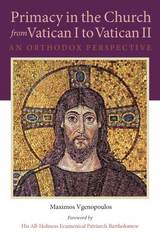 Primacy in the Church from Vatican I to Vatican II: An Orthodox Perspective
Maximos Vgenopoulos
Northern Illinois University Press, 2013 The primacy of the bishop of Rome, the pope, as it was finally shaped in the Middle Ages and later defined by Vatican I and II has been one of the thorniest issues in the history of the Western and Eastern Churches. This issue was a primary cause of the division between the two Churches and the events that followed the schism of 1054: the sack of Constantinople by the crusaders in 1204, the appointment by Pope Innocent III of a Latin patriarch of Constantinople, and the establishment of Uniatism as a method and model of union. Always a topic in ecumenical dialogue, the issue of primacy has appeared to be an insurmountable obstacle to the realization of full unity between Roman Catholicism and the Orthodox Christianity.
In this timely and comprehensive work, Maximos Vgenopoulos analyzes the response of major Orthodox thinkers to the Catholic understanding of the primary of the pope over the last two centuries, showing the strengths and weaknesses of these positions. Covering a broad range of primary and secondary sources and thinkers, Vgenopoulos approaches the issue of primacy with an open and ecumenical manner that looks forward to a way of resolving this most divisive issue between the two Churches. For the first time here the thought of Greek and Russian Orthodox theologians regarding primacy is brought together systematically and compared to demonstrate the emergence of a coherent view of primacy in accordance with the canonical principles of the Orthodox Church. In looking at crucial Greek-language sources Vgenopoulos makes a unique contribution by providing an account of the debate on primacy within the Greek Orthodox Church.
Primacy in the Church from Vatican I to Vatican II is an invaluable resource on the official dialogue taking place between the Orthodox Church and the Roman Catholic Church today. This important book will be of broad interest to historians, theologians, seminarians, and all those interested in Orthodox-Catholic relations.
The Primacy of Perception: And Other Essays on Phenomenological Psychology, the Philosophy of Art, History and Politics
Maurice Merleau-Ponty
Northwestern University Press, 1964 The Primacy of Perception brings together a number of important studies by Maurice Merleau-Ponty that appeared in various publications from 1947 to 1961. The title essay, which is in essence a presentation of the underlying thesis of his Phenomenology of Perception, is followed by two courses given by Merleau-Ponty at the Sorbonne on phenomenological psychology. "Eye and Mind" and the concluding chapters present applications of Merleau-Ponty's ideas to the realms of art, philosophy of history, and politics. Taken together, the studies in this volume provide a systematic introduction to the major themes of Merleau-Ponty's philosophy.
The Primacy of Persons in Politics
John von Heyking
Catholic University of America Press, 2013 Taking as their departure point the political-philosophical analyses of German scholar Tilo Schabert, the philosophical and empirical essays in this volume invite the reader to move beyond the sterile dichotomy of political activity as either pure will or as folded into a more manageable activity.
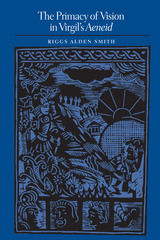 The Primacy of Vision in Virgil's Aeneid
By Riggs Alden Smith
University of Texas Press, 2006 One of the masterpieces of Latin and, indeed, world literature, Virgil's Aeneid was written during the Augustan "renaissance" of architecture, art, and literature that redefined the Roman world in the early years of the empire. This period was marked by a transition from the use of rhetoric as a means of public persuasion to the use of images to display imperial power. Taking a fresh approach to Virgil's epic poem, Riggs Alden Smith argues that the Aeneid fundamentally participates in the Augustan shift from rhetoric to imagery because it gives primacy to vision over speech as the principal means of gathering and conveying information as it recounts the heroic adventures of Aeneas, the legendary founder of Rome. Working from the theories of French phenomenologist Maurice Merleau-Ponty, Smith characterizes Aeneas as a voyant-visible, a person who both sees and is seen and who approaches the world through the faculty of vision. Engaging in close readings of key episodes throughout the poem, Smith shows how Aeneas repeatedly acts on what he sees rather than what he hears. Smith views Aeneas' final act of slaying Turnus, a character associated with the power of oratory, as the victory of vision over rhetoric, a triumph that reflects the ascendancy of visual symbols within Augustan society. Smith's new interpretation of the predominance of vision in the Aeneid makes it plain that Virgil's epic contributes to a new visual culture and a new mythology of Imperial Rome.
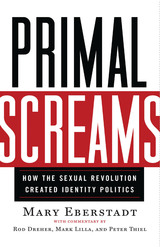 Primal Screams: How the Sexual Revolution Created Identity Politics
Eberstadt, Mary
Templeton Press, 2021 Who am I? The question today haunts every society in the Western world. Legions of people—especially the young—have become unmoored from a firm sense of self. To compensate, they join the ranks of ideological tribes spawned by identity politics and react with frenzy against any perceived threat to their group. As identitarians track and expose the ideologically impure, other citizens face the consequences of their rancor: a litany of “isms” run amok across all levels of cultural life, the free marketplace of ideas muted by agendas shouted through megaphones, and a spirit of general goodwill warped into a state of perpetual outrage. How did we get here? Why have we divided against one another so bitterly? In Primal Screams, acclaimed cultural critic Mary Eberstadt presents the most provocative and original theory to come along in recent years. The rise of identity politics, she argues, is a direct result of the fallout of the sexual revolution, especially the collapse and shrinkage of the family. As Eberstadt illustrates, humans have forged their identities within the kinship structure from time immemorial. The extended family, in a real sense, is the first tribe and teacher. But with its unprecedented decline across various measures, generations of people have been set adrift and can no longer answer the question Who am I? concerning primordial ties. Desperate for solidarity and connection, they claim membership in politicized groups whose displays of frantic irrationalism amount to primal screams for familial and communal loss. Written in her impeccable style and with empathy rarely encountered in today’s divisive discourse, Eberstadt’s theory holds immense explanatory power that no serious citizen can afford to ignore. The book concludes with three incisive essays by Rod Dreher, Mark Lilla, and Peter Thiel, each sharing their perspective on the author’s formidable argument.
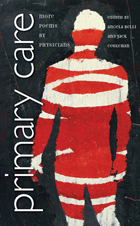 Primary Care: More Poems by Physicians
Angela Belli
University of Iowa Press, 2006 Medicine has always been an emotionally and spiritually challenging profession. Today, confronted with the rapid progress of technology, the shifting sands of health care economics, and glaring disparities in health care and human rights, physicians experience challenges that grow constantly more demanding. As a result, many doctors attempt to build into their lives opportunities for reflection and self-awareness. It is in this context that medical poetry has blossomed.Primary Care, the second anthology of physician poems edited by Angela Belli and Jack Coulehan, proves that the poetry movement in medicine continues to flourish. Fifty-two contemporary physician poets contribute one hundred poems that explore medical practice, interpersonal relationships, and the modern world. Their poems record instances of pain and suffering, joy and grief, humor and irony. Their subjects range from caregivers, patients, trainees, and teachers to poverty, injustice, and war throughout the world.In some cases we find the poets in their professional milieu as they reveal interactions with patients and colleagues. Other poems address private worlds and family relationships. In others the poets turn outward and direct their attention to social and global concerns. Characterized by an immense and kind-hearted sympathy for and empathy with those who are suffering, the poets recognize that everyone’s life is diminished by the trauma of illness and death.
Primary Lessons
Sarah Bracey White
CavanKerry Press, 2013 Ripped from middle-class life in Philadelphia, and transplanted to a single-parent household in the segregated south, Sarah, a precocious black child struggles to be the master of her fate. She refuses to accept the segregation that tries to confine her—a system her mother accepts as the southern way of life. A brave memoir that testifies to the author’s fiery spirit and sense of self that sustained her through family, social and cultural upheavals.
Primary Medical Care in Chile: Accessibility under Military Rule
Joseph L. Scarpaci
University of Pittsburgh Press, 1988 Since Pinochet's regime assumed power in 1973, the Chilean public medical system has been incrementally disassembled in favor of private enterprise, modeled after U.S. HMOs. Scarpaci assembles data ranging from interviews with patients to income statements and balance sheets from the National Health Service System, National Health Fund, and National Statistics Institute to view the financial and cultural impediments imposed by the Pinochet system that have compromised and effectively limited health care accessibility for Chile's adult population.
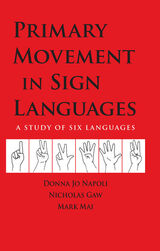 Primary Movement in Sign Languages: A Study of Six Languages
Donna Jo Napoli
Gallaudet University Press, 2011 Is it possible to identify sign languages by their prosody, that is, the rhythm and stress of sign production, and then determine if they are related to each other or other sign languages? If so, reasoned authors Donna Jo Napoli, Mark Mai, and Nicholas Gaw, perhaps they could offer such identification as a new way to typologize, or categorize sign languages by their structural features. Their new collaboration Primary Movement in Sign Languages: A Study of Six Languages traces the process and findings from this unique investigation. Resolving on the direction of movement as the prosodic factor to track, they began their research by comparing five sign languages: American Sign Language (ASL), British Sign Language (BSL), Italian Sign Language (LIS), French Sign Language (LSF), and Australian Sign Language (Auslan). They soon discovered that the languages in their study clustered with respect to several characteristics along genetic lines, with BSL and Auslan contrasting with LSF, LIS, and ASL. They learned that sign languages with the same geographic origin evolved differently when relocated, and they isolated differences in each individual sign language. They compared four of these established sign languages with the newly emerging Nicaraguan Sign Language (NSL), with the exception of ASL due to their past close contact, thereby validating their work as the first study to identify sign language relationships without depending on grammar.
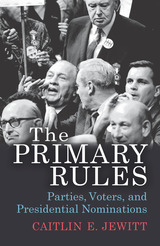 The Primary Rules: Parties, Voters, and Presidential Nominations
Caitlin E. Jewitt
University of Michigan Press, 2019 Reflecting on 2016, it might seem that the national parties have little control over how the presidential nominations unfold and who becomes their presidential candidate. Yet the parties wield more influence than voters in determining who prevails at the National Conventions. Although the reforms of the late 1960s and 1970s gave rank-and-file party members a clear voice in the selection of presidential candidates, the parties retain influence through their ability to set the electoral rules. Despite this capability, party elites do not always fully understand the consequences of the rules and therefore often promote a system that undermines their goals. The Primary Rules illuminates the balance of power that the parties, states, and voters assert on the process. By utilizing an original, comprehensive data set that details the electoral rules each party employed in each state during every nomination from 1976 to 2016, Caitlin E. Jewitt uncovers the effects of the rules on the competitiveness of the nomination, the number of voters who participate, and the nomination outcomes. This reveals how the parties exert influence over their members and limit the impact of voters. The Primary Rules builds on prior analyses and extends work highlighting the role of the parties in the invisible primary stage, as it investigates the parties’ influence once the nominations begin. The Primary Rules provides readers with a clearer sense of what the rules are, how they have changed, their consequences, and practical guidance on how to modify the rules of the nomination system to achieve their desired outcomes in future elections.
Primary Sources on Monsters
Asa Simon Mittman
Arc Humanities Press, 2018 Companion volumes <i>Classic Readings on Monster Theory</i> and <i>Primary Sources on Monsters</i> gather a wide range of readings and sources to enable us to see and understand what monsters can show us about what it means to be human. The first volume introduces important modern theorists of the monstrous and aims to provide interpretive tools and strategies for students to use to grapple with the primary sources in the second volume, which brings together some of the most influential and indicative monster narratives from the West.
 The Primary That Made a President: John F. Kennedy and West Virginia
Robert O. Rupp
University of Tennessee Press, 2020 The 1960 West Virginia presidential primary is arguably the most storied contest in modern American politics. And yet John F. Kennedy traveled the path so quickly from dynamic presidential candidate to martyred national icon that many forget his debt to West Virginia in his quest for the Democratic presidential nomination. In The Primary That Made a President, author Robert O. Rupp returns to 1960 West Virginia, reviewing the momentous contest for signs of the political changes to come.
Besides propelling Kennedy to the Democratic nomination, the West Virginia primary changed the face of politics by advancing religious tolerance, foreshadowing future political campaigns, influencing public policy, and drawing national attention to a misunderstood region. It meant the end of a taboo that kept the Catholic faith out of American politics; the rise of the primary as a political tool for garnering delegate support; the beginning of a nationwide confrontation with Appalachian stereotypes; and the seeds for what would become Kennedy’s War on Poverty. Rupp explores these themes and more to discuss how a small Appalachian state, overwhelmingly poor and Protestant, became a key player in the political future of John F. Kennedy.
The first of its kind among Kennedy biographies or histories of the 1960 election, this book offers a sustained scholarly analysis of the 1960 West Virginia presidential primary and its far-reaching significance for the political climate in the US.
 Primate Conservation Biology
Guy Cowlishaw and Robin I. M. Dunbar
University of Chicago Press, 2000 From the snub-nosed monkeys of China to the mountain gorillas of central Africa, our closest nonhuman relatives are in critical danger worldwide. A recent report, for example, warns that nearly 20 percent of the world's primates may go extinct within the next ten or twenty years. In this book Guy Cowlishaw and Robin Dunbar integrate cutting-edge theoretical advances with practical management priorities to give scientists and policymakers the tools they need to help keep these species from disappearing forever.
Primate Conservation Biology begins with detailed overviews of the diversity, life history, ecology, and behavior of primates and the ways these factors influence primate abundance and distribution. Cowlishaw and Dunbar then discuss the factors that put primates at the greatest risk of extinction, especially habitat disturbance and hunting. The remaining chapters present a comprehensive review of conservation strategies and management practices, highlighting the key issues that must be addressed to protect primates for the future.
 Primate Encounters: Models of Science, Gender, and Society
Edited by Shirley C. Strum and Linda Marie Fedigan
University of Chicago Press, 2000 A provocative collective reflection on primatology and its relations to broader cultural, historical, and social issues, Primate Encounters brings together both scientists and those who study them to investigate precisely what kind of science primatology is.
"[A] fascinating study . . . on how and why ideas about primate society have changed. The volume consists of dialogues among scientists from different disciplines, national traditions, scientific culture, generations, standpoints, and genders. . . . A wonderful reflection on the discipline of primatology and on science in general."—Science Books and Films
"Primate Encounters should be required reading for anyone about to embark on a career in the field. But it equally valuable for its miscellany of opinions, recollections and off-the-cuff remarks, as well as for its thoughtful observations, 'outrageous ravings' and humour (from the elders in the field). It gives us a glimpse of how scientists work together to understand their place in the world."—Deborah L. Mazolillo, Times Literary Supplement
 Primate Life Histories and Socioecology
Edited by Peter M. Kappeler and Michael E. Pereira
University of Chicago Press, 2003 We know a great deal about roles the environment plays in shaping survival, reproductive success, and even social systems among primates. But how do primate life histories affect social systems and vice versa? Do baboons' patterns of growth, for example, help to structure their societies? Does fission-fusion sociality interact with predator pressure to influence the timing of maturation in chimpanzees?
Exploring these issues and many others, the contributors to Primate Life Histories and Socioecology provide the first systematic attempt to understand relationships among primate life histories, ecology, and social behavior conjointly. Topics covered include how primate life histories interact with rates of evolution, predator pressure, and diverse social structures; how the slow maturation of primates affects the behavior of both young and adult caregivers; and reciprocal relationships between large brains and increased social and behavioral complexity. The first collection of its kind, this book will interest a wide range of researchers, from anthropologists and evolutionary biologists to psychologists and ecologists.
Contributors:
Paul-Michael Agapow, Susan C. Alberts, Jeanne Altmann, Robert A. Barton, Nicholas G. Blurton Jones, Robert O. Deaner, Robin I. M. Dunbar, Jörg U. Ganzhorn, Laurie R. Godfrey, Kristen Hawkes, Nick J. B. Isaac, Charles H. Janson, Kate E. Jones, William L. Jungers, Peter M. Kappeler, Susanne Klaus, Phyllis C. Lee, Steven R. Leigh, Robert D. Martin, James F. O'Connell, Sylvia Ortmann, Michael E. Pereira, Andy Purvis, Caroline Ross, Karen E. Samonds, Jutta Schmid, Stephen C. Stearns, Michael R. Sutherland, Carel P. van Schaik, and Andrea J. Webster.
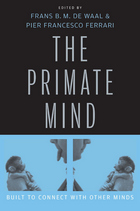 The Primate Mind: Built to Connect with Other Minds
Frans B. M. de Waal
Harvard University Press, 2012 “Monkey see, monkey do” may sound simple, but how an individual perceives and processes the behavior of another is one of the most complex and fascinating questions related to the social life of humans and other primates. In The Primate Mind, experts from around the world take a bottom-up approach to primate social behavior by investigating how the primate mind connects with other minds and exploring the shared neurological basis for imitation, joint action, cooperative behavior, and empathy.
In the past, there has been a tendency to ask all-or-nothing questions, such as whether primates possess a theory of mind, have self-awareness, or have culture. A bottom-up approach asks, rather, what are the underlying cognitive processes of such capacities, some of which may be rather basic and widespread. Prominent neuroscientists, psychologists, ethologists, and primatologists use methods ranging from developmental psychology to neurophysiology and neuroimaging to explore these evolutionary foundations.
A good example is mirror neurons, first discovered in monkeys but also assumed to be present in humans, that enable a fusing between one’s own motor system and the perceived actions of others. This allows individuals to read body language and respond to the emotions of others, interpret their actions and intentions, synchronize and coordinate activities, anticipate the behavior of others, and learn from them. The remarkable social sophistication of primates rests on these basic processes, which are extensively discussed in the pages of this volume.
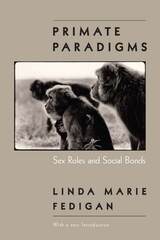 Primate Paradigms: Sex Roles and Social Bonds
Linda Marie Fedigan
University of Chicago Press, 1992 This critical review of behavior patterns in nonhuman primates is an excellent study of the importance of female roles in different social groups and their significance in the evolution of human social life.
"A book that properly illuminates in rich detail not only developmental and socioecological aspects of primate behavior but also how and why certain questions are asked. In addition, the book frequently focuses on insufficiently answered questions, especially those concerned with the evolution of primate sex differences. Fedigan's book is unique . . . because it places primate adaptations and our explanation of those patterns in a larger intellectual framework that is easily and appropriately connected to many lines of research in different fields (sociology, psychology, anthropology, neurobiology, endocrinology, and biology)—and not in inconsequential ways, either."—James McKenna, American Journal of Primatology
"This is the feminist critique of theories of primate and human evolution."—John H. Cook, Nature
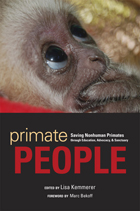 Primate People: Saving Nonhuman Primates through Education, Advocacy, and Sanctuary
Lisa Kemmerer
University of Utah Press, 2012 In the last 30 years the bushmeat trade has led to the slaughter of nearly 90 percent of West Africa’s bonobos, perhaps our closest relatives, and has recently driven Miss Waldron’s red colobus monkey to extinction. Earth was once rich with primates, but every species—except one—is now extinct or endangered because of one primate—Homo sapiens. How have our economic and cultural practices pushed our cousins toward destruction? Would we care more about their fate if we knew something of their individual lives and sufferings? Would we help them if we understood how our choices threaten their existence? This anthology helps to answer these questions. The first section of Primate People introduces forces that threaten nonhuman primates, such as the entertainment and “pet” industries, the bushmeat trade, habitat destruction, and logging. The second section exposes the exploitation of primates in research facilities, including the painful memories of an undercover agent, and suggests models of more enlightened scientific methods. The final section tells the stories of those who lobby for change, educate communities, and tenderly care for our displaced cousins in sanctuaries. Sometimes shocking and disturbing, sometimes poignant and encouraging, Primate People always draws the reader into the lives of nonhuman primates. Activists around the world reveal the antics and pleasures of monkeys, the tendencies and idiosyncrasies of chimpanzees, and the sufferings and fears of macaques. Charming, difficult, sensitive—these testimonies demonstrate that nonhuman primates and human beings are, indeed, closely related. Woven into the anthology’s lucid narratives are the stories of how we harm and create the conditions that endanger primates, and what we can and must do to prevent their ongoing suffering and fast-approaching extinction.
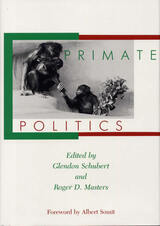 Primate Politics
Edited by Glendon Schubert and Roger D. Masters. Foreword by Albert Somit
Southern Illinois University Press, 1991 The first book to focus on the political behavior of primates also undertakes to compare human social behavior with that of nonhuman primates. The editors contribute probing introductory essays to each of the three major parts of the volume in addition to their article-length introductory and concluding chapters. In his conclusion, Masters indicates directions for future work. Part I is devoted to theoretical clarification of the interrelationships between the study of primates and humans. Part II presents two examples of comparisons between animal and human social behavior that throw valuable light on contemporary political and social systems. Part III focuses more precisely on contemporary human politics, providing two concrete examples of ethological perspectives on human political behavior. In both cases, nonverbal cues studied by primatologists are shown to illuminate the dynamics of human politics. Contributors include: Nicholas G. Blurton-Jones, Frans B. M. de Waal, Basil G. Englis, Jane Goodall, Bruno Latour, Roger D. Masters, Gregory J. McHugo, Elise F. Plate, Thelma E. Rowell, Glendon Schubert, James N. Schubert, Shirley S. Strum, and Denis G. Sullivan.
 Primate Psychology
Dario Maestripieri
Harvard University Press, 2005 In more ways than we may sometimes care to acknowledge, the human being is just another primate--it is certainly only very rarely that researchers into cognition, emotion, personality, and behavior in our species and in other primates come together to compare notes and share insights. This book, one of the few comprehensive attempts at integrating behavioral research into human and nonhuman primates, does precisely that--and in doing so, offers a clear, in-depth look at the mutually enlightening work being done in psychology and primatology.
Relying on theories of behavior derived from psychology rather than ecology or biological anthropology, the authors, internationally known experts in primatology and psychology, focus primarily on social processes in areas including aggression, conflict resolution, sexuality, attachment, parenting, social development and affiliation, cognitive development, social cognition, personality, emotions, vocal and nonvocal communication, cognitive neuroscience, and psychopathology. They show nonhuman primates to be far more complex, cognitively and emotionally, than was once supposed, with provocative implications for our understanding of supposedly unique human characteristics. Arguing that both human and nonhuman primates are distinctive for their wide range of context-sensitive behaviors, their work makes a powerful case for the future integration of human and primate behavioral research.
Primate Societies
Edited by Barbara B. Smuts, Dorothy L. Cheney, Robert M. Seyfarth, Richard W. Wr
University of Chicago Press, 1986 Primate Societies is a synthesis of the most current
information on primate socioecology and its theoretical and
empirical significance, spanning the disciplines of behavioral
biology, ecology, anthropology, and psychology. It is a very rich
source of ideas about other taxa.
"A superb synthesis of knowledge about the social lives of
non-human primates."—Alan Dixson, Nature
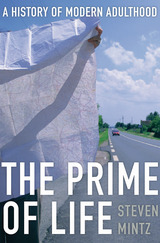 The Prime of Life: A History of Modern Adulthood
Steven Mintz
Harvard University Press, 2015 Adulthood today is undergoing profound transformations. Men and women wait until their thirties to marry, have children, and establish full-time careers, occupying a prolonged period in which they are no longer adolescents but still lack the traditional emblems of adult identity. People at midlife struggle to sustain relationships with friends and partners, to find employment and fulfilling careers, to raise their children successfully, and to resist the aging process.
The Prime of Life puts today’s challenges into new perspective by exploring how past generations navigated the passage to maturity, achieved intimacy and connection, raised children, sought meaning in work, and responded to loss. Coming of age has never been easy or predictable, Steven Mintz shows, and the process has always been shaped by gender and class. But whereas adulthood once meant culturally-prescribed roles and relationships, the social and economic convulsions of the last sixty years have transformed it fundamentally, tearing up these shared scripts and leaving adults to fashion meaning and coherence in an increasingly individualistic culture.
Mintz reconstructs the emotional interior of a life stage too often relegated to self-help books and domestic melodramas. Emphasizing adulthood’s joys and fulfillments as well as its frustrations and regrets, he shows how cultural and historical circumstances have consistently reshaped what it means to be a grown up in contemporary society. The Prime of Life urges us to confront adulthood’s realities with candor and determination and to value and embrace the responsibility, sensible judgment, wisdom, and compassionate understanding it can bring.
Primed for Violence: Murder, Antisemitism, and Democratic Politics in Interwar Poland
Paul Brykczynski
University of Wisconsin Press, 2017 In 1922, the new Republic of Poland democratically elected its first president, Gabriel Narutowicz. Because his supporters included a Jewish political party, an opposing faction of antisemites demanded his resignation. Within hours, bloody riots erupted in Warsaw, and less than a week later the president was assassinated. In the wake of these events, the radical right asserted that only “ethnic Poles” should rule the country, while the left silently capitulated to this demand.
As Paul Brykczynski tells this gripping story, he explores the complex role of antisemitism, nationalism, and violence in Polish politics between the two World Wars. Though focusing on Poland, the book sheds light on the rise of the antisemitic right in Europe and beyond, and on the impact of violence on political culture and discourse.
 Primer
Aaron Smith
University of Pittsburgh Press, 2016 In his third poetry collection, Primer, Aaron Smith grapples with the ugly realities of the private self, in which desire feels more like a trap than fulfillment. What is the face we prepare in our public lives to distract others from our private grief?
Smith's poetry explores that inexplicable tension between what we say and how we actually feel, exposing the complications of intimacy and the limitations of language to bridge those distances between friends, family members, and lovers. What we deny, in the end, may be just what we actually survive.
Mortality in Smith's work remains the uncomfortable foundation at the center of our relationship with others, to faith, to art, to love as we grow older, and ultimately, to our own sense of who we are in our bodies in the world.
The struggle of this book, finally, is in naming whether just what we say we want is enough to satisfy our primal needs, or are the choices we make to stay alive the same choices we make to help us, in so many small ways, to die.
 A Primer for Computational Biology
Shawn T. O'Neil
Oregon State University Press, 2017 A Primer for Computational Biology aims to provide life scientists and students the skills necessary for research in a data-rich world. The text covers accessing and using remote servers via the command-line, writing programs and pipelines for data analysis, and provides useful vocabulary for interdisciplinary work. The book is broken into three parts: - Introduction to Unix/Linux: The command-line is the “natural environment” of scientific computing, and this part covers a wide range of topics, including logging in, working with files and directories, installing programs and writing scripts, and the powerful “pipe” operator for file and data manipulation.
- Programming in Python: Python is both a premier language for learning and a common choice in scientific software development. This part covers the basic concepts in programming (data types, if-statements and loops, functions) via examples of DNA-sequence analysis. This part also covers more complex subjects in software development such as objects and classes, modules, and APIs.
- Programming in R: The R language specializes in statistical data analysis, and is also quite useful for visualizing large datasets. This third part covers the basics of R as a programming language (data types, if-statements, functions, loops and when to use them) as well as techniques for large-scale, multi-test analyses. Other topics include S3 classes and data visualization with ggplot2.
A Primer for Health Care Ethics: Essays for a Pluralistic Society, Second Edition
Kevin D. O'Rourke
Georgetown University Press, 2000 From Harry and Louise through the McCaughey septuplets, this book explains stories and issues in health care ethics that have appeared in the news media. Written for the general reader in a pluralistic society, it outlines and applies principles of justice from the Catholic tradition to contemporary problems that increasingly affect us all. This second edition contains extensive new material and new topics, including physician-assisted suicide, managed care, organ donation, genetic testing, cloning, and the question of futility. Aimed at a wide audience, this book will also be useful for introductory ethics courses in colleges and high schools.
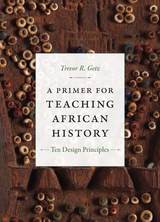 A Primer for Teaching African History: Ten Design Principles
Trevor R. Getz
Duke University Press, 2018 A Primer for Teaching African History is a guide for college and high school teachers who are teaching African history for the first time, for experienced teachers who want to reinvigorate their courses, for those who are training future teachers to prepare their own syllabi, and for teachers who want to incorporate African history into their world history courses. Trevor R. Getz offers design principles aimed at facilitating a classroom experience that will help students navigate new knowledge, historical skills, ethical development, and worldviews. He foregrounds the importance of acknowledging and addressing student preconceptions about Africa, challenging chronological approaches to history, exploring identity and geography as ways to access historical African perspectives, and investigating the potential to engage in questions of ethics that studying African history provides. In his discussions of setting goals, pedagogy, assessment, and syllabus design, Getz draws readers into the process of thinking consciously and strategically about designing courses on African history that will challenge students to think critically about Africa and the discipline of history.
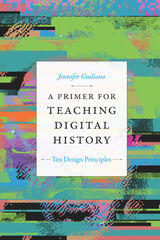 A Primer for Teaching Digital History: Ten Design Principles
Jennifer Guiliano
Duke University Press, 2022 A Primer for Teaching Digital History is a guide for college and high school teachers who are teaching digital history for the first time or for experienced teachers who want to reinvigorate their pedagogy. It can also serve those who are training future teachers to prepare their own syllabi, as well as teachers who want to incorporate digital history into their history courses. Offering design principles for approaching digital history that represent the possibilities that digital research and scholarship can take, Jennifer Guiliano outlines potential strategies and methods for building syllabi and curricula. Taking readers through the process of selecting data, identifying learning outcomes, and determining which tools students will use in the classroom, Guiliano outlines popular research methods including digital source criticism, text analysis, and visualization. She also discusses digital archives, exhibits, and collections as well as audiovisual and mixed-media narratives such as short documentaries, podcasts, and multimodal storytelling. Throughout, Guiliano illuminates how digital history can enhance understandings of not just what histories are told but how they are told and who has access to them.
 A Primer for Teaching Environmental History: Ten Design Principles
Emily Wakild and Michelle K. Berry
Duke University Press, 2018 A Primer for Teaching Environmental History is a guide for college and high school teachers who are teaching environmental history for the first time, for experienced teachers who want to reinvigorate their courses, for those who are training future teachers to prepare their own syllabi, and for teachers who want to incorporate environmental history into their world history courses. Emily Wakild and Michelle K. Berry offer design principles for creating syllabi that will help students navigate a wide range of topics, from food, environmental justice, and natural resources to animal-human relations, senses of place, and climate change. In their discussions of learning objectives, assessment, project-based learning, using technology, and syllabus design, Wakild and Berry draw readers into the process of strategically designing courses on environmental history that will challenge students to think critically about one of the most urgent topics of study in the twenty-first century.
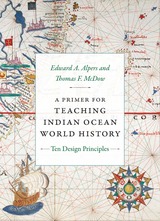 A Primer for Teaching Indian Ocean World History: Ten Design Principles
Edward A. Alpers and Thomas F. McDow
Duke University Press, 2024 A Primer for Teaching Indian Ocean World History is a guide for college and high school educators who are teaching Indian Ocean histories for the first time or who want to reinvigorate their courses. It can also serve those who are training future teachers to prepare their own syllabi, as well as those who want to incorporate Indian Ocean histories into their world history courses. Edward A. Alpers and Thomas F. McDow offer course design principles that will help students navigate topics ranging from empire, geography, slavery, and trade to mobility, disease, and the environment. In addition to exploring non-European sources and diverse historical methodologies, they discuss classroom pedagogy and provide curriculum possibilities that will help instructors at any level enrich and deepen standard approaches to world history. Alpers and McDow draw readers into strategically designing courses that will challenge students to think critically about a vast area with which many of them are almost entirely unfamiliar.
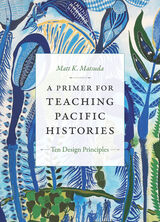 A Primer for Teaching Pacific Histories: Ten Design Principles
Matt K.Matsuda
Duke University Press, 2020 A Primer for Teaching Pacific Histories is a guide for college and high school teachers who are teaching Pacific histories for the first time or for experienced teachers who want to reinvigorate their courses. It can also serve those who are training future teachers to prepare their own syllabi, as well as teachers who want to incorporate Pacific histories into their world history courses. Matt K. Matsuda offers design principles for creating syllabi that will help students navigate a wide range of topics, from settler colonialism, national liberation, and warfare to tourism, popular culture, and identity. He also discusses practical pedagogical techniques and tips, project-based assignments, digital resources, and how Pacific approaches to teaching history differ from customary Western practices. Placing the Pacific Islands at the center of analysis, Matsuda draws readers into the process of strategically designing courses that will challenge students to think critically about the interconnected histories of East Asia, Southeast Asia, Australia, the Pacific Islands, and the Americas within a global framework.
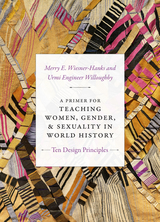 A Primer for Teaching Women, Gender, and Sexuality in World History: Ten Design Principles
Merry E. Wiesner-Hanks and Urmi Engineer Willoughby
Duke University Press, 2018 A Primer for Teaching Women, Gender, and Sexuality in World History is a guide for college and high school teachers who are teaching women, gender, and sexuality in history for the first time, for experienced teachers who want to reinvigorate their courses, for those who are training future teachers to prepare their own syllabi, and for teachers who want to incorporate these issues into their world history classes. Merry E. Wiesner-Hanks and Urmi Engineer Willoughby present possible course topics, themes, concepts, and approaches while offering practical advice on materials and strategies helpful for teaching courses from a global perspective in today's teaching environment for today's students. In their discussions of pedagogy, syllabus organization, fostering students' historical empathy, and connecting students with their community, Wiesner-Hanks and Willoughby draw readers into the process of strategically designing courses that will enable students to analyze gender and sexuality in history, whether their students are new to this process or hold powerful and personal commitments to the issues it raises.
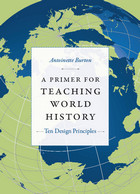 A Primer for Teaching World History: Ten Design Principles
Antoinette Burton
Duke University Press, 2012 A Primer for Teaching World History is a guide for college and high school teachers who are designing an introductory-level world history syllabus for the first time, for those who already teach world history and are seeking new ideas or approaches, and for those who train future teachers to prepare any history course with a global or transnational focus. Drawing on her own classroom practices, as well as her career as a historian, Antoinette Burton offers a set of principles to help instructors think about how to design their courses with specific goals in mind, whatever those may be. She encourages teachers to envision the world history syllabus as having an architecture: a fundamental, underlying structure or interpretive focus that runs throughout the course, shaping students' experiences, offering pathways in and out of "the global," and reflecting the teacher's convictions about the world and the work of history.
 Primer of Ecological Restoration
Karen D. Holl
Island Press, 2020 The pace, intensity, and scale at which humans have altered our planet in recent decades is unprecedented. We have dramatically transformed landscapes and waterways through agriculture, logging, mining, and fire suppression, with drastic impacts on public health and human well-being. What can we do to counteract and even reverse the worst of these effects? Restore damaged ecosystems.
The Primer of Ecological Restoration is a succinct introduction to the theory and practice of ecological restoration as a strategy to conserve biodiversity and ecosystems. In twelve brief chapters, the book introduces readers to the basics of restoration project planning, monitoring, and adaptive management. It explains abiotic factors such as landforms, soil, and hydrology that are the building blocks to successfully recovering microorganism, plant, and animal communities. Additional chapters cover topics such as invasive species and legal and financial considerations. Each chapter concludes with recommended reading and reference lists, and the book can be paired with online resources for teaching.
Perfect for introductory classes in ecological restoration or for practitioners seeking constructive guidance for real-world projects, Primer of Ecological Restoration offers accessible, practical information on recent trends in the field.
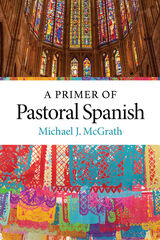 A Primer of Pastoral Spanish
Michael J. McGrath
Catholic University of America Press, 2022 A Primer of Pastoral Spanish is designed to provide clergy, religious and laity alike with the tools to be pastoral among Spanish-speaking people. This primer is modeled after Madrigal’s Magic Key to Spanish (1953), whose author, Margarita Madrigal, bases her methodology on creating with the language instead of memorizing it. Previous knowledge of Spanish is not necessary, although, as you will discover, you already know thousands of words in Spanish. The vocabulary you know in English is the foundation on which you can build your knowledge of Spanish vocabulary. There are thousands of English words that become Spanish words if you can recognize the slight change that takes place from one language to the other. For example, you will learn how to conjugate a verb in Spanish to the first-person singular of the past tense by dropping a letter from its translation in English and adding an accent. There are 40 units in this primer. If you were to study each unit 30 minutes a day throughout Lent, for example, think about how far you could progress. Each unit consists of four sections: Vocabulary, Prayer or Culture, Cornerstones, and Vocabulary Review. There are four Check Your Progress units. These present more Challenges based on the grammar, vocabulary, and culture you learned in the previous units. The answers to the Challenges are at the end of these units.
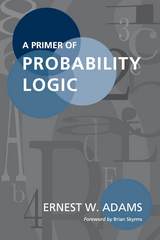 A Primer of Probability Logic
Ernest W. Adams
CSLI, 1996 This book is meant to be a primer, that is, an introduction, to probability logic, a subject that appears to be in its infancy. Probability logic is a subject envisioned by Hans Reichenbach and largely created by Adams. It treats conditionals as bearers of conditional probabilities and discusses an appropriate sense of validity for arguments such conditionals, as well as ordinary statements as premisses. This is a clear well-written text on the subject of probability logic, suitable for advanced undergraduates or graduates, but also of interest to professional philosophers. There are well-thought-out exercises, and a number of advanced topics treated in appendices, while some are brought up in exercises and some are alluded to only in footnotes. By this means, it is hoped that the reader will at least be made aware of most of the important ramifications of the subject and its tie-ins with current research, and will have some indications concerning recent and relevant literature.
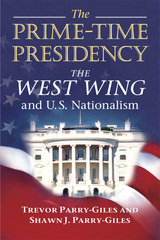 The Prime-Time Presidency: The West Wing and U.S. Nationalism
Trevor Parry-Giles and Shawn J. Parry-Giles
University of Illinois Press, 2010 Contrasting strong women and multiculturalism with portrayals of a heroic white male leading the nation into battle, The Prime-Time Presidency explores the NBC drama The West Wing, paying particular attention to its role in promoting cultural meaning about the presidency and U.S. nationalism. Based in a careful, detailed analysis of the "first term" of The West Wing's President Josiah Bartlet, this criticism highlights the ways the text negotiates powerful tensions and complex ambiguities at the base of U.S. national identity--particularly the role of gender, race, and militarism in the construction of U.S. nationalism. Unlike scattered and disparate collections of essays, Trevor Parry-Giles and Shawn J. Parry-Giles offer a sustained, ideologically driven criticism of The West Wing. The Prime-time Presidency presents a detailed critique of the program rooted in presidential history, an appreciation of television's power as a source of political meaning, and television's contribution to the articulation of U.S. national identity.
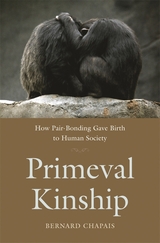 Primeval Kinship: How Pair-Bonding Gave Birth to Human Society
Bernard Chapais
Harvard University Press, 2008 At some point in the course of evolution—from a primeval social organization of early hominids—all human societies, past and present, would emerge. In this account of the dawn of human society, Bernard Chapais shows that our knowledge about kinship and society in nonhuman primates supports, and informs, ideas first put forward by the distinguished social anthropologist, Claude Lévi-Strauss.
Chapais contends that only a few evolutionary steps were required to bridge the gap between the kinship structures of our closest relatives—chimpanzees and bonobos—and the human kinship configuration. The pivotal event, the author proposes, was the evolution of sexual alliances. Pair-bonding transformed a social organization loosely based on kinship into one exhibiting the strong hold of kinship and affinity. The implication is that the gap between chimpanzee societies and pre-linguistic hominid societies is narrower than we might think.
Many books on kinship have been written by social anthropologists, but Primeval Kinship is the first book dedicated to the evolutionary origins of human kinship. And perhaps equally important, it is the first book to suggest that the study of kinship and social organization can provide a link between social and biological anthropology.
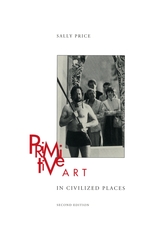 Primitive Art in Civilized Places: Second Edition
Sally Price
University of Chicago Press, 2002 What is so "primitive" about primitive art? And how do we dare to use our standards to judge it? Drawing on an intriguing mixture of sources-including fashion ads and films, her own anthropological research, and even comic strips like Doonesbury—Price explores the cultural arrogance implicit in Westerners' appropriation of non-Western art.
"[Price] presents a literary collage of the Western attitude to other cultures, and in particular to the visual art of the Third and Fourth Worlds. . . . Her book is not about works of 'primitive art' as such, but about the Western construction 'Primitive Art.' It is a critique of Western ignorance and arrogance: ignorance about other cultures and arrogance towards them."—Jeremy Coote, Times Literary Supplement
"The book is infuriating, entertaining, and inspirational, leaving one feeling less able than before to pass judgment on 'known' genres of art, but feeling more confident for that."—Joel Smith, San Francisco Review of Books
"[A] witty, but scholarly, indictment of the whole primitive-art business, from cargo to curator. And because she employs sarcasm as well as pedagogy, Price's book will probably forever deprive the reader of the warm fuzzies he usually gets standing before the display cases at the local ethnographic museum."—Newsweek
Primitive Classification
Emile Durkheim and Marcel Mauss
University of Chicago Press, 1967 Emile Durkheim and Marcel Mauss maintain that society is the source of the very categories of human thought. First published in the Année Sociologique in 1903, this classic essay has been translated by Rodney Needham, who also provides a critical introduction.
"[Primitive Classification] will impress the reader with its quiet elegance, its direct, logical form, its clarity of style, its spirit of careful, yet bold, exploration."—Harry Alpert, American Journal of Sociology
"Particularly instructive for anyone who wonders what social anthropology is: how, if at all, it differs from sociology and whether it has any unifying theoretical problem."—F. K. Lehman, American Sociological Review
Primitive Mentor
Dean Young
University of Pittsburgh Press, 2008 The ninth collection for this Pulitzer Prize finalist, who remains as entertaining, imaginative and inventive as ever.
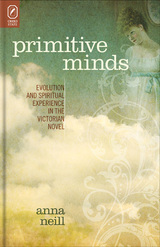 Primitive Minds: Evolution and Spiritual Experience in the Victorian Novel
Anna Neill
Ohio State University Press, 2013 For twenty-first-century veterans of the evolution culture wars, Primitive Minds: Evolution and Spiritual Experience in the Victorian Novel, by Anna Neill, makes unlikely bedfellows of two Victorian “discoveries”: evolutionary theory and spiritualism. Victorian science did much to uncover the physical substratum of mystical or dreamy experience, tracing spiritual states to a lower, reflex, or more evolutionarily primitive stage of consciousness. Yet science’s pursuit of knowledge beyond sense-based evidence uncannily evoked powers associated with this primitive mind: the capacity to link events across space and time, to anticipate the future, to uncover elements of the forgotten past, and to see into the minds of others. Neill does not ask how the Victorians explained away spiritual experience through physiological psychology, but instead explores how physical explanation interacted with dreamy content in Victorian accounts of the mind’s most exotic productions. This synthesis, she argues, was particularly acute in realist fiction, where, despite novelists’ willingness to trace the nervous origins of individual behavior and its social consequences, activity in hidden regions of the mind enabled levels of perception inaccessible to ordinary waking thought. The authors in her study include Charlotte Brontë, Charles Dickens, George Eliot, Arthur Conan Doyle, and Thomas Hardy.
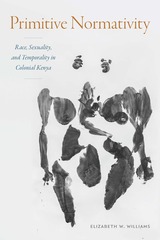 Primitive Normativity: Race, Sexuality, and Temporality in Colonial Kenya
Elizabeth W. Williams
Duke University Press, 2024 In Primitive Normativity Elizabeth W. Williams traces the genealogy of a distinct narrative about African sexuality that British colonial authorities in Kenya used to justify their control over indigenous populations. She identifies a discourse of “primitive normativity” that suggested that Africans were too close to nature to develop sexual neuroses and practices such as hysteria, homosexuality, and prostitution which supposedly were common among Europeans. Primitive normativity framed Kenyan African sexuality as less polluted than that of the more deviant populations of their colonizers. Williams shows that colonial officials and settlers used this narrative to further the goals of white supremacy by arguing that Africans’ sexuality was proof that Kenyan Africans must be protected from the forces of urbanization, Western-style education, and political participation, lest they be exposed to forms of civilized sexual deviance. Challenging the more familiar notion that Europeans universally viewed Africans as hypersexualized, Williams demonstrates how narratives of African sexual normativity rather than deviance reinforced ideas about the evolutionary backwardness of African peoples and their inability to govern themselves.
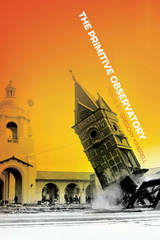 The Primitive Observatory
Gregory Kimbrell
Southern Illinois University Press, 2016 The poems of The Primitive Observatory, set roughly in the Gilded Age, take readers into a dreamy, alluring world where hapless travelers, doomed heirs, and other colorful types grapple with horrors. Within the pages of this book, we find a group of cousins who wager their pets in endless games of mahjong, a village whose inhabitants all dream the same dreams, and Maurice, who watches Greta Garbo movies while waiting for death in the macabre home of his grandfather, a man suspected of sinister hypnosis and unspeakable crimes.
Kimbrell explores such themes as memory, class prejudice, family violence, and greed in a flamboyant, yet matter-of-fact style to create verse that is both amusing and unsettling. Combining prose that evokes H. P. Lovecraft, classical mythology, and Marcel Proust with the look and taut line of traditional formalist verse, the poems appear on the page as perfect rectangles, yet revel in narrative and linguistic absurdities.
The Primitive Observatory offers a dark and evocative experience through the tangible grotesque. Fans of David Lynch, Franz Kafka, Edward Gorey and the like will be startled, excited, and pleased by this entertaining and disturbing book of poetry.
 Primitive Passions: Men, Women, and the Quest for Ecstasy
Marianna Torgovnick
University of Chicago Press, 1998 Marianna Torgovnick's Primitive Passions investigates Westerners' profound attraction to cultures that we call "primitive." Torgovnick explores the stories of Carl Jung, Isak Dinesen, D. H. Lawrence, and Georgia O'Keefe and the ways they used the primitive as a medium for soul-searching and personal fulfillment. Brilliantly linking literature, art, psychology, and cultural studies, Primitive Passions provides insight into our very notion of the exotic.
"Primitive Passions intends to provoke thought, not to tell you what you already know and for that reason alone it's extraordinary."—Walter Kendrick, New York Times Book Review
"A powerfully argued, impassioned, and intelligent exploration of the 'primitive' in our culture and in ourselves. Like Marianna Torgovnick's previous work, it is certain to be much discussed and provocative."—Joyce Carol Oates
"An inspiring effort to bring gender to bear on matters of race, ethnic identity, and spirituality."—Susan Gubar
"A fascinating, wide-ranging and provocative tour of twentieth century Western culture."—Cynthia D. Schrager, Women's Review of Books
Primitive Polluters: Semang Impact on the Malaysian Tropical Rain Forest Ecosystem
A. Terry Rambo
University of Michigan Press, 1985 In the 1970s, A. Terry Rambo conducted fieldwork in Peninsular Malaysia with a group of Semang people. The community he studied had a seminomadic lifestyle: at times they stayed in houses or lean-tos in a village, and at other times they foraged in the surrounding rain forest for food. Rambo’s goal was to assess this group’s impact on the local environment. He found that, through domestic fires and cigarette smoking, they caused significant air pollution at the household level, but because of their small population size, they did not have much of an ecological impact.
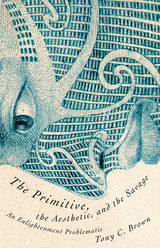 The Primitive, the Aesthetic, and the Savage: An Enlightenment Problematic
Tony C. Brown
University of Minnesota Press, 2012 Tony C. Brown examines “the inescapable yet infinitely troubling figure of the not-quite-nothing” in Enlightenment attempts to think about the aesthetic and the savage. The various texts Brown considers—including the writings of Addison, Rousseau, Kant, and Defoe—turn to exotic figures in order to delimit the aesthetic, and to aesthetics in order to comprehend the savage. In his intriguing exploration Brown discovers that the primitive introduces into the aesthetic and the savage an element that proves necessary yet difficult to conceive. At its most profound, Brown explains, this element engenders a loss of confidence in one’s ability to understand the human’s relation to itself and to the world. That loss of confidence—what Brown refers to as a breach in anthropological security—traces to an inability to maintain a sense of self in the face of the New World. Demonstrating the impact of the primitive on the aesthetic and the savage, he shows how the eighteenth-century writers he focuses on struggle to define the human’s place in the world. As Brown explains, these authors go back again and again to “exotic” examples from the New World—such as Indian burial mounds and Maori tattooing practice—making them so ubiquitous that they come to underwrite, even produce, philosophy and aesthetics.
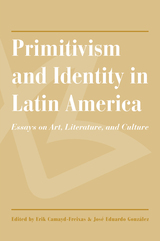 Primitivism and Identity in Latin America: Essays on Art, Literature, and Culture
Erik Camayd-Freixas
University of Arizona Press, 2000 Although primitivism has received renewed attention in recent years, studies linking it with Latin America have been rare. This volume examines primitivism and its implications for contemporary debates on Latin American culture, literature, and arts, showing how Latin American subjects employ a Western construct to "return the gaze" of the outside world and redefine themselves in relation to modernity. Examining such subjects as Julio Cortázar and Frida Kahlo and such topics as folk art and cinema, the volume brings together for the first time the views of scholars who are currently engaging the task of cultural studies from the standpoint of primitivism. These varied contributions include analyses of Latin American art in relation to social issues, popular culture, and official cultural policy; essays in cultural criticism touching on ethnic identity, racial politics, women's issues, and conflictive modernity; and analytical studies of primitivism's impact on narrative theory and practice, film, theater, and poetry. This collection contributes offers a new perspective on a variety of significant debates in Latin American cultural studies and shows that the term primitive does not apply to these cultures as much as to our understanding of them. CONTENTS Paradise Subverted: The Invention of the Mexican Character / Roger Bartra Between Sade and the Savage: Octavio Paz’s Aztecs / Amaryll Chanady Under the Shadow of God: Roots of Primitivism in Early Colonial Mexico / Delia Annunziata Cosentino Of Alebrijes and Ocumichos: Some Myths about Folk Art and Mexican Identity / Eli Bartra Primitive Borders: Cultural Identity and Ethnic Cleansing in the Dominican Republic / Fernando Valerio-Holguín Dialectics of Archaism and Modernity: Technique and Primitivism in Angel Rama’s Transculturación narrativa en América Latina / José Eduardo González Narrative Primitivism: Theory and Practice in Latin America / Erik Camayd-Freixas Narrating the Other: Julio Cortázar’s "Axolotl" as Ethnographic Allegory / R. Lane Kauffmann Jungle Fever: Primitivism in Environmentalism; Rómulo Gallegos’s Canaima and the Romance of the Jungle / Jorge Marcone Primitivism and Cultural Production: Future’s Memory; Native Peoples’ Voices in Latin American Society / Ivete Lara Camargos Walty Primitive Bodies in Latin American Cinema: Nicolás Echevarría’s Cabeza de Vaca / Luis Fernando Restrepo Subliminal Body: Shamanism, Ancient Theater, and Ethnodrama / Gabriel Weisz Primitivist Construction of Identity in the Work of Frida Kahlo / Wendy B. Faris Mi andina y dulce Rita: Women, Indigenism, and the Avant-Garde in César Vallejo / Tace Megan Hedrick
Primitivism in Modern Art
Robert Goldwater
Harvard University Press, 1986 This now classic study maps the profound effect of primitive art on modern, as well as the primitivizing strain in modern art itself. Robert Goldwater describes how and why works by primitive artists attracted modern painters and sculptors, and he delineates the differences between what is truly primitive or archaic and what intentionally embodies such elements. His analysis distinguishes the romanticism of Gauguin; an emotional primitivism exemplified by the Brücke and Blaue Reiter groups in Germany; the intellectual primitivism of Picasso and Modigliani; and a “primitivism of the subconscious” in Miró, Klee, and Dali. Two of Goldwater’s related essays—“Judgments of Primitive Art, 1905–1965” and “Art History and Anthropology”—have been added for this new paperback edition.
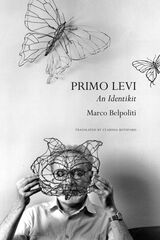 Primo Levi: An Identikit
Marco Belpoliti
Seagull Books, 2022 Drawing on twenty years of research, this is the definitive biography of Primo Levi.
Over the last seventy years, Primo Levi (1919–87) has been recognized as the foremost literary witness of the extermination of the European Jews. In Primo Levi: An Identikit, a product of twenty years of research, Marco Belpoliti explores Levi’s tormented life, his trajectory as a writer and intellectual, and, above all, his multifaceted and complex oeuvre.
Organized in a mosaic format, this volume devotes a different chapter to each of Levi’s books. In addition to tracing the history of each book’s composition, publication, and literary influences, Belpoliti explores their contents across the many worlds of Primo Levi: from chemistry to anthropology, biology to ethology, space flights to linguistics. If This Is a Man, his initially rejected masterpiece, is also reread with a fresh perspective. We learn of dreams, animals, and travel; of literary writing, comedy, and tragedy; of shame, memory, and the relationship with other writers such as Franz Kafka and Georges Perec, Jean Améry and Varlam Shalamov. Fundamental themes such as Judaism, the camp, and testimony innervate the book, which is complemented by photographs and letters found by the author in hitherto unexplored archives.
This will be the definitive book on Primo Levi, a treasure trove of stories and reflections that paint a rich, nuanced composite portrait of one of the twentieth century’s most unique and urgent voices.
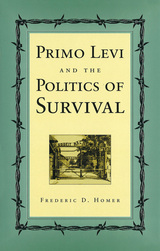 Primo Levi and the Politics of Survival
Frederic D. Homer
University of Missouri Press, 2001
At the age of twenty-five, Primo Levi was sent to Hell. Levi, an Italian chemist from Turin, was one of many swept up in the Holocaust of World War II and sent to die in the German concentration camp in Auschwitz. Of the 650 people transported to the camp in his group, only 15 men and 9 women survived. After Soviet liberation of the camp in 1945, Levi wrote books, essays, short stories, poetry, and a novel, in which he painstakingly described the horrors of his experience at Auschwitz. He also spent the rest of his life struggling with the fact that he was not among those who were killed.
In Primo Levi and the Politics of Survival, Frederic D. Homer looks at Primo Levi's life but, more important, shows him to be a significant political philosopher. In the course of his writings, Levi asked and answered his most haunting question: can someone be brutalized by a terrifying experience and, upon return to "ordinary life," recover from the physical and moral destruction he has suffered? Levi used this question to develop a philosophy positing that although man is no match for life, he can become better prepared to contend with the tragedies in life.
According to Levi, the horrors of the world occur because of the strength of human tendencies, which make relationships between human beings exceedingly fragile. He believed that we are ill-constituted beings who have tendencies toward violence and domination, dividing ourselves into Us and Them, with very shallow loyalties. He also maintained that our only refuge is in education and responsibility, which may counter these tendencies. Homer calls Levi's philosophy "optimistic pessimism."
As Homer demonstrates, Levi took his past experiences into account to determine that goodwill and democratic institutions do not come easily to people. Liberal society is to be earned through discipline and responsibility toward our weaknesses. Levi's answer is "civilized liberalism." To achieve this we must counter some of our most stubborn tendencies.
Homer also explores the impact of Levi's death, an apparent suicide, on the way in which his work and theories have been perceived. While several critics discount Levi's work because of the nature of his death, Homer argues that his death is consistent with his philosophy. A book rich in brutally honest philosophy, Primo Levi and the Politics of Survival compels one to look at serious questions about life, tragedy, optimism, solidarity, violence, and human nature.
 Prince Charoon et al: South East Asia
Andrew Dalby
Haus Publishing, 2010 Southeast Asia needs to be dealt with as a whole, because, although the one national delegation from the region (Siam) took a minor part, nationalist movements in several Southeast Asian countries reached an early climax - significant though inconclusive - in the years 1919-1920. The planned Peace Conference, Wilson's Fourteen Points, and the victory of Communism in Russia, all contributed to this activity, and in spite of national differences it needs to be seen as a whole. The focus of the book will be on developments around 1919; thus it will bring out for the first time the unexpected significance for South-east Asia of the 1919 milestone. It will also have a biographical bias - taking a special interest in the personalities of major figures in this important period, in order to show the influences and the patterns of thought that underlie their activities at the time of the Peace Conference. Following a brief introduction making the link between world events in 1919 and South-east Asia, the book sets the scene in the region. Succeeding chapters deal with the five countries - Siam, Vietnam, Burma, Indonesia, Philippines - in which the years 1919-21 were of special significance, as well as the impact of the peace conferences in relationships with their neighbours, the growth of international Communism and global politics in later years.
 Prince, Musical Genre, and the Construction of Racial Identity
Griffin Woodworth
University of Michigan Press, 2025 Throughout his career, the Minneapolis musician Prince was known for fusing different musical genres as well as moving between different identities—sexual lothario, devout man of God, androgynous sprite—qualities that fit the postmodernism of the 1980s. This volume takes a fresh look at Prince’s work, arguing that his music was deeply informed by the history and techniques of Black culture, and that his multigenre fluency and changeable image were weapons that he deployed in a career-long fight against the racially segregated structures of the American music industry. Using a methodology that mixes musicology with African American literary theory, queer theory, and gender studies, this book analyzes the ways that Prince mixed and manipulated musical genres that are indexed to racial identities—such as “White” rock or new-wave, and “Black” funk, gospel, or R&B—in order to construct pluralistic identities.
Each chapter includes detailed musical analyses and transcriptions of Prince’s songs, focusing on his use of rock guitar, new-wave synthesizers, funk drumming, gospel singing, and R&B horns. By tracking Prince’s transformations of instrumental and vocal idioms derived from specific musical genres, and considering the historical and cultural values embedded within those genres, Griffin Woodworth explores the ways that Prince musically broke down stereotypes of Black masculinity. With its intersectional approach to musical analysis, this book captures the sounds of American racial politics in the 1980s, 90s, and 2000s as heard through the music of one of the era’s most popular artists as he worked to transform and transcend those politics.
The Prince Of Fire
Radmila Gorup
University of Pittsburgh Press, 1998
Winner of the 1998 Misha Djordjevic Award for the best book on Serbian culture in English.
Editors Gorup and Obradovic have collected stories from thirty-five outstanding writers in this first English anthology of Serbian fiction in thirty years. The anthology, representing a great variety of literary styles and themes, includes works by established writers with international reputations, as well as promising new writers spanning the generation born between 1930 and 1960. These stories may lead to a greater understanding of the current events in the former Yugoslavia.
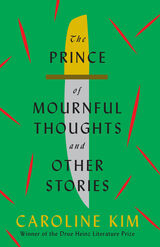 The Prince of Mournful Thoughts and Other Stories
Caroline Kim
University of Pittsburgh Press, 2020 Winner, 2020 Drue Heinz Literature Prize
Finalist, 2021 Northern California Book Award
Longlist, 2021 PEN/Robert Bingham Prize
Longlist, 2020 The Story Prize
Exploring what it means to be human through the Korean diaspora, Caroline Kim’s stories feature many voices. From a teenage girl in 1980’s America, to a boy growing up in the middle of the Korean War, to an immigrant father struggling to be closer to his adult daughter, or to a suburban housewife whose equilibrium depends upon a therapy robot, each character must face their less-than-ideal circumstances and find a way to overcome them without losing themselves. Language often acts as a barrier as characters try, fail, and momentarily succeed in connecting with each other. With humor, insight, and curiosity, Kim’s wide-ranging stories explore themes of culture, communication, travel, and family. Ultimately, what unites these characters across time and distance is their longing for human connection and a search for the place—or people—that will feel like home.
A Prince of Our Disorder: The Life of T. E. Lawrence
John E. Mack
Harvard University Press, 1998 When this Pulitzer Prize–winning biography first appeared in 1976, it rescued T.E. Lawrence from the mythologizing that had seemed to be his fate. In it, John Mack humanely and objectively explores the relationship between Lawrence’s inner life and his historically significant actions.
Extensive interviews, far-flung correspondence, access to War Office dispatches and unpublished letters provide the basis for Mack’s sensitive investigation of the psychiatric dimensions of Lawrence’s personality. In addition, Mack examines the pertinent history, politics, and sociology of the time in order to weigh the real forces with which Lawrence contended and which impinged upon him.
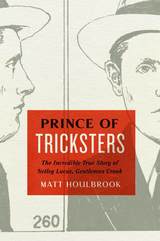 Prince of Tricksters: The Incredible True Story of Netley Lucas, Gentleman Crook
Matt Houlbrook
University of Chicago Press, 2016 Meet Netley Lucas, Prince of Tricksters—royal biographer, best-selling crime writer, and gentleman crook. In the years after the Great War, Lucas becomes infamous for climbing the British social ladder by his expert trickery—his changing names and telling of tales. An impudent young playboy and a confessed confidence trickster, he finances his far-flung hedonism through fraud and false pretenses. After repeated spells in prison, Lucas transforms himself into a confessing “ex-crook,” turning his inside knowledge of the underworld into a lucrative career as freelance journalist and crime expert. But then he’s found out again—exposed and disgraced for faking an exclusive about a murder case. So he reinvents himself, taking a new name and embarking on a prolific, if short-lived, career as a royal biographer and publisher. Chased around the world by detectives and journalists after yet another sensational scandal, the gentleman crook dies as spectacularly as he lived—a washed-up alcoholic, asphyxiated in a fire of his own making.
The lives of Netley Lucas are as flamboyant as they are unlikely. In Prince of Tricksters, Matt Houlbrook picks up the threads of Lucas’s colorful lies and lives. Interweaving crime writing and court records, letters and life-writing, Houlbrook tells Lucas’s fascinating story and, in the process, provides a panoramic view of the 1920s and ’30s. In the restless times after the Great War, the gentlemanly trickster was an exemplary figure, whose tall tales and bogus biographies exposed the everyday difficulties of knowing who and what to trust. Tracing how Lucas both evoked and unsettled the world through which he moved, Houlbrook shows how he prompted a pervasive crisis of confidence that encompassed British society, culture, and politics.
Taking readers on a romp through Britain, North America, and eventually into Africa, Houlbrook confronts readers with the limits of our knowledge of the past and challenges us to think anew about what history is and how it might be made differently.
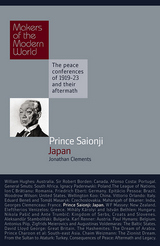 Prince Saionji: Japan
Jonathan Clements
Haus Publishing, 2010 Prince Saionji Kinmochi (1849-1940). The Japanese delegation at the Paris Peace Conference did not have the Japanese prime or foreign ministers with them as they had only just been elected and had plenty to do back home. The delegation was instead led by Prince Saionji, the dashing 'kingmaker' of early 20th-century Japanese politics whose life spanned the arrival of Commodore Perry and his 'black ships', the Japanese civil war, the Meiji Restoration, the Sino-Japanese War, the Russo-Japanese War, the First World War, the Paris Peace Conference and the Treaty of Versailles, and the rise of Japanese militarism. Unlike many of the conservatives of his day, Saionji was a man with experience of international diplomacy and admiration for European culture. Brought up in the days of the last Shogun, he became an active supporter of Japan's new ruling regime, after the Shogun was overthrown in a civil war, and a leading figure in the post-Restoration reform movement. In 1869 he founded the institution that would become the Ritsumeikan University - literally, 'The place to establish one's destiny'. He was sent to France for nine years to investigate Western technology and philosophy, and served for a decade as a Japanese ambassador in Europe. Returning to Japan, he served twice as Minister of Education and later became prime minister before resigning to become a revered elder statesman. Japan entered the First World War on the Allied side, seizing German possessions in China and the Pacific. In the closing days of the war, Japanese military forces participated in the Siberian Intervention - an American-led invasion of eastern Russia against Communist insurgents. At the Conference Saionji's presence was initially regarded by the Japanese as a sign that Japan had become a fully-fledged member of the international community and accepted on an equal footing with the Western Powers. His delegation introduced a controversial proposal to legally enshrine racial equality as one of the tenets of the League of Nations. The Japanese were also keen to grab colonies of their own, and went head-to-head with the Chinese delegation over the fate of the former German possession of Shandong. When Shandong was 'returned' not to China but to its Japanese occupiers, riots broke out in China. Despite Saionji's statesmanship and diplomacy, the Treaty of Versailles was regarded by many Japanese as a slap in the face. Saionji's influence weakened in his last years, while his party was dissolved and amalgamated with others.
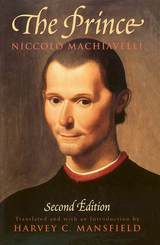 The Prince: Second Edition
Niccolò Machiavelli
University of Chicago Press, 1998 The most famous and important book on politics ever written
The Prince remains as lively and shocking today as when it was written almost five hundred years ago. Initially denounced as a collection of sinister maxims and a recommendation of tyranny, it has more recently been defended as the first scientific treatment of politics as it is practiced rather than as it ought to be practiced. Harvey C. Mansfield's brilliant translation of this classic work, along with the new materials added for this edition, make it the definitive version of The Prince, indispensable to scholars, students, and those interested in the dark art of politics.
This revised edition of Mansfield's acclaimed translation features an updated bibliography, a substantial glossary, an analytic introduction, a chronology of Machiavelli's life, and a map of Italy in Machiavelli's time.
"Of the other available [translations], that of Harvey C. Mansfield makes the necessary compromises between exactness and readability, as well as providing an excellent introduction and notes."—Clifford Orwin, The Wall Street Journal
"Mansfield's work . . . is worth acquiring as the best combination of accuracy and readability."—Choice
"There is good reason to assert that Machiavelli has met his match in Mansfield. . . . [He] is ready to read Machiavelli as he demands to be read—plainly and boldly, but also cautiously."—John Gueguen, The Sixteenth Century Journal
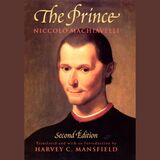 The Prince: Second Edition
Niccolò Machiavelli
University of Chicago Press, 1998 This is an auto-narrated audiobook version of this book.
The most famous book on politics ever written, The Prince remains as lively and shocking today as when it was written almost five hundred years ago. Initially denounced as a collection of sinister maxims and a recommendation of tyranny, it has more recently been defended as the first scientific treatment of politics as it is practiced rather than as it ought to be practiced. Harvey C. Mansfield's brilliant translation of this classic work, along with the new materials added for this edition, make it the definitive version of The Prince, indispensable to scholars, students, and those interested in the dark art of politics.
This revised edition of Mansfield's acclaimed translation features an updated bibliography, a substantial glossary, an analytic introduction, a chronology of Machiavelli's life, and a map of Italy in Machiavelli's time.
"Of the other available [translations], that of Harvey C. Mansfield makes the necessary compromises between exactness and readability, as well as providing an excellent introduction and notes."—Clifford Orwin, The Wall Street Journal
"Mansfield's work . . . is worth acquiring as the best combination of accuracy and readability."—Choice
"There is good reason to assert that Machiavelli has met his match in Mansfield. . . . [He] is ready to read Machiavelli as he demands to be read—plainly and boldly, but also cautiously."—John Gueguen, The Sixteenth Century Journal
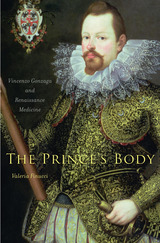 The Prince’s Body: Vincenzo Gonzaga and Renaissance Medicine
Valeria Finucci
Harvard University Press, 2015 Defining the proper female body, seeking elective surgery for beauty, enjoying lavish spa treatments, and combating impotence might seem like today’s celebrity infatuations. However, these preoccupations were very much alive in the early modern period. Valeria Finucci recounts the story of a well-known patron of arts and music in Renaissance Italy, Duke Vincenzo Gonzaga of Mantua (1562–1612), to examine the culture, fears, and captivations of his times. Using four notorious moments in Vincenzo’s life, Finucci explores changing concepts of sexuality, reproduction, beauty, and aging.
The first was Vincenzo’s inability to consummate his earliest marriage and subsequent medical inquiry, which elucidates new concepts of female anatomy. Second, Vincenzo’s interactions with Bolognese doctor Gaspare Tagliacozzi, the “father of plastic surgery,” illuminate contemporary fascinations with elective procedures. Vincenzo’s use of thermal spas explores the proliferation of holistic, noninvasive therapies to manage pain, detoxify, and rehabilitate what the medicine of the time could not address. And finally, Vincenzo’s search for a cure for impotence later in life analyzes masculinity and aging.
By examining letters, doctors’ advice, reports, receipts, and travelogues, together with (and against) medical, herbal, theological, even legal publications of the period, Finucci describes an early modern cultural history of the pathology of human reproduction, the physiology of aging, and the science of rejuvenation as they affected a prince with a large ego and an even larger purse. In doing so, she deftly marries salacious tales with historical analysis to tell a broader story of Italian Renaissance cultural adjustments and obsessions.
The Princes' Islands: Istanbul's Archipelago
Joachim Sartorius
Haus Publishing, 2023 Off the coast of Istanbul, in the Marmara Sea, lie the Princes Islands, an archipelago of unusual natural beauty, which has long been considered the maritime suburb of the imperial capital on the Bosporus and effectively shaped by its manifold history. The poet Joachim Sartorius draws a loving portrait of the landscape and the light, the political observer Sartorius describes the microcosm, which was always a reflection of Istanbul-Constantinople-Byzantium, while the novelist Sartorius introduces us to the characters, who inhabit this time capsule.
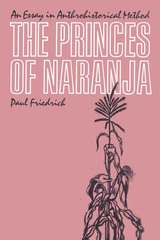 The Princes of Naranja: An Essay in Anthrohistorical Method
By Paul Friedrich
University of Texas Press, 1987 In this groundbreaking study, Paul Friedrich looks closely at the strong men of the Tarascan Indian village of Naranja: their leadership, friendship, kinship, and violent local politics (over a time depth of one generation), and ways to understand such phenomena. What emerges is an acutely observed portrait of the men who form the very basis of the grass-roots power structure in Mexico today. Of interest to historians, sociologists, and political scientists, as well as Latin Americanists and anthropologists, The Princes of Naranja is a sequel to Friedrich's now classic Agrarian Revolt in a Mexican Village. It begins with biographical character studies of seven leaders—peasant gunmen, judges, politicos; here the book will grip the reader and provoke strong emotional response, from laughter to horror. A middle section places these "princes" in relation to each other, and to the contexts of village society and the larger entities of which it forms a part. Friedrich's synthesis of anthropology, local (mainly oral) history, macrohistory, microsociology, psychology, and literature gives new insight into the structure of Mexican politics from the local level up, and provides a model for other scholars doing analogous work in other parts of the world, especially in the developing world. The concluding section raises vital questions about the dynamic relations between the fieldworker, fieldwork, field notes, the villagers, the writing of a fieldwork-based book, and, implicitly, the audience for such books.
 The Princess Nun: Bunchi, Buddhist Reform, and Gender in Early Edo Japan
Gina Cogan
Harvard University Press, 2014 The Princess Nun tells the story of Bunchi (1619–1697), daughter of Emperor Go-Mizunoo and founder of Enshōji. Bunchi advocated strict adherence to monastic precepts while devoting herself to the posthumous welfare of her family. As the first full-length biographical study of a premodern Japanese nun, this book incorporates issues of gender and social status into its discussion of Bunchi’s ascetic practice and religious reforms to rewrite the history of Buddhist reform and Tokugawa religion.
Gina Cogan’s approach moves beyond the dichotomy of oppression and liberation that dogs the study of non-Western and premodern women to show how Bunchi’s aristocratic status enabled her to carry out reforms despite her gender, while simultaneously acknowledging how that same status contributed to their conservative nature. Cogan’s analysis of how Bunchi used her prestigious position to further her goals places the book in conversation with other works on powerful religious women, like Hildegard of Bingen and Teresa of Avila. Through its illumination of the relationship between the court and the shogunate and its analysis of the practice of courtly Buddhism from a female perspective, this study brings historical depth and fresh theoretical insight into the role of gender and class in early Edo Buddhism.
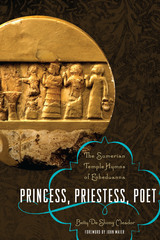 Princess, Priestess, Poet: The Sumerian Temple Hymns of Enheduanna
By Betty De Shong Meador
University of Texas Press, 2009 Living in 2300 BCE, Sumerian high priestess Enheduanna became the first author of historical record by signing her name to a collection of hymns written for forty-two temples throughout the southern half of ancient Mesopotamia, the civilization now known as Sumer. Each of her hymns confirmed to the worshipers in each city the patron deity’s unique character and significance. The collected hymns became part of the literary canon of the remarkable Sumerian culture and were copied by scribes in the temples for hundreds of years after Enheduanna’s death. Betty De Shong Meador offers here the first collection of original translations of all forty-two hymns along with a lengthy examination of the relevant deity and city, as well as an analysis of the verses themselves. She introduces the volume with discussions of Sumerian history and mythology, as well as with what is known about Enheduanna, thought to be the first high priestess to the moon god Nanna, and daughter of Sargon, founder of one of the first empires in human history.
The Princess who Hid in a Tree: An Anglo-Saxon Story
Jackie Holderness
Bodleian Library Publishing, 2019 A long time ago, there was a brave and kind Anglo-Saxon princess called Frideswide who lived in Oxford, England and just happened to be brilliant at climbing very tall trees. One day, when a wicked king tried to kidnap her, her talent came in useful. How did she and her friends escape, and what happened to the king and his soldiers who tried to take her?
With stunning illustrations by award-winning artist Alan Marks, the legend of Saint Frideswide, patron saint of Oxford, is retold for young children as a tale of adventure, courage in the face of danger, friendship, and kindness, with a few surprises along the way.
 Princesses Mary and Elizabeth Tudor and the Gift Book Exchange
Valerie Schutte
Arc Humanities Press, 2021 This is the first book to offer a comparison of these two famous Tudor queens as princesses, suggesting that their early lives need to be more closely examined together. It offers a detailed case study of the four extant dedications that Elizabeth Tudor wrote to accompany manuscript translations that she gave to Henry VIII, his then wife, Katherine Parr, and to Elizabeth's brother Edward (VI of England) as New Year’s gifts from 1545 to 1548. Additionally, it seeks to compare Elizabeth with her sister Mary, beginning with pre-accession dedications given to each of them, exploring two of Mary's own translations, moving to their typical patterns of New Year's gift giving, and ending on the textual transmission of their translations that were later published in 1548. It argues that Elizabeth’s dedications to her family, while participating in the tradition of giving books, were unique and in the dedications she intended not only to represent her loyalty but also to stabilize her position within the royal family.
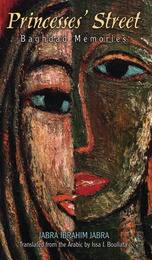 Princesses' Street: Baghdad Memories
Jabra Ibrahim Jabra
University of Arkansas Press, 2005 This book continues the personal story of Jabra Ibrahim Jabra (1920–1994) that began with The First Well: A Bethlehem Boyhood. Jabra was one of the Middle East’s leading novelists, poets, critics, painters, and translators (he was the first to translate The Sound and the Fury into Arabic), and is the writer who is given credit for modernizing the Arabic novel. This book not only helps us understand Jabra as a writer and human being but also his times in post–World War II Baghdad when Iraq was enjoying an unprecedented period of creativity in literature and the arts. As a bright and inquisitive young man he became friends with the archeologist Max Mallowan and his wife, who, he later learned, was Agatha Christie (she wrote The Mousetrap during this period, in a little mud brick room). Jabra’s intellectual autobiography quickly developed as he traveled to Jerusalem, Oxford, and Harvard University, where he studied with I. A. Richards and Archibald MacLeish. A number of different teaching posts in Baghdad provided him opportunities to become friends with many leading poets, such as Buland al-Haydari and Tawfiq Sayigh; historians like George Antonius; and the renowned translators of Arabic literature Desmond Stewart and Denys Johnson-Davies. But this book is not only about matters of the mind, it is about matters of the heart as well. Jabra beautifully describes his lengthy love affair with a young Muslim woman, the beautiful Lamica, whom he first met near Princesses’ Street and whom he eventually married. He recounts all of the difficulties they had to surmount, and the pleasures to be had. This is the last book that Jabra published during his lifetime. Not only is Jabra’s life an outstanding example of the circumstances—and fate—of the Palestinian in the twentieth century, but it also provides countless interesting insights into the cultural life of the Middle East in general and its modes of interconnection with the West.
The Principle of Duty: An Essay on the Foundations of the Civic Order
David Selbourne
University of Notre Dame Press, 2001 American edition of a British best seller
In The Principle of Duty, David Selbourne engages and challenges both the political left and the political right. He presents a new politics and ethics founded not upon rights but upon duties: the duties of the citizen to society and of society to the citizen.
 Principled Spying: The Ethics of Secret Intelligence
David Omand and Mark Phythian
Georgetown University Press, 2018 Intelligence agencies provide critical information to national security and foreign policy decision makers, but spying also poses inherent dilemmas for liberty, privacy, human rights, and diplomacy. Principled Spying explores how to strike a balance between necessary intelligence activities and protecting democratic values by developing a new framework of ethics. David Omand and Mark Phythian structure this book as an engaging debate between a former national security practitioner and an intelligence scholar. Rather than simply presenting their positions, throughout the book they pose key questions to each other and to the reader and offer contrasting perspectives to stimulate further discussion. They demonstrate the value for both practitioners and the public of weighing the dilemmas of secret intelligence through ethics. The chapters in the book cover key areas including human intelligence, surveillance, acting on intelligence, and oversight and accountability. The authors disagree on some key questions, but in the course of their debate they demonstrate that it is possible to find a balance between liberty and security. This book is accessible reading for concerned citizens, but it also delivers the sophisticated insights of a high-ranking former practitioner and a distinguished scholar.
Principled University Leadership: Critical Decision-Making in Academia
Marc A. Johnson
University of Nevada Press, 2025 Principled University Leadership: Critical Decision-Making in Academia is a personal account by university president Marc A. Johnson that draws on his extensive experience in academic administration. The book delves into four major themes: traits that lead individuals into leadership roles; economic principles influencing university decision-making; practical leadership strategies for fostering institutional progress; and approaches to navigating today’s critical challenges, including DEI and free speech.
Rooted in Johnson’s small-town origins and passion for civic engagement, this narrative offers unique insights into the path to university leadership and the key decisions leaders face. It is an invaluable resource for aspiring and current academic leaders seeking guidance in navigating the complexities of higher education.
Principles and Applications of Free Space Optical Communications
Arun K. Majumdar
The Institution of Engineering and Technology, 2019 Free Space Optical (FSO) Communication uses light propagation in free space (air, outer space, and vacuum) to wirelessly transmit data for telecommunications and communication networking. FSO Communication is a key wireless and high-bandwidth technology for high speed large-capacity terrestrial and aerospace communications, which is often chosen as a complement or alternative to radio frequency communication. The propagating optical wave can be influenced negatively by random atmospheric changes such as wind speed, temperature, relative humidity, and pressure, thermal expansion, earthquakes, and high-rise buildings. This edited book covers the principles, challenges, methodologies, techniques, and applications of Free Space Optical Communication for an audience of engineers, researchers, scientists, designers, and advanced students.
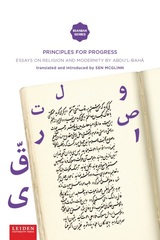 Principles for Progress: Essays on Religion and Modernity by `Abdu'l-Bahá
Translated and with an Introduction by Sen McGlinn
Leiden University Press, 2018 "This book presents three of the works of Abdu.l-Bah., son of the founder of the Bah..i Faith, dealing with social and political issues. In The Secret of Divine Civilization (1875) Abdu.l-Bah. supports the administrative and broader social reforms of Mirz. Hosayn Kh.n, but looks mainly for organic reform through the efforts of Iranian intellectuals to waken and educate the masses. In this work, Abdu.l-Bah. gives virtuous and progressive Islamic clerics a leading role among these intellectuals, indeed most of his appeals are directed specifically to them. A Traveller’s Narrative (1889/90) is an authoritative statement of the broad lines of Bah.’i social and political thinking. The Art of Governance (1892/93) was written as Iran entered a pre-revolutionary phase, and ideas that we recognise today as the precursors of political Islam were spreading. It sets out the principles underlying the ideal relationship between religion and politics and between the government and the people. In addition to presenting the first parallel text translations of these works, the Persian texts incorporate notes on variants in the early published sources. An introduction outlines the intellectual and political landscape from which Abdu.l-Bah. wrote, and in which his expected readers lived. "
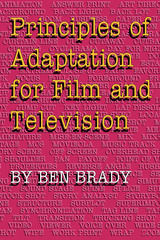 Principles of Adaptation for Film and Television
By Ben Brady
University of Texas Press, 1994 From All Quiet on the Western Front, the Academy Award-winning "Best Picture" of 1929-1930, to Dances with Wolves, the 1991 winner, many of Hollywood's most popular and enduring movies have been screen adaptations of written work, including novels, stories, and plays. In this practical, hands-on guide, veteran TV and screenwriter Ben Brady unlocks the secrets of the adaptation process, showing aspiring writers and writing teachers how to turn any kind of narrative material into workable, salable screenplays for film and television. Step by step, Brady guides novice screenwriters to the completion of a professional screenplay. He begins with an incisive discussion of how to evaluate a written work's potential as a screenplay. Then he discusses each step of the writing process, showing how to identify the plot and premise of the play, develop character, treatment, and dialogue, and handle camera language and format. Brady illustrates each of these points by developing and writing a complete screenplay of the novel Claire Serrat within the text. With these tools, beginning screenwriters can draw on the rich resources of words in print to create exciting screenplays for film and television. Written in vivid, entertaining prose, the book will be equally useful in the classroom or at the kitchen table, wherever enterprising writers ply their craft.
Principles of American Nuclear Chemistry: A Novel
Thomas McMahon
University of Chicago Press, 2003 What was life like for the scientists working at Los Alamos? Thomas McMahon imagines this life through the wide eyes of young Tim MacLaurin, the thirteen-year-old son of an MIT physicist who, inspired by a young woman named Maryann, worked on the project. Filled with the sensuous excitement of scientific discovery and the outrageous behavior of people pushed beyond their limits, Principles of American Nuclear Chemistry is a beautifully written coming-of-age story that explores the mysterious connections between love and work, inspiration and history.
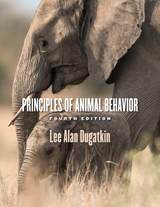 Principles of Animal Behavior, 4th Edition
Lee Alan Dugatkin
University of Chicago Press, 2020 Since the last edition of this definitive textbook was published in 2013, much has happened in the field of animal behavior. In this fourth edition, Lee Alan Dugatkin draws on cutting-edge new work not only to update and expand on the studies presented, but also to reinforce the previous editions’ focus on ultimate and proximate causation, as well as the book’s unique emphasis on natural selection, learning, and cultural transmission. The result is a state-of-the-art textbook on animal behavior that explains underlying concepts in a way that is both scientifically rigorous and accessible to students. Each chapter in the book provides a sound theoretical and conceptual basis upon which the empirical studies rest. A completely new feature in this edition are the Cognitive Connection boxes in Chapters 2–17, designed to dig deep into the importance of the cognitive underpinnings to many types of behaviors. Each box focuses on a specific issue related to cognition and the particular topic covered in that chapter.
As Principles of Animal Behavior makes clear, the tapestry of animal behavior is created from weaving all of these components into a beautiful whole. With Dugatkin’s exquisitely illustrated, comprehensive, and up-to-date fourth edition, we are able to admire that beauty anew.
 Principles of Animal Behavior, 5th Edition
Lee Alan Dugatkin
University of Chicago Press Incorporating essential revisions to reflect the latest scientific advancements, a celebrated author and scientist offers a leading textbook on animal behavior. So much has happened in the field of animal behavior since the last edition of this definitive textbook was published in 2020. In this fifth edition, Lee Alan Dugatkin continues to draw on cutting-edge new research not only to update and expand on the studies presented but also to reinforce the previous editions’ focus on ultimate and proximate causation as well as the book’s unique emphasis on natural selection, learning, and cultural transmission in nonhuman animals. The result is an essential update to the leading textbook on animal behavior that explains underlying concepts accessibly and with scientific rigor. Completely new features include: - Anthropogenic Connection Boxes. Humans are changing the planet. We are clearing forests, polluting the oceans, irrigating deserts, poisoning the soils, and driving a dramatic increase in global temperatures. All of these changes alter both the habitats where animals live and the species themselves as they evolve in response to our impact on their surroundings. Students will dig deep into how anthropogenic evolution affects animal behavior.
- Social Network Connection Boxes. Researchers have discovered that social networks play a critical role in almost every aspect of animal life: what they eat, how they protect themselves, who they mate with, the dynamics of parent-offspring relations, aggression, navigation, communication, play, cooperation, culture, and more. Students will discover how social network studies enrich our understanding of the wondrous complexity of animal behavior.
As Principles of Animal Behavior makes clear, the tapestry of animal behavior is created by weaving all of these components into a beautiful whole. In this lavishly illustrated, comprehensive, and up-to-date edition, we can admire that beauty anew.
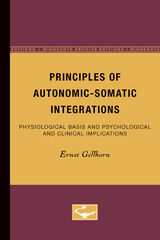 Principles of Autonomic-Somatic Integrations: Physiological Basis and Psychological and Clinical Implications
Ernst Gellhorn
University of Minnesota Press, 1967
Principles of Autonomic-Somatic Integrations was first published in 1967.For a number of years Dr. Gellhorn, a professor emeritus of neurophysiology at the University of Minnesota, conducted research on various problems stemming from the need for a better understanding of the autonomic nervous system. In this book he continues his contributions on the subject, providing a significant analysis of the relationship between the autonomic and somatic systems and the implications for medicine and psychology of the principles established. The book is based on an extensive review of the international literature, of which more than 1,000 references are cited.Dr. Gellhorn points out that research in the last two decades has shown that hypothalamic and reticular mechanisms play a fundamental role in the regulation of somatic sensory and motor functions as well as visceral functions. The role of such mechanisms in functions that represent fragments of behavior has been studied in great detail, and the importance of the mechanisms in the integration of diverse systems has been emphasized. He now suggests that a few basic principles are involved in the integration of a complex maze of organs and processes and that this integration results in a coherent pattern of total behavior. In the light of these principles he provides a broad physiological interpretation of behavior and explores various clinical implications.The book will be of particular interest to physiologists, neurologists, psychiatrists, and psychologists.
 Principles of Brownfield Regeneration: Cleanup, Design, and Reuse of Derelict Land
Justin B. Hollander, Niall G. Kirkwood, Julia L. Gold
Island Press, 2010 The US. EPA defines brownfields as "idle real property, the development or improvement of which is impaired by real or perceived contamination." The authors of Principles of Brownfield Regeneration argue that, compared to "greenfields"-farmland, forest, or pasturelands that have never been developed-brownfields offer a more sustainable land development choice. They believe that brownfields are central to a sustainable planning strategy of thwarting sprawl, preserving or regenerating open space, reducing greenhouse gas emissions, and reinvesting in urbanized areas.
This is the first book to provide an accessible introduction to the design, policy, and technical issues related to brownfield redevelopment. After defining brownfields and advocating for their redevelopment, the book describes the steps for cleaning up a site and creating viable land for development or open space. Land use and design considerations are addressed in a separate chapter and again in each of five case studies that make up the heart of the volume: The Steel Yard, Providence, RI; Assunpink Greenway, Trenton, NJ; June Key Community Center Demonstration Project, Portland, OR; Eastern Manufacturing Facility, Brewer, ME; and The Watershed at Hillsdale, Portland, OR. Throughout, the authors draw on interviews with people involved in brownfield projects as well as on their own considerable expertise.
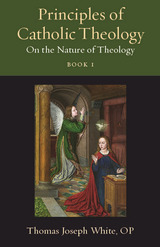 Principles of Catholic Theology, Book 1: On the Nature of Theology
Thomas Joseph White, OP
Catholic University of America Press, 2023 Catholic theology has to face a certain number of fundamental questions: what is the nature and content of Christian revelation, what are the sources of revelation, how are the mysteries of the faith to be understood in relation of one to another, and how do the truths of the Catholic faith relate to the acquisitions of natural reason. In the contemporary context, Catholic theology is marked by a diversity of approaches, many of which are seemingly incompatible or estranged from one another. How might we think about the unity of Catholic theology over and above the diversity of forms? What role, if any, can Aquinas play as a common doctor in facilitating exchanges between theological traditions in the Church?
Principles of Catholic Theology seeks to address directly the nature of Catholic theology and the challenge of its contemporary articulation with an eye towards its articulation in its Thomistic key. This book is also the first of a series of collections of essays by Thomas Joseph White, OP, extending over a range of fundamental topics in Catholic dogmatic theology.
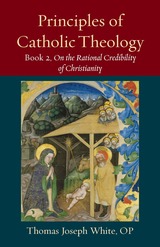 Principles of Catholic Theology, Book 2: On the Rational Credibility of Christianity
Thomas Joseph White, OP
Catholic University of America Press, 2023 Can a philosopher defend the rational warrant for belief in Christianity? Is it reasonable to be religious? Is it philosophically responsible to be a Christian who believes in the mystery of the Trinity? Principles of Catholic Theology explores these questions in a systematic way by considering questions of ultimate explanation. Why not hold that modern atheistic naturalism provides the best explanation of reality? Or, if there is a transcendent first principle that explains all of reality, is it impersonal rather than personal? Contrastingly, if monotheism constitutes the best explanation for created being, how can we reasonably believe in any particular revelation concerning God? What are the criteria for rational belief in revelation?
Thomas Joseph White, OP, considers these questions by exploring a series of topics: the transcendentals (existence, oneness, truth, goodness, beauty); rational argument for the existence of God; the immateriality and subsistence after death of the personal soul of the human being; the historical and conceptual coherence of Trinitarian doctrine; and the reasonableness of the natural desire to see God. The aim of Principles of Catholic Theology, Book 2 is to place contemporary natural reason in profound dialogue with the Catholic faith and to think about ways that we can consent to the profound mystery of the Holy Trinity that are in robust concord with the knowledge obtained from philosophical, scientific, and historical sources.
 Principles of Catholic Theology, Book 3: On God, Trinity, Creation, and Christ
Thomas Joseph White
Catholic University of America Press, 2024 What if anything can human beings know about God, either by way of philosophical reasoning or by divine revelation? How does the mystery of the Incarnation illuminate our understanding of the nature and mystery of God and the nature and destiny of the human person? The essays in this book explore topics pertaining to the nature of God, apophatic theology, divine simplicity and the holy Trinity, divine beauty, and the beauty of creation. The book also contains a series of speculative considerations of Christology: Why did God become human? How ought we understand the two natures of Christ and the topic of the communication of idioms (attribution of both divine and human properties to one person)? There is also a sustained treatment of Jesus' human knowledge and voluntary freedom. Did Jesus understand his own lordship and his unity with the Father and the Holy Spirit, and if so, how? Did Christ's human will always accord with the divine will, and what significance does this idea have for our understanding of the redemption affected by Christ for the whole human race? Through these explorations, principles drawn from Thomas Aquinas and from Thomistic tradition are taken into account as key resources for the adjudication of contemporary theological challenges.
Principles of Catholic Theology, Book 3 is a continuation of Fr. Thomas Joseph White's collection of essays, extending over a range of fundamental topics in Catholic dogmatic theology.
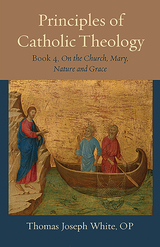 Principles of Catholic Theology, Book 4: On the Church, Mary, Nature and Grace
Thomas Joseph White
Catholic University of America Press, 2023 In the Nicene Creed Christians profess belief in the Church, "one, holy, catholic, and apostolic." The Church is also called the mystical body of Christ and the bride of Christ. What is the Church and how can we understand her mystery in light of the mystery of Christ? Principles of Catholic Theology, Book 4 explores Catholic ecclesiology and the theology of the Virgin Mary, as an exemplar of the Church's life. It also considers the people of Israel in light of the Church and Christ. The second half of the book considers human nature in light of the grace of Christ, and ecclesial humanity, so as to consider thematic and universal relations of grace to human nature. Major controversies are addressed such as the natural desire to see God and the Thomistic understanding of election and predestination. Effectively this volume seeks to receive and interpret the teaching of the Second Vatican Council Constitution on the Church, Lumen Gentium, within the Thomistic theological tradition and in light of that tradition.
Principles of Catholic Theology, Book 4 is a continuation of Fr. Thomas Joseph White's collection of essays, extending over a range of fundamental topics in Catholic dogmatic theology.
 Principles of Catholic Theology, Book 5: No One is More Human Than God: On the Trinitarian Presence of God in the World
Thomas Joseph White
Catholic University of America Press, 2026 This work explores a Christian understanding of God’s presence in the world. As the Creator of all that exists, the Creator-Trinity is mysteriously present to all things, and truly but imperfectly knowable as such. In addition to this creative presence, however, there is also the manifestation of God’s presence as a gift of grace. By supernatural faith, the trinitarian life of God is made known to us as an object of the Christian mystical life. This life is centered especially upon God’s unique presence by way of Incarnation, human life, death, and resurrection, in the person of Jesus of Nazareth. This work explores these notions in comparison with other religious traditions, in a Catholic as well as ecumenical perspective. Original considerations are offered regarding the nature of scriptural inspiration, the Church as the mystical body of Christ, and the sacraments as instrumental expressions of the Incarnation, all with a view to the notion of mystical experience, and union with God.
Principles of Catholic Theology, Book 5 is a continuation of Fr. Thomas Joseph White’s collection of essays, extending over a range of fundamental topics in Catholic dogmatic theology.
The Principles of Comedy Improv: Truths, Tales, and How to Improvise
Tom Blank
University of Iowa Press, 2023 The Principles of Comedy Improv is an authoritative handbook for beginners and experts alike. More than just entertainment, improv’s tenets enable you to change every moment of your life. Your guide is Tom Blank, who crystallizes two decades of experience to convey improv in unparalleled scope, depth, and fun.
Principles of Corporate Renewal
Harlan D. Platt
University of Michigan Press, 2023 Since its publication in 1998, this indispensable text has been the only systematic examination of corporate renewal, offering a rational approach for dealing with financially distressed companies. It contains the first logical and orderly discussion of a number of modern business issues including outsourcing, turnaround management, layoffs, quality management, and reengineering.
Now in its third edition, Harlan D. Platt has revised, updated, and expanded the text. As the first edition did, this new Principles of Corporate Renewal cuts to the heart of the patterns, procedures, and pitfalls of bringing a corporation back to life and health.
Principles of Corporate Renewal, Second Edition
Harlan D. Platt
University of Michigan Press, 2004 Since its publication in 1998, this indispensable text has been the only systematic examination of corporate renewal, offering a rational approach for dealing with financially distressed companies. It contains the first logical and orderly discussion of a number of modern business issues including outsourcing, turnaround management, layoffs, quality management, and reengineering.
Now in its second edition, Harlan D. Platt has revised, updated, and expanded the text to include a new chapter on bankruptcy law, a profile of the turnaround manager, and an overview of the typical turnaround engagement. As the first edition did, this new Principles of Corporate Renewal cuts to the heart of the patterns, procedures, and pitfalls of bringing a corporation back to life and health.
 Principles of Dental Public Health: Fourth Edition
James Morse Dunning
Harvard University Press, 1986 Since the publication seven years ago of the third edition of this classic work, there have been rapid changes in the field of dental public health. A sharp drop in childhood tooth decay in developed countries has resulted from the fluoridation of drinking water. Budget cuts in governmental dental care programs have brought increased emphasis to the need for auxiliaries as responsible members of the dental team.
This new edition presents a complete and up-to-date treatment of the tools of dental public health, including biostatistics, epidemiology, and the social sciences. James Morse Dunning provides a concise discussion of survey and evaluation methods and of techniques for the design of delivery programs for dental care. He evaluates the impact of the increasing demand for adult and geriatric dentistry. In response to the critical need for cost-efficient dental care, Dunning goes beyond most dental organizations of the day to advocate the use of well-trained paradental personnel under the general supervision of dentists.
Principles of Ecological Landscape Design
Travis Beck
Island Press, 2013 Today, there is a growing demand for designed landscapes—from public parks to backyards—to be not only beautiful and functional, but also sustainable. With Principles of Ecological Landscape Design, Travis Beck gives professionals and students the first book to translate the science of ecology into design practice.
This groundbreaking work explains key ecological concepts and their application to the design and management of sustainable landscapes. It covers topics from biogeography and plant selection to global change. Beck draws on real world cases where professionals have put ecological principles to use in the built landscape. For constructed landscapes to perform as we need them to, we must get their underlying ecology right. Principles of Ecological Landscape Design provides the tools to do just that.
 Principles of Geoarchaeology: A North American Perspective
Michael R. Waters
University of Arizona Press, 1992 Geoarchaeological studies can significantly enhance interpretations of human prehistory by allowing archaeologists to decipher from sediments and soils the effects of earth processes on the evidence of human activity. While a number of previous books have provided broad geographic and temporal treatments of geoarchaeology, this new volume presents a single author's view intended for North American archaeologists. Waters deals with those aspects of geoarchaeology—stratigraphy, site formation processes, and landscape reconstruction—most fundamental to archaeology, and he focuses on the late Quaternary of North America, permitting in-depth discussions of the concepts directly applicable to that research. Assuming no prior geologic knowledge on the part of the reader, Waters provides a background in fundamental geological processes and the basic tools of geoarchaeology. He then proceeds to relate specific physical processes, microenvironments, deposits, and landforms associated with riverine, desert, lake, glacial, cave, coastal, and other environments to archaeological site formation, location, and context. This practical volume illustrates the contributions of geoarchaeological investigations and demonstrates the need to make such studies an integral part of archaeological research. The text is enhanced by more than a hundred line drawings and photographs.
CONTENTS
1. Research Objectives of Geoarchaeology
2. Geoarchaeological Foundations: The Archaeological Site Matrix: Sediments and Soils / Stratigraphy / The Geoarchaeological Interpretation of Sediments, Soils, and Stratigraphy
3. Alluvial Environments: Streamflow / Sediment Erosion, Transport, and Deposition / Alluvial Environments: Rivers, Arroyos, Terraces, and Fans / Alluvial Landscapes Evolution and the Archaeological Record / Alluvial Landscape Reconstruction
4. Eolian Environments: Sediment Erosion, Transport, and Deposition / Sand Dunes / Loess and Dust / Stone Pavements / Eolian Erosion / Volcanic Ash (Tephra)
5. Springs, Lakes, Rockshelters, and Other Terrestrial Environments: Springs / Lakes / Slopes / Glaciers / Rockshelters and Caves
6. Coastal Environments: Coastal Processes / Late Quaternary Sea Level Changes / Coastal Environments / Coastal Landscape Evolution and the Archaeological Record / Coastal Landscape Reconstruction
7. The Postburial Disturbance af Archaeological Site Contexts: Cryoturbation / Argilliturbation / Graviturbation / Deformation / Other Physical Disturbances / Floralturbation / Faunalturbation
8. Geoarchaeological Research
Appendix A: Geoarchaeological Studies Illustrating the Effects of Fluvial Landscape Evolution on the Archaeological Record
Appendix B: Geoarchaeological Studies Illustrating Site-Specific Synchronic and Diachronic Alluvial Landscape Reconstructions
Appendix C: Geoarchaeological Studies Illustrating Regional Synchronic and Diachronic Alluvial Landscape Reconstructions
Principles of Geology, Volume 1
Charles Lyell
University of Chicago Press, 1990 As important to modern world views as any work of Darwin, Marx, or Freud, Principles of Geology is a landmark in the history of science. In this first of three volumes, Charles Lyell (1797-1875) sets forth his powerful uniformitarian argument: processes now visibly acting in the natural world are essentially the same as those that have acted throughout the history of the earth, and are sufficient to account for all geological phenomena.
Martin J. S. Rudwick's new Introduction, summarizing the origins of the Principles, guides the reader through the structure of the entire three-volume first edition and considers the legacy of Lyell's great work.
Principles of Geology, Volume 2
Charles Lyell
University of Chicago Press, 1991 As important to modern world views as any work of Darwin, Marx, or Freud, Lyell's Principles of Geology has never before been available in paperback. In the second of three volumes, Lyell (1797-1875) continues his uniformitarian argument of Volume I—the physical features of the earth are endlessly fluctuating around a stable mean—but focuses on organic rather than inorganic processes. Volume II is widely known because of its influence on Darwin, who took the book on his famous Beagle voyage and was stimulated by Lyell's extensive treatment of biological history and diversity.
Principles of Geology, Volume 3
Charles Lyell
University of Chicago Press, 1991 As important to modern world views as any work of Darwin, Marx, or Freud, Lyell's Principles of Geology has never before been available in paperback. In this third and final volume, Charles Lyell (1797-1875) devotes much attention to the "syntax of geology," that is, to a way of reconstructing the geological past on the basis of the "grammar" of the present processes he has described in the earlier volumes. He defines four periods of the Tertiary—Newer Pliocene, Older Pliocene, Miocene, and Eocene—and argues that the deposits dating from each period demonstrate the uniformity of processes and environments throughout the Tertiary, and indeed in earlier periods of earth history.
Martin J. S. Rudwick has compiled a bibliography giving full references for the sources Lyell cites in all three volumes of the Principles.
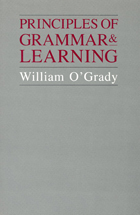 Principles of Grammar and Learning
William O'Grady
University of Chicago Press, 1987 Principles of Grammar and Learning is concerned with the nature of linguistic competence and with the cognitive structures underlying its acquisition and use. During the past several decades many linguists and psychologists have come to the conclusion that genetically determined categories and principles specific to language are needed to account for the form and acquisition of grammatical systems. William O'Grady argues here for quite a different conclusion, proposing that adequate grammars can be constructed from a conceptual base not specific to language.
To support this thesis, O'Grady develops a well-articulated, single level, categorial-type grammar that he uses to analyze syntactic categories, extraction, anaphora, extraposition, and quantifier placement in English and other languages. He shows that such grammars can be constructed via general learning strategies from notions such as dependency, adjacency, precedence, and continuity, and that the available acquisition data points to the emergence of the principles he proposes.
While exploratory, this book provides one of the few serious attempts to develop a theory of grammar and learning that does not posit faculty-specific innate principles. Principles of Grammar and Learning is an exemplary attempt to bring together issues and data from syntactic theory, language acquisition, and the more general study of the human mind.
 Principles of Green Bioethics: Sustainability in Health Care
Cristina Richie
Michigan State University Press, 2019 Health care is ubiquitous in the industrialized world. Yet, every medical development, technique, and procedure impacts the environment. Green bioethics synthesizes environmental ethics and biomedical ethics, thus creating an interdisciplinary approach to sustainable health care. Notably, green bioethics addresses not the structure of environmental sustainability in health-care institutions but the sustainability of individual health-care offerings. It parallels traditional biomedical ethics by providing four principles for ethical guidance: distributive justice, resource conservation, simplicity, and ethical economics. Through these four principles, green bioethics presents a coherent framework for evaluating the sustainability of medical developments, techniques, and procedures. The future of our world may very well depend on how effectively we halt ecological destruction and conserve our resources in all areas of life. The principles of green bioethics, outlined in this book, will advance sustainability in health care.
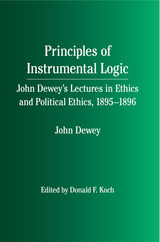 Principles of Instrumental Logic: John Dewey's Lectures in Ethics and Political Ethics, 1895-1896
Donald F. Koch
Southern Illinois University Press, 1998 John Dewey delivered two sets of related lectures at the University of Chicago in the fall quarter 1895 and the spring quarter 1896. Designed for graduate students, the lectures show the birth of Dewey’s instrumentalist theory of inquiry in its application to ethical and political thinking. From 1891 through 1903, Dewey attempted to develop a revolutionary experimentalist approach to ethical inquiry, designed to replace the more traditional ways of moral theorizing that relied on the fixed moral knowledge given in advance of the situations in which they were applied. In the lectures on the logic of ethics, he sets forth and defends the view that the "is" in a moral judgment such as "This is good" is a coordinating factor in an inquiry. Although the subject matter of the lectures is highly technical, its significance is paramount. It provides the key to and opens the door for a theory that preserves the difference between strictly scientific inquiry and moral inquiry even while it provides a "scientific treatment" of the latter.
Principles of Intensive Psychotherapy
Frieda Fromm-Reichmann
University of Chicago Press, 1960 "[This book has] a wealth of clinical and technical detail. As a primer on psychotherapeutic technique this book will. . .bring knowledge and stimulation to the most advanced technician"—Karl A. Menninger
"One is continuously aware that here is a truly human being at work, human in the sense of exquisite awareness, on a profoundly intuitive level, of the workings of the human totality. . . . Because of this she can bridge the vast divide that separates us from the psychotic . . . thereby gaining access to the process of recalling the patient to his lost domain."—Louise E. DeRosis, M.D., American Journal of Psychoanalysis
|
|


